USyd to Ukraine, Redfern to Rwanda, JFR to Jalalabad
George Gittoes and Hellen Rose have been to the most dangerous, hard-to-reach places on Earth. The pair meet and document the real people, real stories, and authentic traumas of communities caught in conflict. Whether the war is between nations or city blocks, George and Hellen have forged lasting
relationships in their endeavour to connect with people in the midst of war and violence.
George and Hellen sat down with Honi over a number of video calls to give insight into the work that has taken them across the globe, chasing conflict instead of running from it.
Thomas Sargeant and Amelia Koen write –
A Never-ending End: Experiences of war from near and afar
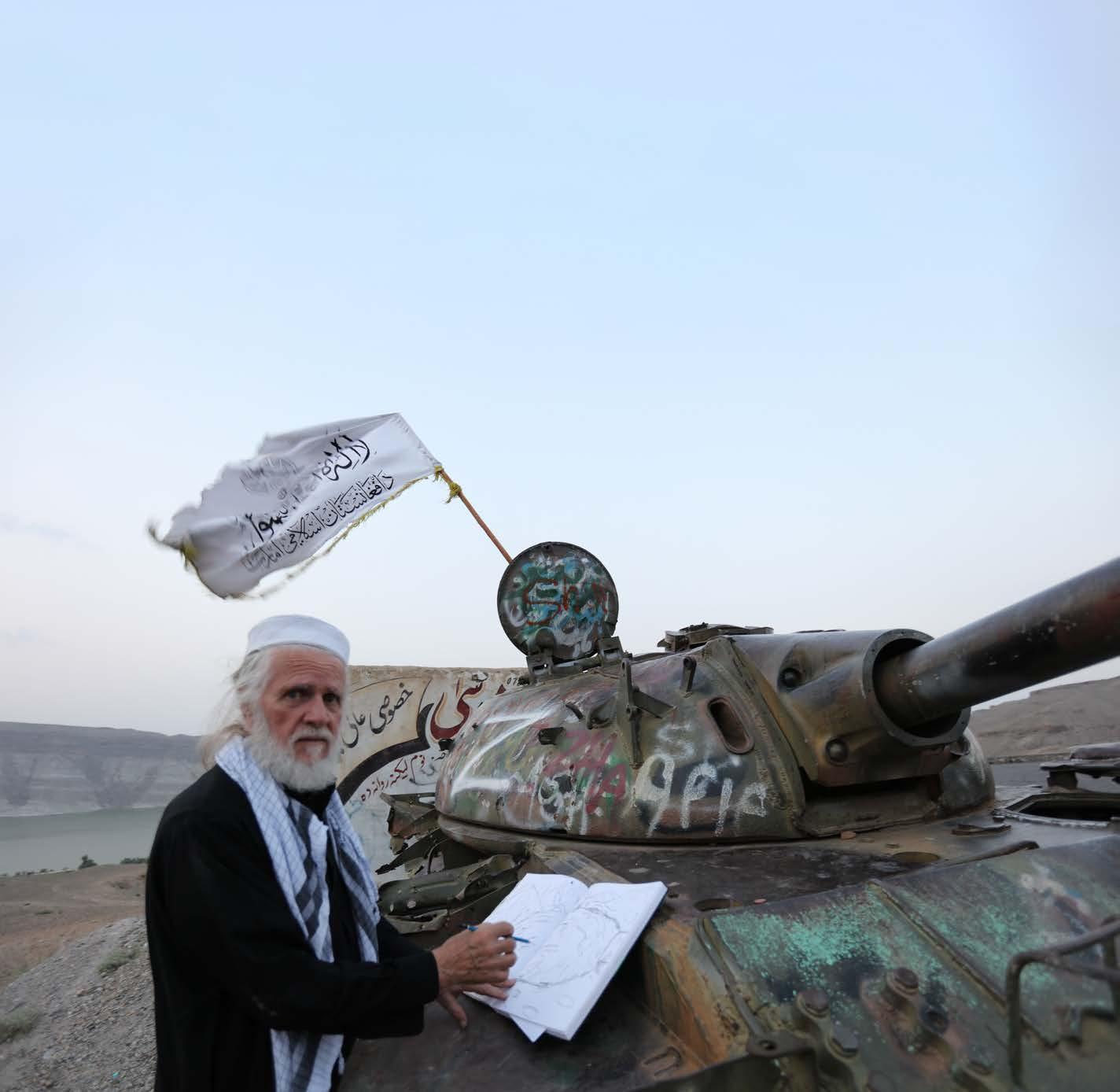
“Only the dead have seen the end of war”
Plato
It was 29 September 2020 when the characters of that sentence formed some of the 240 Twitter ‘bullets’ available at my fingertips. I was engaged in cyber warfare on a global scale, while watching a war being waged on my Armenian homeland unfold from afar.
Hrant Boujikian reflects – page 22
ALSO IN THIS EDITION:
Ending the war on weed – p. 9
Students facing conscription p. 10
Hope for Iranian freedom p. 21
The Australian Wars – p. 24
Agent Orange in Sydney – p. 26
UNIVERSITY OF SYDNEY - FREE STUDENT NEWSPAPER - NEWS, CULTURE & ANALYSIS WEEK 11, SEM 2 2022 Est. 1929
page 13
ACKNOWLEDGEMENT OF COUNTRY
Honi Soit is published on the stolen land of the Gadigal People of the Eora Nation. Sovereignty was never ceded; the invasion of this land was, and still is, a process of immense violence, destruction, and theft.
The Editors of Honi acknowledge the suffering caused by ongoing colonial structures and commit to confronting the political, economic, legal and social systems which continue to oppress First Nations people.
As a collective, we acknowledge that we are each living, writing, and working on stolen Gadigal, Cammeraygal, Dharawal, and Darug land. Further, the university which we attend is an inherently colonial institution, one which upholds the systems of knowledge and power that have caused deep harm and pain on this continent.
As a student newspaper which operates and distributes within such an institution, we have a responsibility
IN THIS EDITION
EDITOR IN-CHIEF Thomas Sargeant.
EDITORS
Carmeli Argana, Christian Holman, Amelia Koen, Sam Randle, Fabian Robertson, Thomas Sargeant, Ellie Stephenson, Khanh Tran, Zara Zadro.
WRITERS
Hrant Boujikian, Nicola Brayan, Luke Cass, Josh Clay, Ethan Floyd, Vivienne Guo, Amelia Koen, Lauren Lancaster, Simone Maddison, PL, Sam Randle, Fabian Robertson, Thomas Sargeant, Ellie Stephenson, Danny Yazdani, Zara Zadro.
ARTISTS & PHOTOGRAPHERS
Waqar Alam, Bipasha Chakraborty, Aidan Elwig Pollock, Charlie Gilmour, George Gittoes, Kate Parunova, Sam Randle, Hellen Rose, Thomas Sargeant, Ellie Stephenson, Khanh Tran, Greg Waite, Zara Zadro.

COVER ARTIST
Waqar Alam: George Gittoes drawing on the road to Jalalabad where an old Russian tank destroyed by Afghan Mujahideen now flies the new Islamic Emirate of Afghanistan Flag, 2022.
BACK COVER ARTIST Thomas Sargeant.
to remain conscious of, and actively combat, complicity in colonisation.
It is important to recognise that First Nations people have, since 1788, resisted and survived colonial violence. Our newspaper needs to platform the voices of this ongoing resistance, truly valuing and heeding Indigenous knowledge and perspectives.
Honi has stood on stolen land since its inception 93 years ago; embedded in the history of this paper is the tireless resistance to oppressive,
EDITORIAL
By Thomas Sargeant.
It is no revelation to observe that there is an abundance of hate and violence in the world. It is another thing to say that we are not nearly as abstracted from it as we might think.
The theme of this week’s edition is war. It may feel like an obvious choice for a newspaper given the current geopolitical climate, but far less obvious are the links between war and our own community. Culture wars, climate wars, drug wars, and wars of conflict and colonisation continue to shape the course of our lives. They are the reason that the non-Indigenous among us stand on this land.
This edition looks at the colonial wars that took place here (p. 24), those who have fled war to arrive at our University (p. 22), and those who continue to study while facing the loss of their motherland (p. 21), or potential conscription themselves (p. 12).
Our contributors have written brilliantly on the war for our urban spaces (p. 8), the war on drugs (p. 9), and the consequences of war on our environment (p. 26).
On page 18, Amelia Koen has looked into the past of this very rag to reveal how students at USyd have faced and resisted war in all of its forms.
In this week’s feature article (p. 13) you can find an interview by me and Amelia with some of the bravest artists alive, George Gittoes and Hellen Rose. Their journey from collective art in Sydney to helping and documenting some of the most war-torn communities on the planet is endlessly inspiring. I
colonial structures within society by First Nations writers, contributors and editors — it is our duty to uphold their legacy, champion their voices, and continue to fight for First Nations justice.
We pay our deepest respect to Elders both past and present, and extend that respect to all First Nations students, staff, and readers of Honi Soit.
Always was, and always will be Aboriginal land.
know a five-page read is an ask, but trust me, it’s worth it.
We have a responsibility to stare conflict in the face; to ruthlessly critique the injustices that feed into and result from war, to resist complacency.
Through looking at war, we can see peace. I don’t think that war is inevitable. I believe that anything we can imagine, we can achieve. I hope that this edition helps to build empathy and understanding, and to help you imagine a world without war.
As my last EIC edition of Honi, some thanks are in order. I write this editorial sitting in the Langford office for what is our antepenultimate edition, and I am filled with gratitude for the opportunity that this year of editing has been. Every year, a new editorial team takes charge of the paper to create their own unique vision and stories — I am honoured to be a part of this history, and am proud of everything we’ve created. Thank you to the editors who have come before, and to those who will follow.
Thank you primarily to my fellow editors this year for making this (and every) edition happen, editing this rag has changed me for the better. Thank you to George and Hellen for your time, your stories, and for showing me how art can continue to affect meaningful change.
Thanks to Amelia for putting in the hard yards, especially with the feature. Thank you to all of the contributors who have bravely shared their stories of survival in a world that threatens to be ripped apart.
GET IN TOUCH facebook.com/ honisoitsydney instagram.com/ honi_soit twitter.com/ honi_soit youtube.com/ honisoitau




Finally, thanks to all of the readers of this week’s edition who choose not to look away.
@honi_soit linktr.ee/honisoit
Disclaimer:
This
ISSN: 2207-5593.

2 | EDITORIAL HONI SOIT WEEK ELEVEN 2022
Have you got a tip for a story? An angry letter to the editors? An article pitch? Email us at editors@honisoit.com Scan the QR code to use our anonymous tip form Send mail to Honi Soit Editors at PO Box 974 Broadway NSW 2007
Honi Soit is published by the Students’ Representative Council, University of Sydney, Level 1 Wentworth Building, City Road, University of Sydney NSW 2006. The SRC’s operation costs, space and administrative support are financed by the University of Sydney. Honi Soit is printed under the auspices of the SRC’s Directors of Student Publications (DSP): Emily Mackay, Jinhui (Candice) Lu, Mahmoud Al Rifai, Sara Kie, Lily Wei, Cooper Gannon. All expressions are published on the basis that they are not to be regarded as the opinions of the SRC unless specifically stated. The Council accepts no responsibility for the accuracy of any of the opinions or information contained within this newspaper, nor does it endorse any of the advertisements and insertions. Please direct all advertising inquiries to publications.manager@src.usyd.edu.au.
edition published on 18 October 2022.
News Strikes Campus War Analysis Conscription Feature 4 5 6 7 10 13 War Archives Peace & Chaos Iran Armenia Reviews Agent Orange 18 20 21 22 24 26 Nuclear OB Reports SRC Puzzles Comedy 27 28 29 30 31
Belinda Hutchinson Column for Nuclear Takes
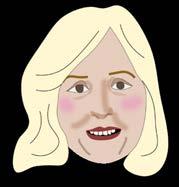
Cadets programs SUCK
Ellie Stephenson conscientiously objects.
To me, private schools are really weird in general. When I hear people talk about their school pools, school socks, hats and ties, and worst of all, their school prefects, I have many questions and concerns. But nothing arouses a deep sense of suspicion and alarm in me like private school army cadets, a program as bizarre as it is ethically questionable.
My first encounter with cadets was as a first-year debating adjudicator
venturing onto the grounds of an elite Sydney independent school that will go unnamed. Here I was — steeling myself for a hotly contested GPS Seconds debate — when I found myself in what I initially believed was a warzone (albeit one with a disproportionate number of child soldiers).
Pimply youths in startling military fatigues marched around the soft-fall rubber of the school quadrangle, mouthing unintelligible army utterances and converging and separating in mystifying arrays.
I almost turned and ran, but luckily spotted a sign directing me to the safe, ammunition-free zone of Friday night debating — itself an activity of questionable adherents, I admit,
but certainly less brainwashed ones.
Honestly, it shouldn’t even be necessary to write a column about why getting Sydney’s richest schoolboys to line up in silly little lines and march around chanting is stupid. It’s the kind of harebrained thought I’d chuck in The End Times at 3am. But, for whatever reason, thousands of children around Sydney regularly participate in this activity.
Straightforwardly: these kids should be reading a book or walking their dog. Paying hundreds of thousands of dollars for your child to go to grammar school only to march around in circles learning categorically nothing is deranged. Child soldiers are bad, even if they are just LARPing. Teach your kid to vacuum – it’ll serve them better than cadets ever will.
Is my housemate a weapons dealer?
I’m not much of a shopper, but being relegated to a single shelf in a sharehouse fridge requires you to be one — recreational shopper or not. A bulk buy is only useful insofar as you can eat everything that can’t fit before it goes off. So then, consider me reasonably irritable when my full shelf got reduced to half by one of my housemates occupying it with metallic rods he insists “need cooling”. Not only has he turned the temperature inside the fridge to a near arctic temperature, sealing my Tupperware with permafrost, but my vegetables have now started to grow the most obscene deformities I’m talking carrots with eyes, mushrooms on mushrooms, and glowing offshoots from my potatoes resembling triffids.
Even worse, our garden hose by the side of our house resembles a crime scene, almost as if someone has taken a blunt knife to a spring onion, and our garage
unit is now host to obscure and rattly objects, which I assume to be commercial kitchen appliances under maintenance. When I raised the storage issue with my housemate, they simply threw a bundle of cash my way and proposed I use it to store anything I need off-site, as they needed the space. Why they can’t store their new toys in a rental storage facility is beyond me.
And don’t get me started about the mail. A courier now knocks on our door every other day, dropping off thick parcels. Why someone would order so many books in such a consistently piecemeal way is infuriating.
Further, he boasts proudly of his new ‘dumb phone’ which I initially took to be a part of his new self-help shtick. However, I realise this device must be a satellite phone by nature of him only taking calls standing on our roof or outside near the corpse of our hose.
While frustrating, all of this seemed within broad bounds of permissible housemate misbehaviour. That was until I went to unjam my (usually issue-free) printer only to find various passports and US government contract cover pages left in the scanner. My housemate is away at a “Defence Conference” this week, and maybe it’s all the mutated food I’ve been eating, but the thought can’t escape my mind is my housemate a weapons dealer?
Dear Reader,
It seems plausible. Maybe invest in some iodine tablets while you investigate further. It mightn’t hurt plugging in one of those ‘appliances’ and seeing what happens — Nutribullet or nutriBOOM? We would advise against raising the issue until you have multiple witnesses present, and perhaps have invested in kevlar.
The Gig Guide // make dance not war
Wednesday 19 October
Cellar Theatre // SUDS Presents: The Popular Mechanicals // 7pm
The Midnight Special Newtown // Alice Williams // 8pm
Enmore Theatre // TY Dolla $ign // 8:30pm
Thursday 20 October
Phoenix Central Park // Carla Geneve // 6:30pm
Cellar Theatre // SUDS Presents: The Popular Mechanicals // 7pm
The Lansdowne // Workhorse // 7:30pm
Qudos Bank Arena // Tame Impala // 7:45pm
Oxford Art Factory // Outfit // 8pm
Friday 21 October
Cellar Theatre // SUDS Presents: The Popular Mechanicals // 7pm
Manning Bar // Metal Gods // 7pm
Kelly’s on King // Sweetie // 7pm
Chippo Hotel // The Toothpicks // 8pm
The Factory // GRXCE // 8pm
The Bank Hotel // Agony // 8pm
The Lansdowne // Stepson // 8:30pm
The Townie // Reza Feza // 11pm
Saturday 22 October
Cellar Theatre // SUDS Presents: The Popular Mechanicals // 7pm
Kelly’s on King // I know you know // 7pm
The Vanguard // FVNERAL // 7pm
AILARTSUANIYTREVOPTNEDUTSNO TROPERSESAELERSUNTWO2
KOOBDNAH1202MORFDEPPARCSS TINUETAUDARGREDNUSTRA071N AHTEROMTWENTY4
TSEFPORTFOTSALEHTNEESEWEVAH THIRTYFOUR1FORTYSEVEN1
RETTELNEPONAEMOHNAILUJGNIRB TWOHUNDREDFORTYONE1
KOOBDNAH1202MORFDEPPARCSS TINUETAUDARGREDNUSTRA071N AHTEROMSEVEN5
LAIROTIDESEVEN6
DRYTICEHTDNAXESTWELVE6
= CAMOUFLAGE =
LAIROTIDETWENTYFIVE4”
LLEWGNIEERGASIDROFNMULOCEC NEPSLEAHCIMTWENTYTWO1
Mary’s Underground // The Delta Riggs // 7:30pm
The Lansdowne // Outright // 7:30pm
Metro Theatre // Crossfaith // 8pm
The Factory // Eat Your Heart Out // 8pm
Factory Theatre // The Animals // 8pm
The Chippo Hotel // Radio Free Alice // 8pm
LLEWGNIEERGASIDROFNMULOCEC
PACERREBOTCTOCRS
Editors’ Note
After the Week 11 edition of Honi Soit went to print, the Editors were alerted to the fact that the cover art supplied was copied from a well-known artist, Yuko Shimizu.
The Editors organise contributors to design the cover art each week, and were operating under the assumption that Week 10’s art, like any other edition, was original
“DRYTICEHTDNAXESTEN1
TSEFPORTFOTSALEHTNEESEWEVAH ONEHUNDREDNINE6
art provided by the contributing artist.
We were surprised, disappointed and — to be honest — quite angered to hear that the art provided was not original, and made immediate steps to credit Yuko Shimizu, as well as make contact to explain the situation.
Although we, the Editors, did not know the supplied art was copied, we nonetheless apologise and take full responsibility for its publication.
STNETNOCSIDSTIDNAAIBRUBUSE NALYROMEMNWODNINETYNINE3
“TNEDISERPTHIRTYTWO2THIR TYTWO3”
Honi Soit is a place that uplifts and respects the original work of artists, not one that takes and appropriates it.
We promise to more rigorously check the originality of the art supplied to us in future, to ensure that something like this never happens again. To Yuko Shimizu, we apologise unreservedly that your art was used without your permission.
The Editors.
Manning Bar // Black Alien // 9pm
The Bank Hotel // Butterfingers // 9pm
Sunday 23 October
The Midnight Special // Ed Barnes // 8pm
Mary’s Underground // Steve Smyth // 8pm
Metro Theatre // Pouya / 8pm
Wed 26 October
Oxford Art Factory // Alex Lahey // 8:30pm
Enmore Theatre // Parcels // 9pm
LETTERS & COLUMNS | 3HONI SOIT WEEK ELEVEN 2022
Codebreaker Crack the code to unlock the hidden message. Hint: Use Week 10 Edition Email us if you get it at editors@honisoit.com LAIROTIDESEVEN6 DRYTICEHTDNAXESTHIRTYFIVE7SIX TY7
NEPSLEAHCIMFORTYFIVE4FORTY SEVEN6
TWENTYE IGHT2SIXTYSIX1
Sixth USyd staff strike responds to ‘baffling’ negotiations
Honi Soit
University of Sydney staff went on their second 48-hour strike this year after University management failed to settle on key union demands regarding the preservation of academic workloads, ending casualisation, implementing a real pay rise above inflation and increasing the number of First Nations academics.
Picket lines were set up across various entrances throughout campus on Thursday and Friday of last week. In comparison to previous strike rounds, there were fewer incidents of strikebreakers crossing picket lines, allowing strikers to enjoy the sun and company of their colleagues for both days of the strike.
Day 1
Day one of strikes began witth a strong start. “We’ve definitely made some progress through the last four days of strikes in moderating some of the attacks that management has made,” said NTEU Branch President Nick Riemer.
“We’ve got genuine regulation mechanisms for professional staff
members have stressed that there is still room for growth.
“We still have a way to go with the fight for casuals’ rights and an end to exploitation,” said Branch Committee member Lucy Nicolls.
“We’re fighting for sick pay, for superannuation, for pay for all hours worked.”
An extra 300 “continuing academic staff” would increase the number of academic staff from 3514 to 3814. Assuming a baseline of 74,862 students with no increase in enrolment, this would decrease the student-to-staff ratio from 21 to 19.6, yet fall short of the pre-COVID-19 figure of 17.4 in 2019, according to Honi’s calculations.
Union membership has also significantly increased as a result of a strong strikes campaign throughout the year, with at least an additional 250 members since January, or a 14 per cent increase.
“I hear people sometimes say that people are discouraged by the strikes, but that’s not the experience I’ve had. I think people are feeling empowered and inspired by people willing to stand up,”
present picketing Carillon Avenue.
“Academics and students from the Conservatorium have come to join in solidarity with our main campus colleagues who do have classes,” said Senior Lecturer of Music James Humberstone.
“It’s actually very important to the Conservatorium because more than half of our staff are casuals – they have no route to permanent employment,” he said.
Day 2
Strikers came out in force for day two. Like day one, fewer strike-breakers attempted to cross pickets at the Ross Street, City Road, Foot Bridge, Parramatta Road, Victoria Park, and ABS entrances than at previous strikes this year. At Ross Street, a group of college students were blocked from exiting campus, with strikers reinforcing the sentiment “no one in, no one out.”
NTEU USyd Branch Vice President (General Staff) Jennifer Dowling described the effectiveness of a 48-hour strike as opposed to a 24-hour one.
workloads, gender affirmation or transition leave, and significant new flexible work and work from home rights, mainly for professional staff,” Riemer said.
NTEU National Councillor (Academic Staff) Dani Cotton also told Honi: “When we started out, they wanted to abolish workload committees altogether, which are the only way we can stop overwork and wage theft. We had wins for professional staff’s rehiring rights, where internal advertising of job vacancies are prioritised at some levels.”
Cotton explained that since the last strikes, management has been more amenable to preserving the 40:40:20 research-teaching-administrative work model, although with a 10 per cent leeway.
“That’s still an attack on the right to research time because they can always bump it down, but to be honest, it’s still a win for the union,” she said.
The University has also offered to hire an additional 300 continuing academic staff since the last strikes in response to the NTEU’s demands to address the casualisation crisis, although union
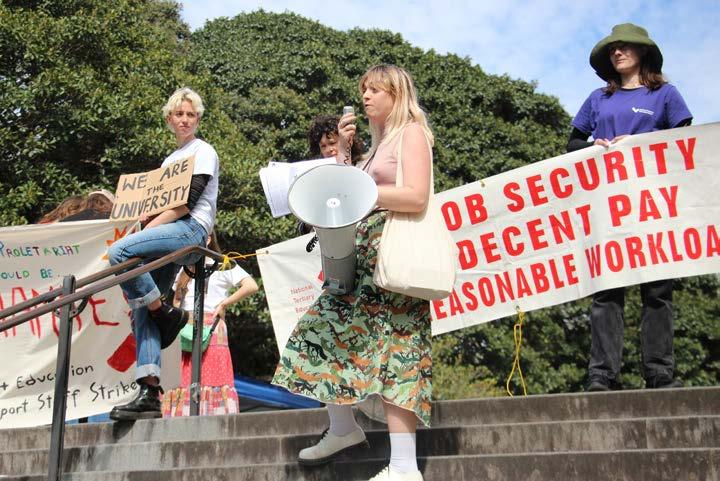
Branch Committee Member John Buchanan told Honi: “Lots of the union’s recent wins have come through us digging in hard.”
Buchanan also described Deputy Vice-Chancellor Professor Annamarie Jagose’s claims in a recent universitywide email that the University would not be influenced by industrial action as “just plain wrong”.
“She’s never actually been to a bargaining meeting, and she doesn’t have any firsthand experience of grinding through the details,” he said.
“They want to run this hardline, but want someone else [such as an external lawyer with no experience working at the University] to do it for them,” he said. “Engaging with management has been very frustrating and baffling.”
Student education activists have also responded to University’s attempts to enable strikebreakers with online Zoom pickets, with dozens of classes disrupted and a total of eight cancellations.
Students and staff from the Conservatorium of Music were also
“There have been fewer people crossing the picket line this strike than there were previous strikes,” she said.
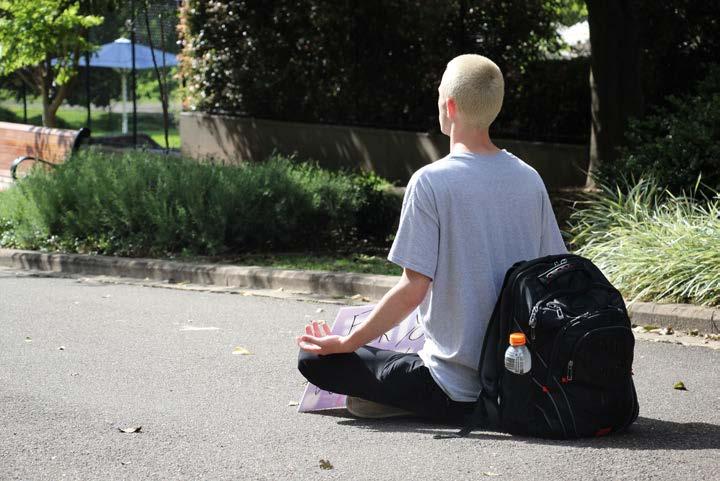
A student education activist who asked not to be named praised the attitude of striking students.
“I think [Annamarie’s] email was disgusting, but the response was exactly
the right response. Students have gone even harder and staff sign-up to the pickets has increased after the email, so it backfired for Annamarie,” the student said.
“We found out that around a hundred students were in the architecture building, so five classes. We went there and talked to them, and three out of five classes actually decided to walk out, which was a huge success for us.
“We get Zoom links from students, from staff, and we shut down those Zoom classes, and I think we got eight to ten classes yesterday. We’ve had a really big one shut down in engineering today as well,” they said.
On Eastern Avenue, where the main contingent of strikers congregated, NTEU USyd Branch Vice President (Academic Staff) David Brophy lauded the importance of industrial action to a functioning university.

“A university is a place that engages with political ideas; it’s part of society. For there to be debate and discussion among staff about the union, and for colleagues to be asking others colleagues to join the union to support union action, there shouldn’t be anything surprising about that,” Brophy said.
“[Union] membership has gone up by several hundred since the beginning of the campaign. I think it is usually the case that when the people see that the union is fighting for something that they support… a lot of people feel that they should be involved,” he said.
HONI SOIT WEEK ELEVEN 20224 | NEWS
Nicolls said.
NTEU National Councillor Dani Cotton speaks at Victoria Park picket.
USYD NTEU Branch President Nick Riemer addresses staff and students at City Rd picket.
Student meditating at City Rd picket.
PHOTOGRAPHY BY SAM RANDLE
The support for strikes at the University of Sydney is setting the tone for student participation in union action on other campuses, according to SRC President Lauren Lancaster.
“The strike has shown again and again, that Sydney is not only a highly collectivised and highly motivated group of people but also that students will always stand with our staff and [that] continues to pave the way for union action after universities around the country,” Lancaster said.
“We don’t anticipate the campaign weakening at all, and whatever students can do for staff, we’re there for you a hundred per cent of the way,” she said.
At Barff Road, Honi spoke to ANU students who came up from Canberra to show solidarity on the picket lines.
“All the struggle that’s happening here is the same as ours because all of these Group of Eight (Go8) universities do talk to each other,” said Australian National University (ANU) student activist Mickey Throssell.
“They have meetings nonstop, and we can tell that they are all taking the same stances and they’re all doing the same sort of shit obviously all across the country,” they said.
“It’s a phenomenon, this corporatisation of university, which isn’t unique here,” said Skye Predavec, another
ANU student activist.

Following a customary sausage sizzle, speeches commenced to close the day.
Mark Goudkamp from the NSW Teachers’ Federation highlighted the historical efforts of USyd’s 2022 strike action.
“We didn’t strike for about 10 years, but since last December we’ve gone on strike three times about our workload, which is becoming absolutely impossible for teachers,” said Goudkamp.
He highlighted the elitism permeating the NSW Department of Education, which Mark Scott headed between his time at the ABC and USyd, and criticised the divide between public and private education.
“While he [Scott] was full of rhetoric about making world class public education… he saw the constant erosion of our conditions, our pay, and our school facilities,” Goudkamp said.
“Our public education system is underfunded. It is in crisis. But united, if we support each other, stand shoulder to shoulder, pre-school to PhD, we can push back both state and federal governments and win a public education system that is worth defending,” he said.
Goudkamp also criticised the teacher’s unions for calling off industrial action this Wednesday in response to NSW Labor Opposition Leader Chris Minns saying he would consider scrapping the public sector pay cut and reopen negotiations with the Union.
“I think that bait was taken by the union and they called off the strike, much to the disappointment of teachers, TAFE teachers, Catholic teachers across New South,” he said.
“On Wednesday, we still had a rally outside the Industrial Relations Commission, but it was from 7:30 to 8:15 before school without a strike. It meant that only those teachers who were close enough to Parramatta were able to attend. And instead of having five or 10,000 people on the street to Parramatta, we had about 400, because of that calling off the strike.”
Finally, Goudkamp called out Labor’s failure to improve working conditions for teachers and university staff: “Do not call off the industrial campaign. Do not swap our strikes just for an election campaign to get NSW Labor elected next March [at the election].”
The NTEU will vote in coming weeks on further strike action in Week 13 of this semester.
USyd moves classes online in attempt to evade fourth NTEU strike
 Ellie Stephenson
Ellie Stephenson
The University of Sydney advised staff to work online during the National Tertiary Education Union (NTEU) strike as an escalation of strikebreaking tactics used in earlier strikes.
In recent staff communication, the University recommended “that staff who can work from home do so, including switching to remote teaching.”
Additionally, Pro Vice-Chancellor of Educational Innovation, Adam Bridgeman sent staff a guide on securing Zoom classes in advance of Thursday and Friday’s strike.
The strike campaign has contended with the use of Zoom classes to avoid the effects of physical picket lines in the
previous three strikes. Acting as a digital roaming picket, contingents of students interrupted Zoom classes to counteract this tactic from the University.
In advance of the strike, the campaign asked students to notify the NTEU of classes that were going ahead, and contacted their teachers to ask them to cancel the classes.
Both staff and student organisers within the campaign expressed the damage effected by online strikebreaking.
Riemer wrote to potential strikebreakers to describe Zoom classes as “undermining” the NTEU’s efforts. He also tweeted that the University’s efforts to thwart strikes reflect the strength of
the enterprise bargaining campaign in shutting down campus.
Riemer told Honi: “If people are determined to side with management against their colleagues, they should at least have the honesty to confront a physical picket and explain why they’re undermining the very campaign that they’ll benefit from when the new agreement is finally signed.”
Incoming SRC President and current Education Officer Lia Perkins spoke strongly against online strikebreaking in an SRC meeting last week.
“Another reminder to everyone… Zoom classes are breaking the strike. The NTEU have said that they really want this strike action to be very big
and successful, so we really don’t want Zoom classes to undermine this effort,” Perkins said to the Council.
She told Honi: “Holding zoom classes and putting on Zoom classes undermines the ability of staff to achieve positive gains for all staff and students at the university. We are encouraging students not to go to their online classes to make the disruption as large and successful as possible.”
This development came after a student who participated in online strike action was threatened with disciplinary action by the University last month. Following a petition from students and a motion condemning the action from the NTEU, the student received only a warning.
National Union of Students announces changes after $9,500 mismanaged
Ellie Stephenson .
T he National Union of Students (NUS) announced a suite of changes yesterday in response to financial mismanagement revealed by Honi earlier this year.
The organisation, which is the peak representative body for Australian students, acknowledged that 2021 General Secretary Param Mahal had entered a $9,500 consultancy contract without the knowledge of the National Executive. Mahal engaged 2020
General Secretary Samuel Roberts, who also belonged to Unity (Labor Right), as a consultant in starting a new international student organisation.
Further, Mahal released the second instalment of the payment during the term of 2022 General Secretary, Emily Sagolj, who ultimately raised the matter.
The NUS’ statement confirmed that 50 per cent of the payment has been returned and that no further services will be provided within the
consultancy.
Going forward, the Union is making a set of changes to how it manages its financial affairs.
The NUS Executive Committee, consisting of the President, General Secretary, Education Officer, and Welfare Officer, has been newlyformed to approve expenses between $400 and $1000.
The National Executive will be required to approve any expenses over
$1000.
Additionally, the NUS has committed to equipping all National Executive members with detailed profit and loss reports, and further upskilling in office-bearer handovers. Outgoing office-bearers will be strictly removed from accessing NUS bank accounts.
The Executive also committed to improving transparency by providing detailed minutes and inviting student media to attend.
NEWS | 5HONI SOIT WEEK ELEVEN 2022
Picketers enjoying the sun on the 6th day of strikes this year.
SRC General Secretary Alana Ramshaw speaking outside F23.
‘Oriental Studies’ at the University of Sydney
LUKE CASS WRITES.
Near the left entrance of USyd’s Quad, room S204 is labelled the ‘Oriental Studies Room’. A framed poster on its entrance states that it was built in 1859, and used to house the Nicholson Museum’s collection. Perhaps that explains why the rooms weren’t used to teach ‘Oriental Studies’ until almost sixty years later, with the creation of the Department of Oriental Studies in 1918. The Department’s creation is an early example of the University of Sydney’s connection with the military in the academic sphere.
Following the Russo-Japanese War between 1904-1905, Australia’s political and military establishment has had a racist preoccupation with the threat of Japanese invasion. In the aftermath of WWI, Japan’s newfound control of ex-German colonies and Britain’s withdrawal from the Pacific provided an arguably more rational basis for this fear. It became important for the Australian military to understand the cultural and militaristic ambitions of Japan. To develop this understanding, the federal government’s Department of Defence installed Scottish Professor James Murdoch to a lectureship in Japanese at the Royal Military College at Duntroon in 1918.
military influence within the University was compounded throughout Murdoch’s tenure. Murdoch and Piesse maintained frequent correspondence, with Piesse learning Japanese from Murdoch at the time. Murdoch also went on a militaryfunded trip to Japan to report back on the country’s political environment.
This close relationship between a USyd lecturer and the Department of Defence was arguably less pernicious than USyd’s present relationship with the military: better engagement with the Japanese political sphere is less unethical than undertaking research to develop the weaponry of private defence companies and support for the aggressive posturing of the AUKUS pact. Nevertheless, it demonstrates that governments have historically, and will continually be driven more by advancing military interests over public ideals of a liberating education, and provides a warning of the extent to which universities can become entangled within the state project of militarism.
environmental factors as opposed to being inherent. The entire practice of ‘Oriental Studies’, and the pair’s view of the Japanese people, is a reflection on the West’s exoticisation and othering of Asian cultures.
Murdoch’s courses in Japanese language and political culture were initially popular. Eighty students enrolled to study under Murdoch during the first year of the Department. This number failed to grow significantly as students found it difficult to learn Japanese. Instead, courses on ‘Oriental History’ which did not require knowledge of Asian languages became popular in the inter-war period under Professor Arthur Lindsay Sadler. Chinese language subjects were added to the Faculty of Arts after Sadler’s departure in 1947. However, those classes, along with Japanese language classes, ceased four years later when the University thought it was impossible to recruit suitably qualified academics to replace departing staff.
Upon the request of the Faculty of Arts and under the influence of business elites who were keen to trade in Japan, Murdoch was then installed into a lectureship in Japanese at the University of Sydney the same year. The Commonwealth, particularly eager to expand students’ knowledge of Japanese (for ostensibly military ends), subsequently bestowed annual grants between $500 and $700 (or $48000 and $65000 in 2022) to the University for the maintenance of the Oriental Studies Department for decades, between 1918 and 1945.
Murdoch was handpicked for the positions by the Director of Military Intelligence at the time, E.L. Piesse. Such
Murdoch and Piesse, despite being military collaborators, viewed the study of Asian language, culture, and history as a means of combating ignorance and racism towards Asia. Piesse was highly critical of Australian Prime Minister Billy Hughes’ vetoing of the ‘racial equality principle’ at the Paris Peace Conference. Both men supported the revision of the White Australia Policy, viewing it as unnecessarily discriminatory and diplomatically inflammatory. This indicates the significant potential of Asian studies in challenging the hegemonic power of racist attitudes such as those embodied within the White Australia Policy. More broadly, it indicates the capacity of an education that openly engages with other cultures to contribute to a more just society.
This is not to say that Piesse and Murdoch were not racist; Piesse believed that ‘racial differences’ were due to

USyd’s abandonment of Asian languages in 1951 reflects a country and a University that lacked the commitment to resourcing the departments which enable us to understand the world, and reduce racist antagonism towards Asia. It’s easy to draw parallels with today’s University landscape; language subjects have continually been cut while military research grants proliferate.
Much has changed since Murdoch took the Chair of the Oriental Studies Department: Oriental Studies became Asian Studies, which became the School of Languages and Cultures. Indian studies came and went. Other things haven’t changed: Australian universities are deeply entangled with the military, and at USyd, we still have the ridiculously named ‘Oriental Studies Room’.
HONI SOIT WEEK ELEVEN 20226 | CAMPUS
WAR OF THE WORDS USING RHETORIC TO JUSTIFY CONFLICT
marks to signal urgency typographically: “Enlist!”.
War, in a vacuum, is abhorrent. It is the coordinated murder of thousands, sometimes millions, of people, in the hope of conflict resolution. And yet, the world has seen no shortage of wars. Sometimes, groups enter wars out of necessity, as a last resort against violence or oppression. Other times, nations formally enter into war, committing their own citizens to the conflict and sending many to their deaths. Justifying this — and, further, persuading a country’s own citizens to enlist for such a dangerous effort — requires that those citizens think of war not as abhorrent, but as necessary, as moral, perhaps even as heroic.
To do so, governments and public figures rely heavily on language and rhetoric to persuade a nation of war’s value. This is especially true when the citizens of said government are not otherwise at direct or immediate risk of experiencing the conflict, and entry into the war is purely political. In this article, I’ll explore the linguistic and semiotic history of Australian war propaganda — both the familiar twentieth century posters you may have seen in your history textbooks, and in the language used by contemporary warmongers.
Let’s start with the one of the first conflicts that Australia as a federated nation had the chance to enter: World War I. It’s worth noting that, just as with the other conflicts in this article, Australia was geographically isolated from the bulk of conflict. That is, Australia did not enter WWI for fear of being attacked; rather, it entered to support the United Kingdom as a member of the Commonwealth. The propaganda posters were thus a key part in convincing the Australian public that entry into the war was worth their own lives.
In propaganda posters, there are two noteworthy recurring grammatical features. First, imperative constructions, which demand something of the reader (as opposed to recounting an event). These can be identified by an absence of an agent in the core verb construction. Examples from posters I observed include single imperatives, such as “Enlist now”, and imperatives in sequence, like “get busy, and drive the Germans back!” and “Don’t stand looking at this. Go and help!”. They often featured exclamation
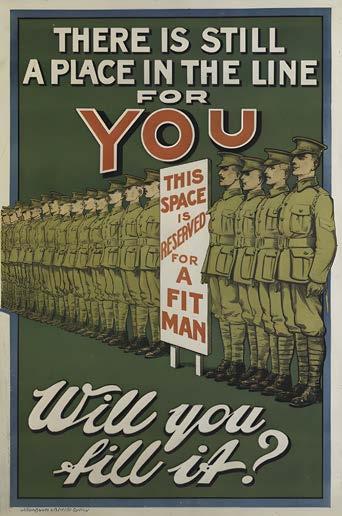
Rhetorical questions also featured frequently; questions that are asked with an answer the reader understands as implicit. These are powerful, as they not only further communicate urgency, but their answers are so common-sense and broadly understood that to deny them is to go against the mainstream, potentially incurring shame. Examples include “Would you stand by while a bushfire raged?” “Won’t YOU come?” (their emphasis), “Must it come to this?”.
Lexical and semiotic choices include the foregrounding of camaraderie (“Join Together Train Together Embark Together Fight Together”, and images of soldiers in lines surrounded by peers) and urgency (referring to bushfires, to calls that imply a need for response). They often include references to general Australian values or iconography — an image of a kangaroo, references to “the surf” and bushfires, a plea to “help us keep that promise” — and the suggestion Australia was under attack, such as one poster which depicts Australia under the shadow of a German soldier’s hand.
Australia’s entry into World War II was also motivated by support for Great Britain. However, the perceived threat of Japanese invasion due to Japan’s aggression in the Pacific was at the heart of many Australians’ decision to enlist. As such, while employing much of the rhetoric of WWI propaganda, there was an increased emphasis on Australia’s geographic vulnerability to attack at the core of WWII propaganda. Many of the features I observed in posters about WWI were also present in those in support of WWII, with a few noteworthy additions.
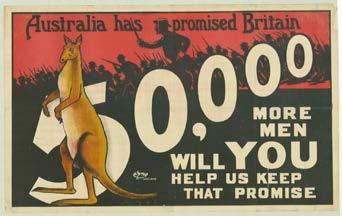
First, although rhetoric and imagery suggesting Australia was under threat is still present, the face of that threat has changed. One poster depicts an oversized Japanese soldier moments away from
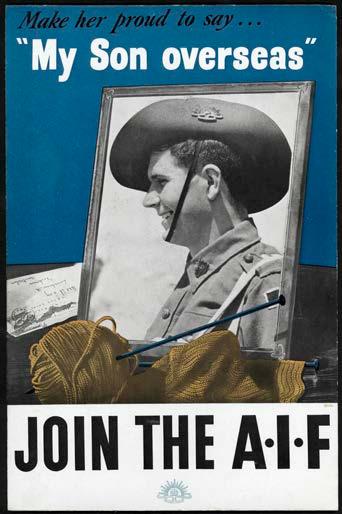
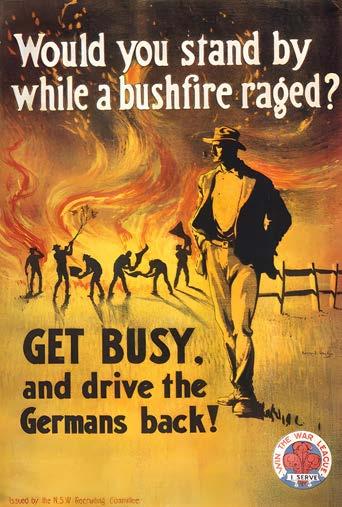
setting his boot on Australia; another describes Australia as “ringed with menace” and depicts it as surrounded by boats bearing the Rising Sun flag. The ‘Yellow Peril’ narrative constructed by this imagery is an example of propaganda establishing a clear ‘other’, compounded by the choice to represent enemy forces with a single person pronoun: “He’s coming south”. In doing so, the posters define the enemy as a discrete entity, implicitly characterising it as identifiable and excisable. Lexically, many of the posters featured language relating to victory — “change over to a victory job” — and high modality language, denoting a sense of certainty: “It’s fight or perish”.
single, knowable figure of Osama Bin Laden and used single person pronouns throughout the speech. He appealed to Australian values, saying Bin Laden hated “individual freedom, religious tolerance, democracy,” and claimed that enlisted soldiers would “have all the support the nation can give them”.
Howard positioned the 9/11 attacks as a threat to Australia: “We were all the targets… September 11 was an attack on the right of Australians, especially young Australians, to go about their daily lives and to move around the world with ease and freedom and without fear.” He made references to victory — “There is no doubt that the coalition forces will win” — and used consistently high modality language to create a sense of certainty and urgency: “the parties must return urgently to the negotiating table”, “A solution must be found”. Although not as blatant as posters caricaturising Germans or the Japanese, Howard appealed to the same emotions that past pro-war efforts did.
Posters and rhetoric alone cannot account for Australia’s contributions to both world wars. Principles like justice, honour, fear of the unknown, and unity all exist outside of the linguistic and semiotic choices of the government. In creating this propaganda, however, the public’s fears and values were affirmed and directed towards a clear end goal: enlisting and supporting the war effort. Although we have not seen such stark propaganda for enlisting in recent decades, this strategic redirection of concern and morality is far from historic.
In 2001, after the 9/11 attacks, the United States entered Afghanistan and began a decades long occupation. Australia entered in October of that year. In an address to the Australian Defence Force, then-Prime Minister John Howard defended his decision to follow the US into war. He reduced the enemy to the
My conclusion is not that the government was solely responsible for pro-war rhetoric, or that people were wrong for resonating with the messages they received. Instead, I wish to emphasise how important it is to be critical of the language and symbolism used by those who may have an interest in stoking conflict. Propaganda need not be spelt out with bold letters and exclamation points; rhetorical choices can function just the same.
In his time as Prime Minister, Scott Morrison was a vocal critic of China. He positioned them as a threat to Australia as a “free, democratic, liberal country”, and blamed them for the deterioration of relations in the Pacific. He has identified Xi Jinping as being at fault for tensions between the two nations. Words are powerful — pay attention to why they are being used.
ANALYSIS | 7HONI SOIT WEEK ELEVEN 2022
Nicola Brayan writes.
“Citizens must think of war not as abhorrent, but as necessary, as moral, perhaps even as heroic.”
Sources: State Library of Victoria (1914), Museums Victoria (1943), Australian War Memorial (1915), Australian War Memorial (1917)
For a Better City
Not a war fought with guns, explosives or a real enemy, but one fought against intangible forces — time, geography, bureaucracy, and culture. Against these adversaries, Sydney is faced with unique difficulties in its attempts to create a more livable city.
Stretching 70 kilometres from east to west, with a population of only 5 million, Sydney is expansive. In comparison, New York City is home to over 8 million people in a city 90 per cent smaller. Sydney’s sprawl creates an overwhelming vastness which has become the enemy of our public transport — transport that facilitates access to work, social services, and recreation.
With the advent of the motorcar, the scope of residential occupation in the Sydney Basin has expanded. Communities branched out from key road and rail corridors into progressively more isolated areas, creating low-density settlements along with new opportunities for industrial and vocational work in Western Sydney.
The car was believed to provide a remedy to the spatial issues of the area, but with commute times now averaging 71 minutes a day for the average Sydneysider — and the global push towards the use of mass public transit instead of private vehicles — the notion that the car is the solution is increasingly archaic.
Currently, there are two new Sydney Metro lines under construction which branch into the Western suburbs south of the Parramatta River. Both departing from the inner city, one line will service routes to Parramatta, while the other will go southwest to Bankstown. The purpose of the current Metro is to relieve pressure on the heavy rail network during peak times, and to support “employment growth” according to the NSW Government.
However, the design and scope of Sydney Metro is critically flawed. Metro railway cars are built for short distance, inner city travel: there are no bathrooms, limited seating, and often become overcrowded. Anyone who’s ridden on metro rail overseas knows how uncomfortable the choking crowds and constant standing can get after a short while. So why is there a single line extending from Rouse Hill through the city to Bankstown?
areas cannot and is not being improved by a Metro system that should be relegated to the inner city. Western Sydney, and Greater Sydney itself, urgently needs its own dedicated heavy rail and bus upgrades to accommodate the projected one million new residents by 2041.
A way of subdividing the looming difficulties of connecting all of Sydney is to reject the idea that the CBD is the heart of the city with a gigantic western flank trailing it. Instead, the independent Greater Cities Commission, established by an act of parliament in 2015, imagines three defined cities in Greater Sydney — the Eastern Harbour City (the current CBD), the Central River City (Greater Parramatta), and the Western Parkland City (Badgerys Creek
hinders the development of a better rail network to Parramatta that could result in an economic and cultural challenger to the inner city’s hegemony.
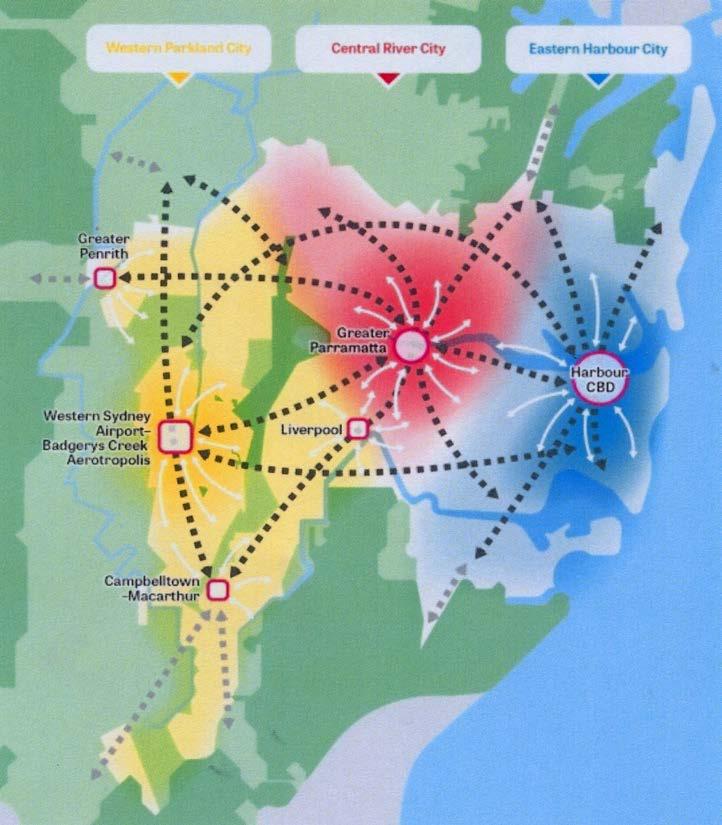
In their article, they contend that “there is little attempt [by the Greater Cities Commission] to help tackle the housing affordability crisis,” reflecting the limited attempts of new developments to make meaningful contributions to affordable housing growth. However, Searle doesn’t dismiss the paper entirely, saying that “a bold but arguably flawed vision is to be welcomed for broadening the discourse about options for Sydney’s future.”
build our suburbs is a decision between life and death.
The option that would result in the best outcomes would be the densification of the suburbs. If many people moved into tall complexes, more space could be allocated to vegetation and shade, actively promoting the reflection of heat and resulting in a cooler local climate. Denser urban centres also facilitate simpler public transport network design, to service more people in a smaller area.
However, like the Greater Cities Commission, that is an idealistic vision completely at odds with reality.
To add to this mess, the state government has repeatedly doubled down on the choice to bore tunnels that are only big enough for single-deck metro cars, excluding the possibility of Sydney’s regular railcars ever operating on those lines. This isn’t planning for the future, this is a short-sighted, illconceived plan with inherently little room to improve once implemented.
Covering a vast swathe of land, Sydney’s lack of transport to underserved
and Penrith) — splitting the city into thirds from east to west.
By “guiding private sector investment”, the Commission aims to encourage the economic and infrastructural growth of the three cities, creating more job opportunities near these centres. In doing so, the logistical nightmare of connecting all of Sydney is broken into bite-sized chunks; aspiring to have all Sydneysiders within 30 minutes transport of their work, public services, and recreation.
Bolstering lofty claims and utopic jargon, the plan isn’t without criticism. Associate Professor Glen Searle from USyd and Professor Emeritus Kevin O’Connor at the University of Melbourne argue that prioritising fast rail connections to the new ‘Aerotropolis’ near Badgerys Creek
Another significant planning issue is urban heat: the Western Parkland City sits in the hottest place in the Sydney basin. On one Saturday in early 2020, Penrith became the hottest place on Earth at 48.9 degrees Celsius, with Badgerys Creek itself ranking fourth globally. The sunbaked stretches of the western Cumberland Plain are inherently hotter than Sydney’s coastal east, and climate change will only worsen this. However, much of the blame can be pinned on the urban design of Western Sydney.
Sub-divisions of black-roofed, bitumen-lined housing estates with little to no green space all promote the absorption of heat, bringing our battle for the future of Sydney’s urbanism to its most dire front. With parts of Western Sydney projected to become abandoned within the next 20 to 30 years due to extreme heat, this is no longer a fight between the common good and the government — the way we
To many who live in the low-density suburbs, that is the definition of the Great Australian Dream: a family, a car, a house, a quiet neighbourhood. Knowing this, it’s unlikely for MPs to even remotely support the idea of densifying the suburbs.
Instead, using reflective and lighter colours during housing development would alleviate heat absorption, including the allocation of more shaded areas on street curbs and more dedicated green spaces. However, the additional space required for vegetation would get serious pushback from developers. If the state government’s plan for a ban on dark roofs was abandoned due to pressure from real estate magnates, a push for mandatory shade cover will be even more challenging.

If these hypothetical shade and vegetation regulations were implemented, the lower housing density would spread communities further apart, making reliable public transport even more impractical. We can dream of a compromise, but the suburbs are simply too lucrative; implementation of policy is too often directly or indirectly in the hands of developers.
That’s the common thread — the combined failure of the public and private sector to make key decisions for Sydney’s future. Whether the government has completely lost touch or their partnerships with developers and businesses derail any good intentions, winning any battles for the common good is a slow, uphill fight.
ART BY KHANH TRAN
HONI SOIT WEEK ELEVEN 20228 | ANALYSIS
Josh Clay looks ahead.
Visualisation of Sydney and Greater Sydney’s transport connections. Courtesy of the Greater Sydney Commission.
“This isn’t planning for the future, this is a short-sighted, illconceived plan with inherently little room to improve once implemented.”
“The logistical nightmare of connecting all of Sydney is broken into bite-sized chunks.”
Legalise It: The War on Weed needs to end
Vivienne Guo calls time on the shameful criminalisation of cannabis.
It is indisputable that drug prohibition does not stop drug use. Anyone who has ever been a young adult can attest that not once in the annals of history has drug prohibition succeeded.
In passing conversations with my peers and acquaintances, I was surprised to learn that many of us, though vaguely aware of the cultivation of cannabis in ancient societies, were unaware that the current, near-global blanket ban on cannabis is in fact a product of the last century.
To stand against unjust laws and systems, we must wrap our heads around the historical forces that have motivated them.

With the rise of British imperialism, Eurocentric logic has become deeply embedded in our understanding of cannabis, and indeed the frameworks of its prohibition. The prolific spread of cannabis across the globe is largely the result of European colonisation and the slave trade. In the Americas, some of the earliest users were enslaved peoples from western and central Africa. Cannabis was first brought to Australia with the invading First Fleet as a commercial crop, and was widely used for around 150 years.
So why the change of heart? Much of the global politics and legislation around substance use have been coloured by the US government’s War on Drugs. The early-to-mid 1900s saw waves of anticannabis sentiment, laying foundations for cannabis prohibition influenced by xenophobia and fear-mongering. The word ‘marijuana’, derived from the Mexican Spanish marihuana, shot into mainstream use during the early 1900s because anti-cannabis lobbies wanted to emphasise the foreign ‘Mexican-ness’ of the plant.
spent the next thirty years undertaking a (literal) scorched earth approach to eradicating cannabis, a plant that thrives in the Australian climate.

Today, weed remains illegal for recreational use, in all states and territories except the ACT, though there is limited access to medical marijuana through prescription. Criminalisation is unevenly and unjustly enforced; cannabis prohibition has become one of the many tools in the arsenal of racially-motivated policing. For anyone in Australia, the harsh penalties for possessing even a smidge of weed can ruin lives. But not everyone receives these penalties equally.
In 2020, the NSW Bureau of Crime Statistics and Research found that during a five-year period between 2013 and 2017, police were four times more likely to issue cautions to Indigenous people caught with cannabis than their nonIndigenous counterparts. Additionally, 82 per cent of all Indigenous people caught with a non-indictable amount of cannabis were pursued through the court system, compared to 52 per cent of non-Indigenous people in the same situation.
There are no current statistics on how many people have been incarcerated for cannabis use or possession in Australia, but recent research sheds light on the enormous social costs of cannabis criminalisation. According to the National Drug Research Institute at Curtin University, cannabis-related law enforcement cost Australians an estimated $2.4 billion between 2015 and 2016. While this cost area covers police, courts, prison and victims of crime, nearly half of this amount was dedicated to imprisoning people.
Despite political barriers to success, efforts to legalise cannabis have garnered significant public support across Australia. According to the 2019 National Drug Use Household Survey, 40 per cent of Australians have used cannabis. More than 60 per cent of Sydney residents want cannabis legalised.
This support is spotlighted by the Greens in their Just Legalise It campaign. Headed by Greens Senator David Shoebridge, the Just Legalise it campaign recently made headlines after obtaining new constitutional legal advice that cannabis legalisation can be achieved on a federal level, overriding state and territory laws that have controlled cannabis access for the past 90 years.
still be illegal to possess and use cannabis.
Without a continent-wide legalisation policy, the treatment of cannabis users would vary by jurisdiction and create a new dimension of systematic inequality. In their campaign explainer, the Greens argue that “without a national push the bulk of Australia might be a decade or more away from legalised cannabis”.
Of course, legalisation cannot be the end of activist work around cannabis or drug legalisation more broadly. It is impossible to end illicit drug use, so the focus must shift to non-judgemental research that seeks to understand how illicit drugs work and how to best promote drug safety.
The world cannot wash its hands of the harm caused by drug prohibition, and the lives that it has and continues to destroy. We need to establish compassionate and strong support systems for people who have been traumatised by incarceration or are struggling with addiction. At all levels of our society, people who have been incarcerated face barriers of access to housing, employment and community. The cruelly punitive nature of cannabis prohibition and the myriad ways in which these policies are felt by nonwhite communities show us that the criminal justice system is far from just.
While some — more affluent, more white — drug users continue to live with relative impunity, what of the thousands of people across the world who languish in prison for minor drug possession charges?
In Australia, how many of those incarcerated for cannabis-related charges are Aboriginal or from working class backgrounds?
How many lives and futures have been shattered by minor drug charges? How many will struggle to find housing and employment because of a few grams of cannabis?
While legalisation is certainly a net positive, we must also be prepared to confront the challenges of cannabis becoming a capitalist industry run with a profit motive. Rose Delights, a cannabis brand based in Los Angeles, argues that “99% of everything visible in the world of cannabis reflects the culture of capital, not the culture of cannabis.”
Specifically, they express concerns about capitalist cultures of tiered access and the detrimental effects of large-scale industrial production to the environment, evident in a variety of industries including cannabis.
“It won’t be long before consumer choices are entirely in the hands of corporate power,” they say.
“If we want to restore and give room for cannabis to define its own culture, we have to… entrust production and manufacturing to a large network of smaller, independent businesses [to] support more environmentally responsible methods of cultivation, manufacturing and retail sales.”
Cannabis, as a beloved plant and as a global movement, brings us in close proximity with a diverse range of experiences that we otherwise may never cross paths with. It gives us a unique vantage point to express solidarity with people who experience the world differently to us — policing, prisons and poverty are all issues that are intertwined with cannabis prohibition.
If the last century has taught us nothing else, we should know that the stigmatisation and prohibition of cannabis is not based in science, research, or safety. Prohibition only drives drug use underground, making it more stigmatised and less safe. The War on Drugs, and indeed weed, needs to end.
Swept in by fear and stigma rather than research and science, the 1925 Geneva Convention on Opium and Other Drugs solidified a global distaste for cannabis. Soon after, Victoria ushered in the Poisons Act, becoming the first Australian state to make recreational cannabis possession illegal. By 1959, when Tasmania passed prohibition laws, it had become criminal across all of Australia to possess recreational cannabis, drawing heavy fines and jail time.
Of course, wild cannabis continued to grow, unbeholden to the oppressive laws that governed its consumption. After cannabis was criminalised across NSW in 1935, the NSW government
The revelation that it is possible to legalise cannabis federally opens up an exciting new door in the fight for cannabis legalisation in Australia. Federal legalisation would bypass the intransigence and conservatism of individual states and territories. And while the decriminalisation of cannabis in the ACT is certainly cause for celebration, decriminalisation has a far more limited scope than legalisation. Even with decriminalisation of possession and personal use, it would
ANALYSIS | 9HONI SOIT WEEK ELEVEN 2022
“It is impossible to end illicit drug use, so the focus must shift to non-judgmental approach that seeks to understand how illicit drugs work and how to best prompte drug safety.”
ART BY KHANH TRAN
“We should know that stigmatisation and prohibition of cannabis is not based in science.”
Mandatory military service in modern Korea
Mandatory military service in modern Korea — a student's perspective
— a student's perspective
In Australia, the notion of mandatory military service is foreign to most young people. Naturally, we might relate it to a bygone wartime context; in our minds, it is dressed up in jingoism and butch glory, summoning forth grainy images of wars fought and won before we were born.
Though overshadowed in Australian media by its Northern counterpart, South Korea and Australia are fairly alike on paper: both liberal democracies boasting similar GDPs, with a remarkably strong relationship dating back to the Korean War. Both are long-time US allies, engage in complementary trade agreements, and even have similar emissions targets.
Yet our countries also differ in big ways – one being South Korea’s mandatory military service law and the culture surrounding it.
Of the 49 countries with conscription in 2022, South Korea is one of the most technologically, democratically, and economically advanced. This list includes other modernised, fairly progressive, and varyingly democratic nations; Sweden, Switzerland, Finland, Norway, Austria, Singapore, and Taiwan, to name a few.
Like most of these nations, South Korea’s conscription laws arose from
the state’s need for manpower during wartime, and today aim to deter a North Korean invasion, since peace between the two countries is maintained by the 1953 armistice. This means that, technically, the Korean Peninsula is still in a state of war – though South Korea’s swift modernisation in the past 70 years, and resulting military and economic superiority, has rendered a complete North-takeover quite inconceivable today.
of the Constitution of the Republic of Korea, and the Military Service Law. Often, South Korean men will wait until their early 20s to complete their service, rather than doing so immediately.
The idea of passing up almost two years of one’s young adulthood to involuntarily engage in military training is likely loathsome to many young Australians. And, I would imagine, to most 20-somethings who have not grown up with the prospect of this service contouring their younger years.
incidents” like the Japanese occupation, the North Korean and Chinese invasions (i.e, the Korean War), and “recent incidents” of North Korean aggression (signs of nuclear weapons testing, over 20 missile tests just within this year as reasons for the need for conscription.
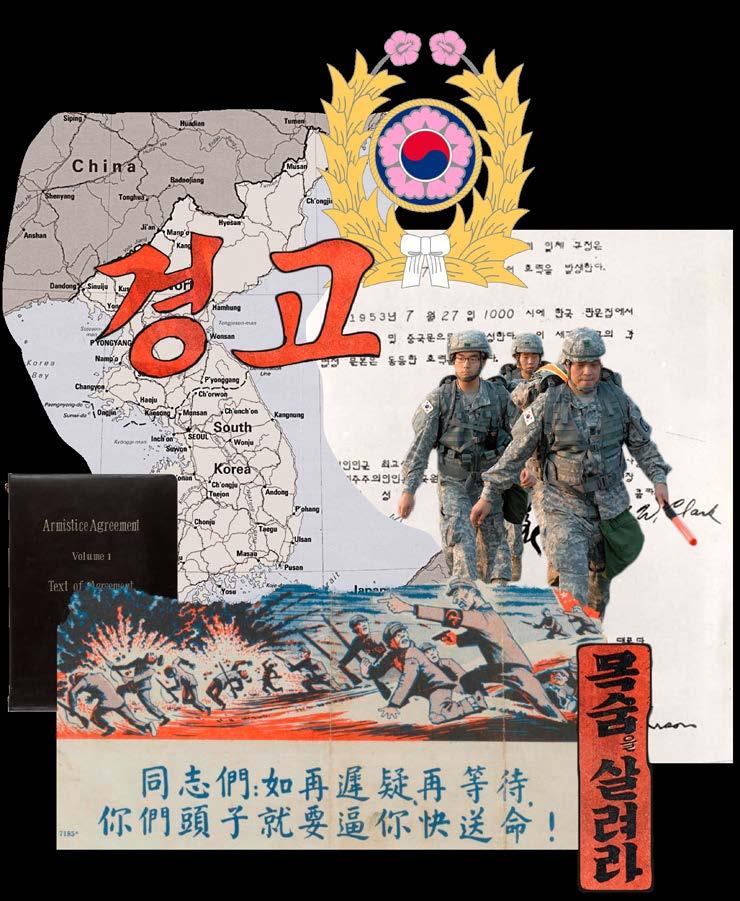
However, M, 22, pointed out that “it’s hard to view the state essentially taking away your individual rights for just under 2 years as a proper or good thing”.
Since 1957, military service has been compulsory for all able-bodied Korean men between the ages of 18 and 35. Men are typically required to complete 18-21 months of “active duty service”, which they become eligible for at the age of 18, and must commence by the time they are 28. Active duty means that men are engaged full-time; they usually live on a military base, and can be deployed at any time.
These circumstances are mandated by two legislative clauses: Article 39
Audiences abroad are seldom exposed to the topic of Korea’s mandatory enlistment outside the context of the North Korean threat or celebrity-focused media (forcing an inevitable pause to male K-pop idols’ careers, for instance). In recent years, however, these historicallyrigid laws have seen escalating challenges – most recently, by a rapid succession of conscription-related legislative changes since 2020, as well as intensified public debate around conscientious objection, alternative service, and exemption.
Within this context, Honi sought out three students from Seoul National University (SNU) in order to glean what young Koreans today think about mandatory military service. Receiving their insights would not have been possible without the help of my friend Sneha, a USyd student studying at SNU, who translated my questions, located the students, and recorded their answers for me, or my friend Alfred, who translated them back into English.
Two men aged 21 and 22 and one woman aged 21 participated. When asked about their feelings towards conscription, all participants believed it was a “necessary evil” to combat the threat of foreign invasion or interference.
“Looking at the overall global situation, I believe national defence is no longer a choice but a necessity,” said M, 21.
“[Mandatory military service] was created after the division of the country post-Korean war,” added F, 21. “I consider it to be an institution for preparing for war and a speedy reaction to emergency situations.
The history of South Korea explains much about this mentality; geopolitically, it is crowded by economic and military superpowers like China, Russia, Japan, and the US. It shares a militarised border with an aggressive and arcane enemy. Its modern iteration arose from violent and culturallydestructive foreign conflicts and occupations, experienced by just one or two generations, many of whom are still alive today.
M, 21, attributed “historical
“Especially in today’s [Korean] society, where liberty and individual freedom is so important and stressed, military service can essentially be viewed as a conservative interruption to this [liberal society].”
South Korea has been a democratic country since 1987, prior to which the democratisation movement was violently suppressed by its military dictatorship for several decades. Despite this, conservative politics are generally more dominant in contemporary Korea. The polity has elected five conservative and three liberal presidential administrations since the establishment of democracy, with its most recent election in March of this year replacing Democratic Party of Korea president Moon Jae-in (liberal) with People Power Party’s Yoon Sukyeol (conservative) by a mere 0.8 per cent margin.
M, 22 concluded: “We need to find a way forward [with conscription] that infringes on individual rights as little as possible with consideration of the opinions of everyday citizens.”
Presently, several situations exist wherein military service may be legally eschewed: if a candidate is not physically fit to serve, or if they are an extremely accomplished athlete (usually Olympic) or classical musician, whose career may be a valid measure of national contribution.
However, these laws appear to be pregnant for revision. The possible exemption from service of K-pop boy group and global phenomenon BTS has been a tendentious national topic since 2020. That year, the South Korean government revised its military service legislation to accommodate the group –dubbed the “BTS Law” – by permitting K-pop entertainers possessing government cultural medals (BTS being
HONI SOIT WEEK ELEVEN 202210 | CONSCRIPTION
Zara Zadro speaks with three Seoul university students on conscription.
“All students believed [mandatory service] was a ‘necessary evil’ to combat the threat of foreign invasion or interference.”
“...technically, the Korean Peninsula is still in a state of war...”
the only idols meeting that condition) to defer their enlistment until they are 30. This allowed the eldest member of BTS, who was turning 28 at the time, to continue his career.
Interestingly, most of the SNU students disagreed with granting idols such concessions.
“These idols are working for their own economic benefits first and foremost, and any additional benefit to the state from fans who come as tourists is not the main benefit – it’s just an unintended secondary benefit,” argued M, 21.
Both men felt that national service, instead of occurring as a side effect of fame, should be deliberate, measurable, and “contribute directly to the state”.
In early October of this year, South Korea’s culture minister Park Bo-gyoon said his ministry will decide if BTS will be exempt from active military service altogether by December, after which point the band’s eldest member will turn 30, and must, under normal circumstances, join the army.
A private survey earlier this year revealed that about 60 per cent of respondents supported the military exemption for BTS members. This is an increase from a similar survey in 2020, which showed that only 46 per cent backed the exemption, while 48 per cent opposed it.
The BTS situation intimates the broader national identity-shaping role fulfilled by conscription laws in South Korea.
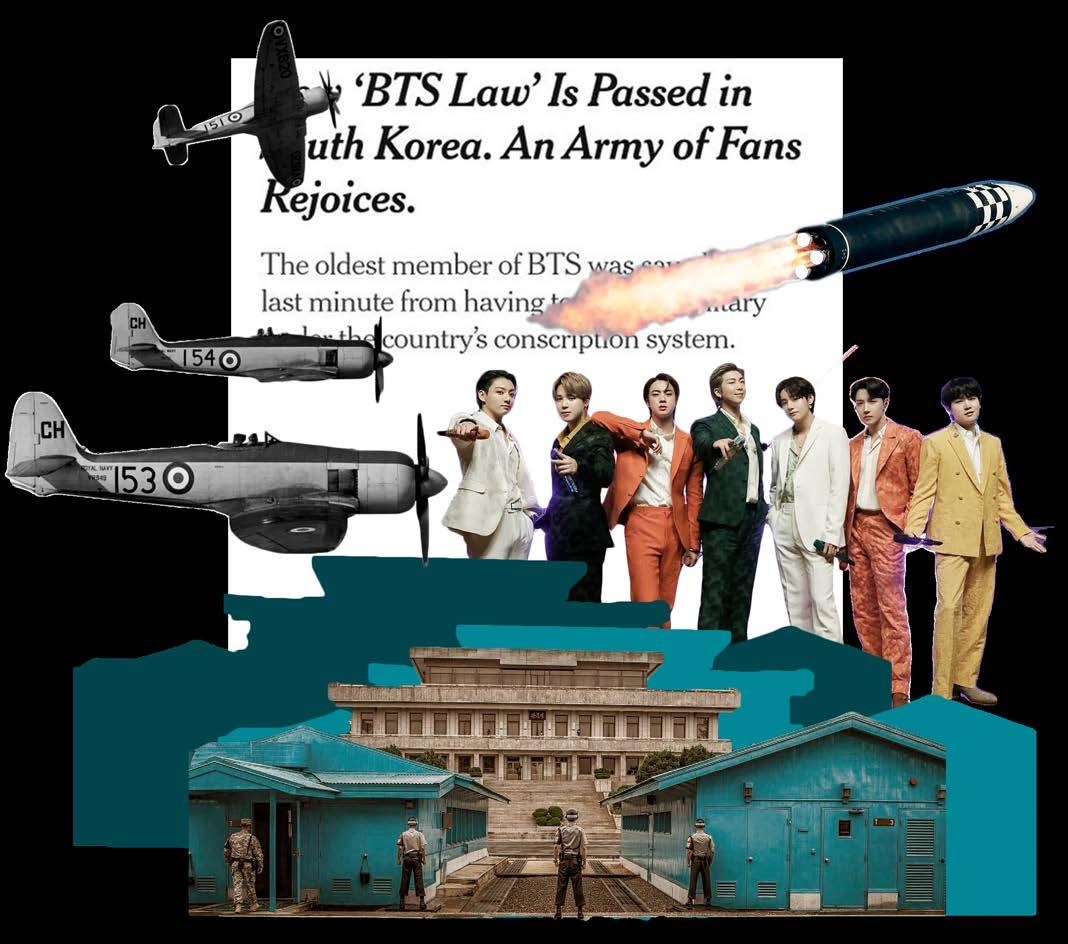
According to M, 21: “Not just the current generation, but from the Korean Peninsula’s Gojoseon (ancient Korean civilisation) era to today’s Republic of Korea, those who have been conscripted have been led to believe that [military service] is a noble act — as a kind of glamorisation and brainwashing.”
government dropped charges for the first time against a citizen rejecting military service (including alternative service) due to Jehovah’s Witness beliefs.
Pointing to this case, F, 21 said: “It’s hard to receive exemption from the courts and be tolerated as a minority in objection to military service. Even if it is exempted by the courts, one would find a lot of social stigma from evading military service.”
Of course, viewing conscription through the narrow frame of national defence omits its use as a persuasive ideological tool of the state.
and militarily powerful to make sure we can defend ourselves and have a distinct culture among other major players,” he told me.
“That being said, I think conscription is now unnecessary and inefficient. Korea is one of the wealthiest and most technologically advanced countries in the world. I think regular recruitment and investment into defence tech (which the government has really ramped up) is enough,” he said.
The SNU students had mixed reactions to the single-gendered model of conscription. While the female student believed women could demonstrate state service through non-military means, male participants believed it was unfair or unconstructive to the purpose of national defence.
The current jail time for conscientious objectors in Korea is 18 months. In 2020, the government introduced an ‘alternative service’ system, wherein those refusing military service on religious or other grounds are required to work in a jail or other correctional facility for 36 months, making it one of the longest alternative services in the world according to Amnesty International. Since the 1950s, some 19,000 conscientious objectors have been incarcerated in South Korea, some of the highest rates worldwide, with the majority being Jehovah’s Witnesses.
When asked about whether those evading military service should be punished, all students answered in the affirmative. M, 22, argued that widespread evasion of military service “would threaten the existence of the state - and so, it’s inevitable that the state would have to punish it.”
In August of this year, the
According to a 2018 article by Korean scholar Ihntaek Hwang: “[South Korean] conscription has enabled nation-wide militarised political education, attempted to impose false ideals of equality, and provided the public with an ideal masculinity. This leads to the observation that the state’s imposition of who gets to be ‘us’ and who gets to be ‘them’, a key idea of national security, has been heavily influenced by conscription.”
While the South Korean government and its highest courts have repeatedly criminalised objection to mandatory military service in the name of national security, Hwang claims that “‘national security’ is a discursive construction, subject to change, as history is never short of examples of insecurities committed in the name of national security.”
I spoke to a Korean-Australian friend at USyd, who is a dual citizen, and believes that the current military service model is flawed.
“[Among Koreans] there’s this feeling of needing to be economically
“We’ve seen from the UkraineRussian war that in the modern age, it’s not manpower but technology and sophisticated weapons that win wars.”
Korea currently ranks eighth in the world in weapons exports, with its share of the global market nearly tripling over the past five years to 2.8 per cent.
“Also male recruitment is creating huge issues with antifeminism and misogyny recently,” he added. “A lot of young men feel like they’re taking on an unfair burden (true) but are going about blaming women in nonconstructive ways.”
South Korean national identity and gendered ideals are unequivocally intertwined; conscription, as an ideological tool, inevitably shapes both. Insook Kwon, a former South Korean labour organiser and the first woman to bring sexual assaut charges against the Korean government, argues in a 2020 article that mandatory military service stabilises the idea that “men sacrifice their personal interests for the larger-framed interests, which women do not.” With feminism still a relatively controversial and misunderstood movement in the country, it is ostensibly harder for such ideas to enter the mainstream.
Clearly, mandatory military service remains generally favourable among the group of highly educated young South Koreans interviewed. However, the tide appears to be turning towards a more flexible model of national service in recent years, with the legalisation of alternative service, dropping of charges against a conscientious objector, and the BTS situation. However, there is little to suggest that this trend will continue or be welcomed by the Korean public. As South Korea strives to fashion itself into a principal world power, its parallel socio-cultural transformation is only beginning to find its feet.
ART BY ZARA ZADRO
CONSCRIPTION | 11HONI SOIT WEEK ELEVEN 2022
“Viewing conscription through the narrow frame of national defence omits its use as a persasive ideological tool of the state.”
“‘We’ve seen from the Ukraine-Russia war that in the modern age, it’s not manpower but technological and sophisticated weapons that win wars.”
Students' guide to dodging the draft
USyd students recount their experience of national service.
Fabian Robertson
Syria: 18 months
Hrant, a fourth year Engineering and Commerce student, is a dual citizen of Syria and Australia.
Vietnam: 24 months
Tyson*, a third year Law and Commerce student, is a citizen of Vietnam.
Singapore: 22 months
Ryan* began national service for Singapore when he was 19.
Jacinda
Ardern decides to send New Zealand troops to invade Australian shores and take over the country. Do you take up arms? Do you join the armed forces in repelling our eastern foe from across the Tasman Sea? Do you put your life on the line for our right to sovereignty?
Now, imagine the situation develops. Ardern’s troops make major territorial gains around the country — their tactical and technical superiority combined with the element of surprise (no one saw this coming) earns them wins in major battles. Tasmania is the first to go under persistent pressure from the New Zealand Navy. The Battle of Melbourne is a walkover and hostile troops make their way from the south into NSW.
The United Nations is nowhere to be seen. Ardern has the Security Council hostage over the threat of stopping sheep and goat meat exports. Australia’s military allies are sitting on their hands, reluctant to wade into a messy conflict — it turns out they never really liked us. We, as a country, are all alone.
By this point, the ANZAC spirit is well and truly dead and buried. Anthony Albanese, in his third consecutive term in government, has been making viral TikToks in body armour challenging Ardern to a 1v1 to decide the outcome of the war. But even that has been to no avail. Although reluctant to damage his extreme popularity, Albanese begins to consider a policy of conscription.
The National Service (Fuck off New Zealand) Act is passed, and every able-bodied adult is entered into a randomised draft for conscription into the armed forces. Unofficially, there are ways to get out of it. If you know the right people (perhaps you’ve cosied up to an ex-Prime Minister) and you’re smart about it, you can buy your freedom. You can also intentionally fail the medical examination and render yourself unfit for service. Or perhaps you’ll try to flee to a neighbouring country and get away from the conflict in its entirety.
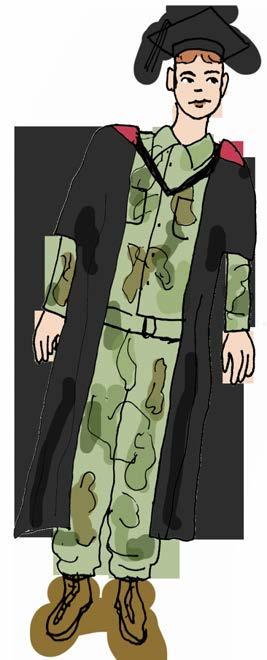
For many students at the University of Sydney today, such dilemmas are not nearly as foreign or unrealistic as you might think. Although conscription in Australia is unlikely to have any relevance outside of stupid hypotheticals, the duty to complete a period of national service is a very real requirement for citizens of certain countries around the world.
Hrant migrated to Australia in 2016, before he became eligible for military service. He is also exempt by nature of being an only child, as only children are not required to complete the service under law.
Hrant has family living in Syria, but going back carries a risk of being conscripted if he does not possess the correct documentation.
“I would need to provide proof in the form of a military document that I’m the only male child of my family. Without proof, I could be taken at the border,” says Hrant.
Since the outbreak of the Syrian Civil War in 2011, conscription into the Syrian armed forces has carried greater risk than in other countries.
“Especially in the early days of the conflict, it almost felt that if you were conscripted, you would be dropped into a random place and be at very high risk of dying. You could be put on the front line of a warzone,” says Hrant.
“Instead of having the opportunity to defend your country against the terrorists, there was a lot of fear that you would just be another victim of the conflict.”
The severity of the conflict and the risk of conscription saw many of Hrant’s male friends and acquaintances, who weren’t exempt by nature of being an only child, leave the country before they turned 18.
“Pretty much everyone I know in my class or higher years made sure they were able to leave before they were conscripted. They mostly either left to Lebanon or Armenia,” he says.
According to Hrant, wealthier citizens can also pay their way out of conscription.
“The economic condition in Syria is very bad, and paying is very expensive. I have friends who would live overseas to save up and pay after a couple of years of work. In terms of the amount required, I’ve heard figures of like 8,000 Australian dollars.”
Hrant’s Year 9 Mathematics teacher chose not to leave Syria and was conscripted to complete his national service in 2011. Soon after, the war broke out, and the army forced him to keep fighting.
“For people like him, the army would just keep you in the military for longer. My teacher was kept for eight years.”
ART BY ELLIE STEPHENSON
When he was 17, Tyson received a letter from his local People’s Committee in Hanoi informing him of his duty to complete national service. In Vietnam, service is completed at military barracks that dot the country, from major cities like Hanoi to Vietnamese islands in the South China Sea.
Anthony, however, was able to get out of service as there is a specific exemption for individuals studying overseas.
“I was overseas studying in Europe and had to notify the People’s Committee of this. Technically, because I returned to Hanoi for work, I should have had to complete my service then. Instead, my family paid ‘hush money’ to the Committee so they would overlook me,” says Anthony.
According to Tyson, the amount paid was roughly equivalent to 120 Australian dollars. By ‘dodging’ military service, Anthony is in the minority of Vietnamese males.
“The number of people who go overseas to study to ‘dodge’ is quite small. The majority complete their service willingly. I guess there is a sense of patriotism and duty – most people are happy to serve their country. People are also aware of the geopolitical conflicts around, particularly with `China,” Anthony says.
“Although I am anti-war, I see why national service has a purpose, particularly seeing that our last attempts at self-defence was not so long ago in 1989 and 1975,” he says.
Greece: 9 months
Aidan*, completing a Masters in Psychology, is a dual citizen of Greece and Australia.
When he was 19, Aidan received a letter from the Greek Government asking him to report for conscription in the city of Piraeus.
Aidan was able to get out of service by visiting the Greek embassy in Australia and showing them his travel records, proving that he had been in Greece for less than six months of his life. He then had to pay the equivalent of 120 Australian dollars.
“If you do get drafted, I think the trick is to get assigned to the Navy because then you can hang out on a Greek island for a while,” says Aidan.
For Aidan, the whole thing “seems like a massive waste of time”.
“Greece has so many problems and I don’t think being invaded is really at the top of the list. I think it comes down to some sort of legacy, some sort of tradition, but overall it’s a pretty bad indictment of Greece as a whole.”
“They call you up for a medical to deem your physical and mental status for military service. It was like how many pushups you can do in one minute, how many sit ups you can do in one minute, your BMI and a 2.4km run. The mental side of it is examined by a psychometric test,” says Ryan.
“At the end of it all, you get a grade out of 100.”
“If you fail, and don’t get over 50, you have to complete 24 months instead of 22.”
After the medical, candidates are allocated to civil defence, like policing or firefighting, or to the armed forces.
According to Ryan, the vast majority go to the armed forces: the Army, Navy, or Air Force. Ryan was allocated to the Army, where he became a Combat Engineer on service boats. National service in Singapore is paid depending on your rank, and Ryan, who became a Second Class Sergeant, earnt the equivalent of 1,300 Australian dollars.
“I think my vocation was pretty good in terms of welfare. Luckily, Singapore never needs to fight in actual conflict, so all of it is just training,” says Ryan.
According to Ryan, there are no legitimate means of ‘dodging the draft’.
“You can fake mental health issues, such as depression and anxiety. Many are exempt because they realise they have a heart condition at the medical,” he says.
Even for Singaporean sportspeople, true escape from national service is impossible.
Joseph Schooling, gold medal winner in the men’s 100m butterfly at the 2016 Olympics and Singapore’s only gold medal winner in history, is currently undergoing military service.
Members of the aristocracy are not exempt either. Ryan is aware of a notable case where the grandsons of a Three-Star General in the Army were given the most prestigious rank and position upon entry into national service. Still, they were not completely exempt. Individuals like these are known colloquially in Singapore as ‘white horses’.
“White horses get really good positions in the military – either very prestigious positions or very cushy jobs,” says Ryan.
Ryan was hesitant to express an overt opinion on the requirement to complete military service, but noted it was something ingrained in the culture of Singapore.
“There are other countries who might have a current war threat, but Singapore really doesn’t. They’re taking away two prime years of your life, when it’s not necessarily needed.
“The manpower might be better directed towards infrastructure or other forms of public service,” he says.
HONI SOIT WEEK ELEVEN 202212 | CONSCRIPTION
George Gittoes and Hellen Rose have been to the most dangerous, hard-toreach places on Earth. The pair meet and document the real people, real stories, and authentic traumas of communities caught in conflict. Whether the war is between nations or city blocks, George and Hellen have forged lasting relationships in their endeavour to connect with people in the midst of war and violence.
George and Hellen sat down with Honi over a number of video calls to give insight into the work that has taken them across the globe, chasing conflict instead of running from it.
Most recently working in Jalalabad, Afghanistan, George sent Honi live dispatches of his time meeting with Taliban leaders and working alongside the local community, as well as those written during his five months in Ukraine earlier this year with Hellen.
“We would create something out of destruction,” said Hellen, referring to her documentary and artistic work in Ukraine.
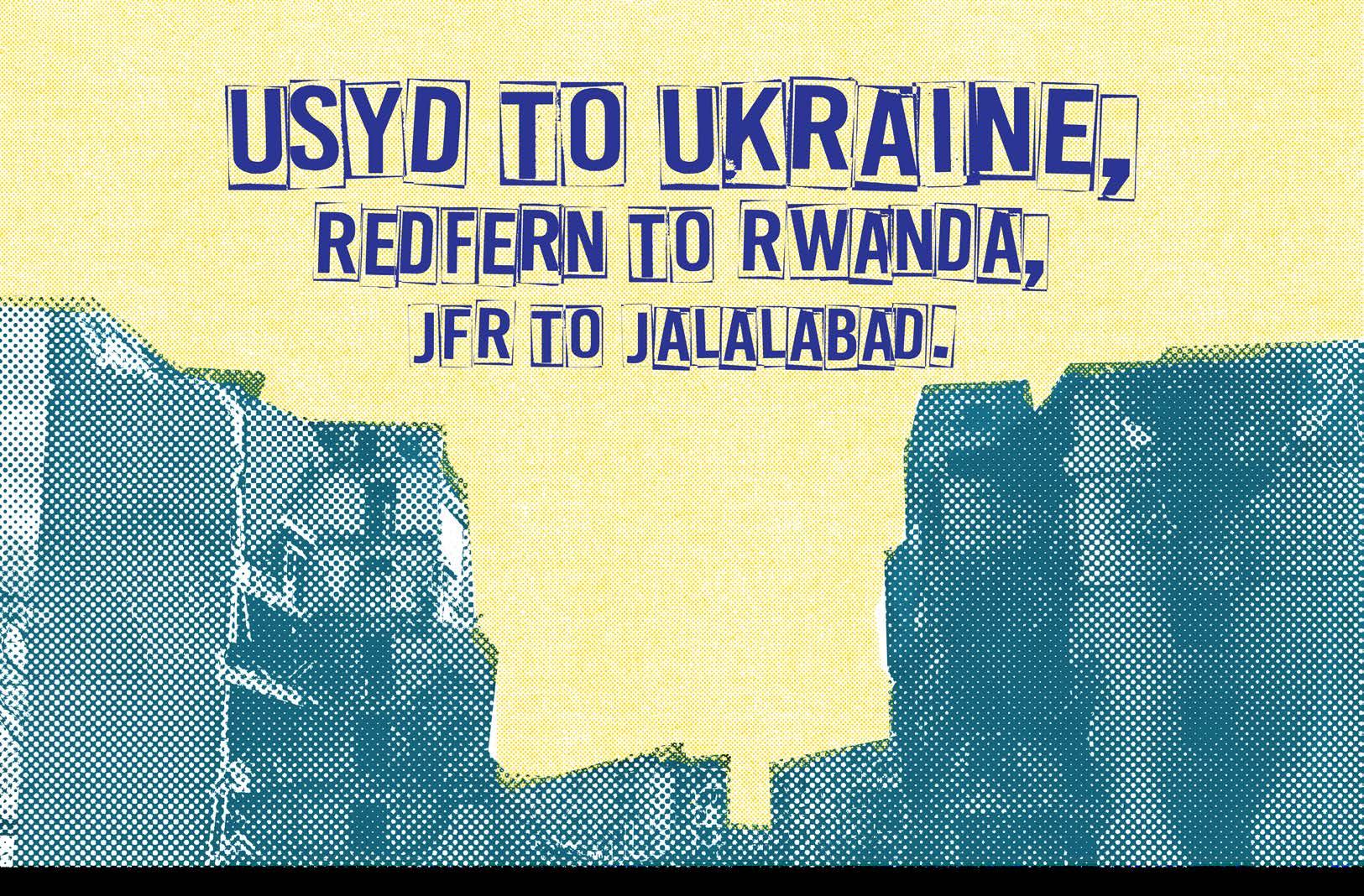
“With the arts, what you do is aim invisible golden arrows at the heart of evil.”
Documenting destruction and loss is a foundational element of the pair’s work, and is vital not only as art in its own right, but as a precious and widereaching historical record. Their art varies widely in form — George creates drawings and paintings, while Hellen is primarily a performance artist and musician. While travelling, the pair produce poignant films together, spanning both documentary and entertainment genres.
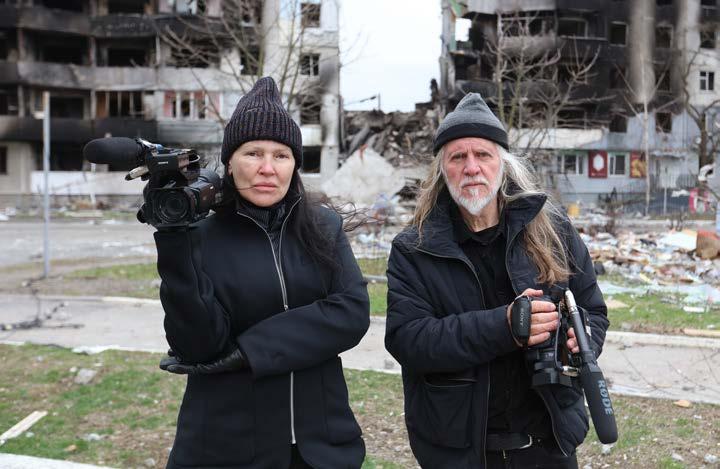
the Kibeho massacre was “the harshest experience of my life.”
The Kibeho Massacre took place on 22 April 1995, with the Rwandan Patriotic Army killing over 4000 men, women, and children at an overcrowded camp for displaced people following the genocide.
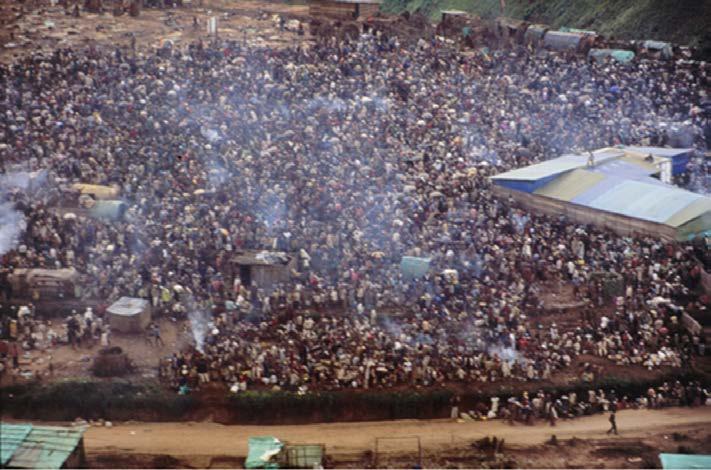
“As I hitched a ride back to Kigali in a military ambulance, I looked over to the two paramedics,” George writes.
He remembers thinking at the time “‘this has been a terrible thing to see but if we had not been here, those we have managed to save would be dead. Plus, I have the films and drawings in my bag which will mean the atrocities committed in this massacre will not be forgotten or hidden.’”
The United Nations went on to use his photographs as evidence in a war crimes investigation.
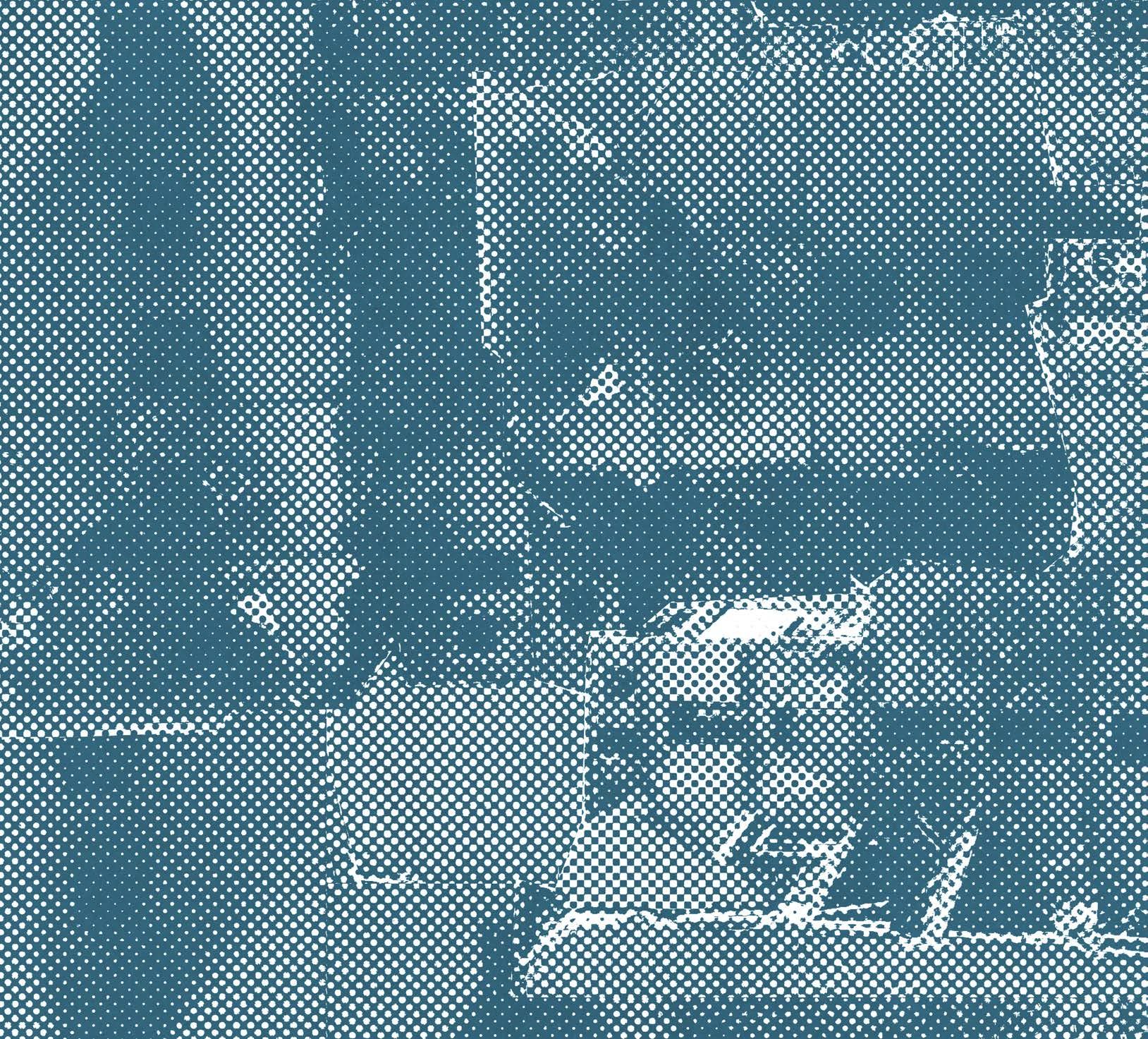
Hellen and George do not travel with ‘fixers’ who typically forge a safe path for visiting journalists. Rather, they go solo, with cameras in hand, journeying through war zones with the support of locals. Their work straddles the line between art and documentary, with George noting that he is “trying to push the [documentary] medium” to create a new form.
Alongside producing their own art, George and Hellen facilitate the art practice of the communities they enter. From adapting bombed cultural centres in Ukraine to building institutions from the ground up in Afghanistan, the duo have taken collectivised, community-based art from 70s Sydney squat houses to the world.
Speaking to his work documenting the Rwandan genocide, George writes that
George Gittoes: The killing fields of Kibeho, Rwanda and Australian Forces in the field Kibeho, Rwanda.
But they are not without critics. The pair have faced pushback from mainstream media — including a producer who allegedly threw George’s breakfast in his face and decried him as “an insult to documentary filmmakers” — as well as local armed forces.
KATE PARUNOVA: ROSE AND GITTOES
FILMING IN BORODYANKA APRIL 2022
GEORGE GITTOES: THE KILLING FIELDS OF KIBEHO, RWANDA
“The United Nations went on to use his photographs as evidence in a war crimes investigation.”
What makes two documentaryartists leave Sydney for thefrontlines of war time andtime again, and how dothey make art outof destruction?
ThomasSargeant&AmeliaKoen interviewpractisingartists GeorgeGittoesandHellenRose.
FEATURE | 13WEEK ELEVEN 2022
The Early Days on the frontlines: ukraine
George and Hellen’s work establishing art collectives started locally in inner-city Sydney. They founded pivotal institutions such as the Yellow House Artist Collective in 1970, and The Gunnery in 1985. However, their roots lay even closer to home — right here at USyd, and even within this very rag, Honi Soit
George attended Kogarah High School for a short time, before being expelled for “refusing to conform” he tells us, and moving on to Kingsgrove North. At age 19, and on a Commonwealth scholarship, George enrolled in an Arts/Law degree at USyd and attended a Power Institute lecture on campus by guest lecturer Clement Greenberg — a seminal figure of American art criticism who worked with artists including Jackson Pollock and Willem de Kooning.
Greenberg made an indelible impact on George’s career after seeing some of his paintings, remarking, “Shit man you are cool… this place is too far away, you’ve got to come to New York.”
Go to America he did. During his time there, George met and worked with Andy Warhol at The Factory, and spent time with Civil Rights Artist Joseph Delaney who introduced him to the Black Panthers.
In late 1969, George returned to Sydney and didn’t return to university — but he admits that “one year at Sydney University taught me intellectual disciplines…that have been incredibly valuable to me for the rest of my life.”
George continued to interact with USyd throughout the 70s by contributing art to Honi. “Everyone was on our backs to give
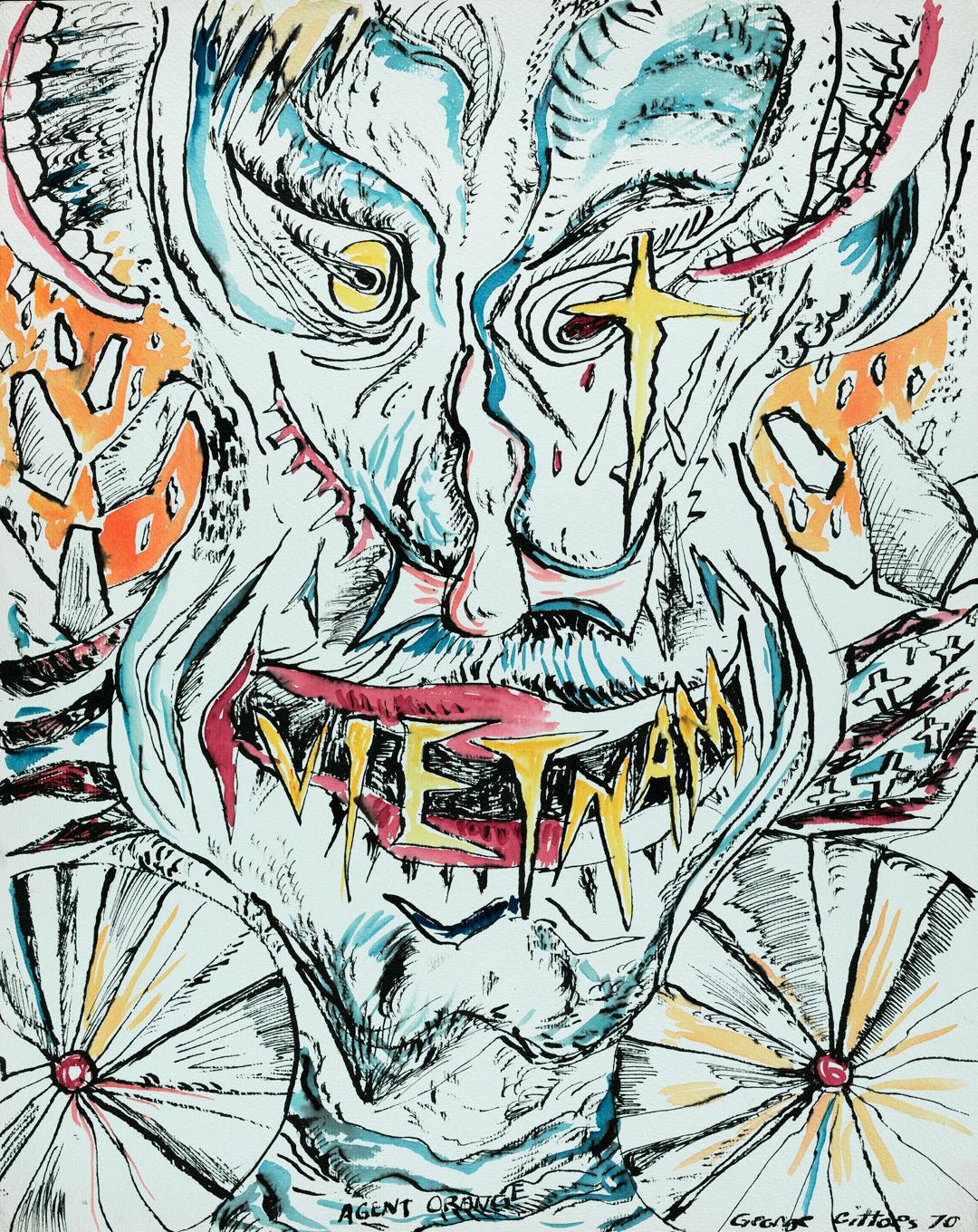 (L-R) GREG WAITE: GEORGE GITTOES IN HIS ‘PUPPET ROOM’ AT THE YELLOW HOUSE KINGS CROSS GEORGE GITTOES: AGENT ORANGE
(L-R) GREG WAITE: GEORGE GITTOES IN HIS ‘PUPPET ROOM’ AT THE YELLOW HOUSE KINGS CROSS GEORGE GITTOES: AGENT ORANGE
them graphics in those days of protest against the establishment and the Vietnam War,” he said, even UNSW’s student newspaper Tharunka. A notable poster he made for Honi during this time was Agent Orange (1970), which depicts President Nixon as Agent Orange personified, in response to the raging Vietnam War (image above right)
The poster has since been bought at auction by the Australian War Memorial with the funds going to victims of Agent Orange.
In 1970, he founded The Yellow House (YH) alongside a group of artists including Martin Sharp and Brett Whiteley. Today, the house is considered fundamental to the zeitgeist of Sydney’s ‘70s art world, pushing the envelope of style and substance. It served as a haven for artists to live, work, and collaborate, and was the first of its kind in Sydney. The YH community staged multi-media events, exhibitions, and performances, and left their vibrant mark on the house itself (image above left).
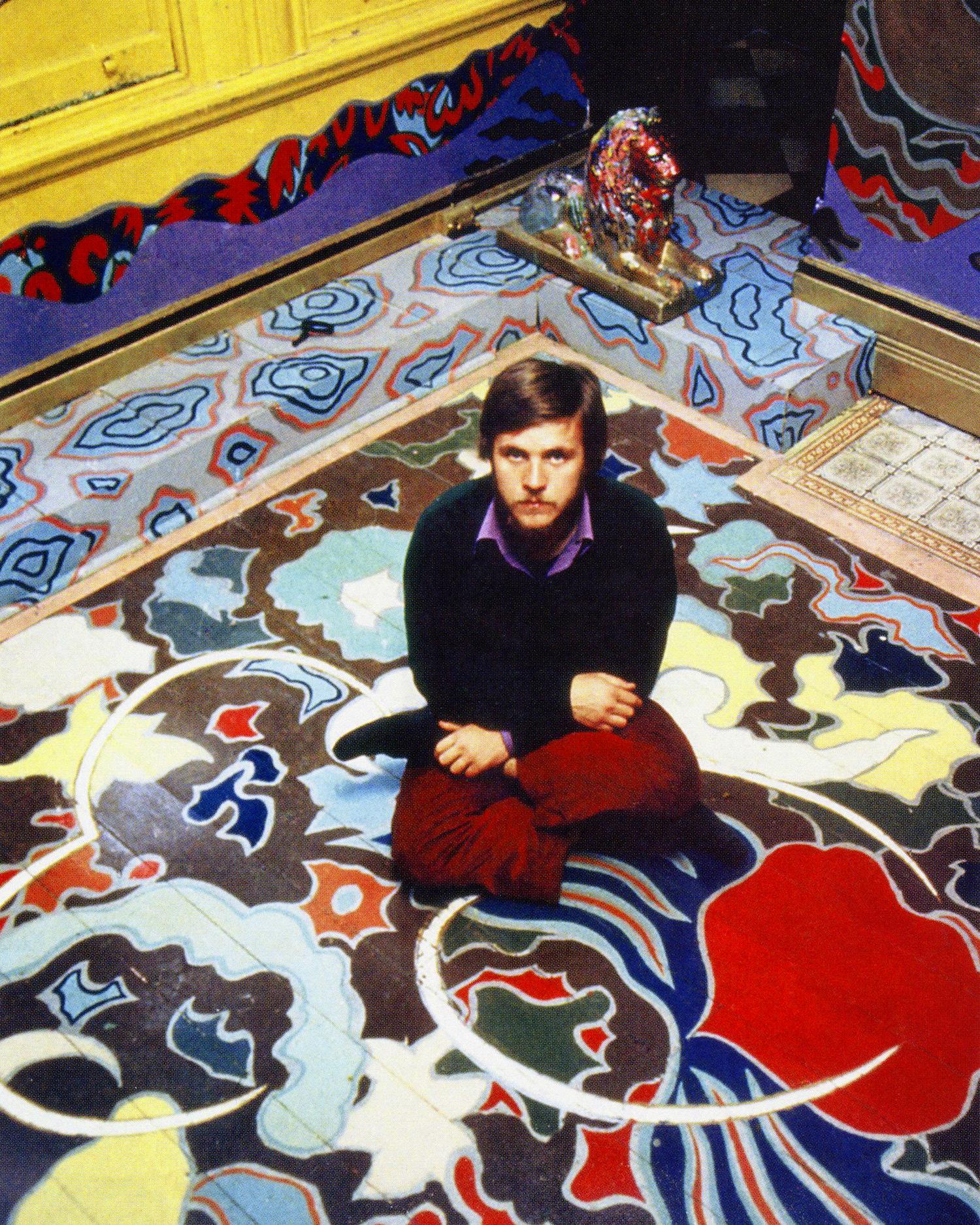
The Gunnery was built at the turn of the 20th century; first, as a storage space for The Sydney Morning Herald, and then, when World War II began, as a defence and naval space by the Commonwealth Government. In the ‘70s, Sydney Punks transformed it into a countercultural haven.
More than forty years later, Hellen and George have since cemented themselves as a formidable artistic team. Working together from circa 2008, they have worked to establish Yellow Houses across the globe where they both create art themselves and facilitate the art-making of local residents. On the decision to continue making art in warzones for so many years, George was resolute.
“I saturated the media with my photos and stories about Rwanda but no one did anything to help fix the situation there,” George tells us. “So I changed my whole attitude and decided, and so did Hellen, that the only way to bring about positive social changes in these places, like Afghanistan, is to actually work there and do real things.
“It’s not enough to be a witness and an observer and bring that back to the lucky country of Australia.”
Most recently, George and Hellen have been working on the frontlines of the Russian Invasion of Ukraine. Packing bags full of cameras, canvas, paint, and musical instruments, they entered the country in order to document the war’s true impact on civilians and help in any way that they could.
The pair began their journey to Ukraine with a flight from Australia to Poland. The Australian Consular authorities had warned the artists that they would be crossing the border at their own risk, and against the wishes of the Consulate.
Similarly, George’s now-wife Hellen was a key organising member of The Gunnery squat in Woolloomooloo in the 1980s; to our delight, she used to advertise the famed artist-performance space in Honi
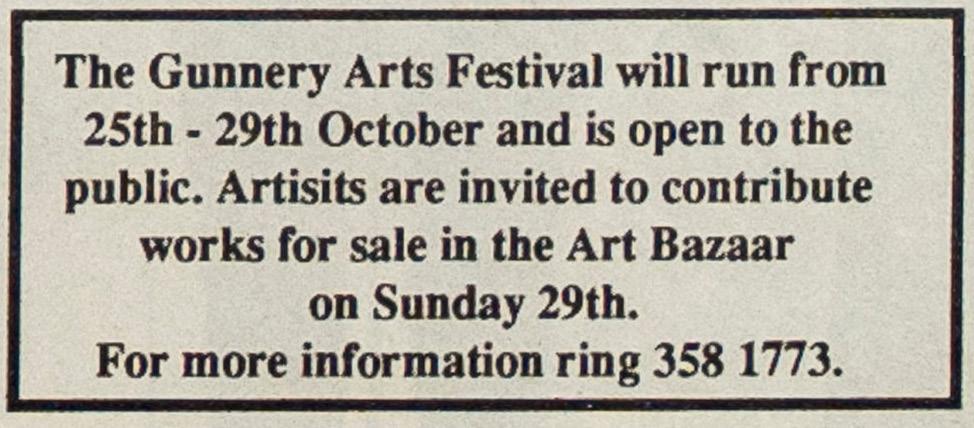
“Honi Soit was always incredibly supportive of what we were doing down there, and of course some of us went to Sydney Uni,” she tells us.
“[We] had four band rehearsal studios, [and] we had the big cinema at the top,” explains Hellen. “That was a venue. We had the shoebox theatre … It had a pit, so the audience was in the pit. We’d often have these wild cabarets with people who are all working in the ABC now.”
Despite the glamour of parties and thrill of rock-and-roll, Hellen emphasised the danger that residents of The Gunnery always co-existed with: “We were quite desperate to have somewhere to live… it was a homophobic world that we lived in. It was a rigid, unaccepting world.”
“The police absolutely hated us.”
Hellen tells us stories of waking up surrounded by police with German Shepherds, her friends being discriminated against and beaten in the streets, and criminals attempting to take over their space.
The Gunnery was only fortified by numbers — “we banded together … we were the most attended venue in Sydney at the time” — which meant they could “create [their] art, and also demonstrate against the horrors of the world that we were subjected to and many of our generation [were subjected to],” Hellen says.
“And that’s where I met George Gittoes.”
The Polish city of Przemysl lies just over 200km from the Ukrainian border. It was here that George and Hellen began their journey, hoping to catch a train across the border to Lviv before transferring trains to the Ukrainian capital, Kyiv.
At 3am on the Poland-Ukraine Border, George opened his laptop and wrote a dispatch. Hellen had already paid in advance for a hotel in Kyiv, and the couple planned to board a train there at 7pm the next night.
“The International media crews from the likes of BBC and CNN stay at big 5-star hotels with good facilities and hardened bomb shelters,” he writes.
“I value an atmosphere clear of speculation and hype. We will be with the locals – no one at the hotel we have booked speaks English.
“Hellen is writing in bed next to me, both hoping this will make us tired enough to go back to sleep. At any moment I could roll to my side and suggest to her we get a plane home, that what we hope to achieve is not worth the risk.”
George and Hellen did not go home. That following evening, George trawled the train platforms of Przemysl searching for an opportunity to cross the border. Eventually, a train arrived full of refugees who had just fled Ukraine.
“They were mainly women, children with family pets in carry cases, worried eyes peering out. Mateusz [a Polish mining executive] talked with them, and we realised there was a chance the train would be going back.”
HONI SOIT WEEK ELEVEN 202214 | FEATURE
HONI SOIT 1989, ISSUE 20
“We’d often have these wild cabarets with people who are all working in the ABCnow.”
“Honi Soit was always incredibly supportive of what we were doing down there, and of course some of us went to Sydney Uni.”
George retrieved Hellen and their luggage from their car, rushing to passport processing. An English-speaking officer asked the pair, “but aren’t you afraid?”
Regardless of personal emotions, George later wrote that their motivation for persevering in the region was “to support the Ukrainian fight for creativity and freedom and independent thought.”
George wrote: “we made it in with the help and sympathy from [the Englishspeaking officer] and other female army officers who loved the idea we were Australian and artists. We had no tickets but that did not matter. We were ushered to a sleeping cabin in the last carriage and soon we were on the way.”
True to their word, George and Hellen arrived in Ukraine completely alone at the start of March of this year — no security, support team or bomb shelter, just a hotel booking and their luggage. But most importantly, they had their reputation as artists.
A Ukrainian local and pet photographer, Kate Parunova, reached out to George and Hellen on Facebook. Kate hoped that by sharing the true stories of Ukrainians in the warzone, she could help secure foreign support to defend her country. She had spent the early days of the war feeding dogs and cats across Kyiv, as many residents were forced to abandon their pets in the process of fleeing the country.
Kate met with George and Hellen in Irpin, a Ukrainian city just outside Kyiv. The three of them worked together to keep feeding animals in the region, with George and Hellen putting their artmaking on pause to assist Kate.
“Parallel with our film, the dogs became a priority,” George told us.
While working in Irpin, Kate was forced to delay her work in order to rescue her grandmother, whose neighbouring apartment had been bombed. Kate helped her to cross a bridge over the Irpin river to escape the city, and soon called George to tell him what had happened:
‘George, everyone’s been killed on the bridge, there’s been a terrible massacre,’ she said. Local residents would go on to refer to the incident as the ‘bridge of death’.
George, Hellen and Kate were some of the first people on the scene. George told us that this experience would have been “very hard for Kate, because she would’ve known the women and children and babies that were in the cars that had been killed.”
Some of the cars had words in English and Cyrillic written on the side, such as ‘stop’, ‘evacuation’ or ‘children’. The cars were bombed and shot regardless.

in Lozova, was bombed. President Zelensky said of the missile attack: “Absolute evil, absolute stupidity…The occupiers have identified culture, education and humanity as their enemies.”
Walking the streets of Irpin, George and Hellen were met with “house-by-house destruction”, and described the Central House as having been “made a target with every kind of ordinance in the Russian Arsenal”. The duo resolved to adapt the ruined structure as a workspace and curate an exhibition of 90 works by Ukrainian artists, dubbing their creation ‘The Yellow and Blue House’.
always love about the Punk thing: it’s so brazen. It’s ‘cut through the bullshit’. It says ‘you are telling me I can’t do this, but hang on a minute, I’ve got my own brain. I’ve got my own thoughts. I’m going to do it.’”
The duo’s work in Irpin — bringing back visual culture and art to the site; a vein of cultural lifeblood decimated and abandoned by war — is entrenched in this mentality. “It’s about taking action…We can be leaders in any way that our imagination can conjure,” says Hellen.
George described the pair’s work in Ukraine as a part of their ongoing “war on war” that has taken them across the globe.
George wrote in a dispatch about the experience that “it has been a long time since I have experienced something as damaging as the Kibeho Massacre in Rwanda but the Bridge of Death at Irpin comes close.”
“Those who remained alive were executed in or near their cars,” George wrote in April this year. “The smell of death was overpowering.”
Many of the bullet-ridden cars also contained children’s toys and clothing. George describes one car that had an “expensive-looking book resting on the driver’s seat.” The book was a diary, dated until April 9th — “it ended the day the writer’s life ended.”
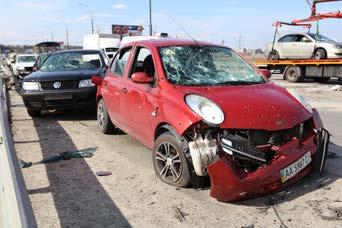
The bridge of death would not be George and Hellen’s only encounter with destruction and loss in Ukraine on such a grand scale.
On 17 March, the Central House of Culture in Irpin, standing between Russian forces and the capital city Kyiv, was the target of a devastating artillery attack. The house was built by locals in 1954 as part of the post-WWII reconstruction of the area, and was home to creative studios and classes, language clubs, concerts, performances, and public events.
Only two months later, on 20 May, another cultural centre, the Palace of Culture
Not only did George and Hellen bring the House of Culture back to life in defiance of the Russians, both produced artworks on the site. George painted several oil works from within the rubble and destruction, and Hellen staged and performed her work Armies of the Fallen
In a dispatch, George wrote that while completing his painting, “returning residents of Irpin passed [by him] all saying how glad they were that art is happening again in this place of culture.”
Hellen also described one such encounter, in which some children arrived at the House of Culture after having “just come back to Kyiv and [seeing] their city just destroyed.”
Displayed on one of the walls was a caricature of Putin that George and Hellen had purchased from a market in Odessa. Hellen recalled one of the children punching the face of the artwork, as another asked why she was in Ukraine and what the exhibition’s point was.
“I said [to them], ‘Australian children think that Ukrainian children are the bravest children in the world… so George and I are here to stand with the people of Ukraine, and help the people of Ukraine tell the world the evil that’s going on.’”
Critically, Hellen expressed to us that the duo aren’t merely ‘war artists’, but rather “caretakers of culture and… caretakers of the soul”.
“Going into the destroyed house in Irpin was easy, it was ‘great we’re here again’, and finding everything that I could with my performance to turn that destruction into creativity,” Hellen said, reflecting on her years of turning dilapidated warehouses into living works of art, like The Gunnery.
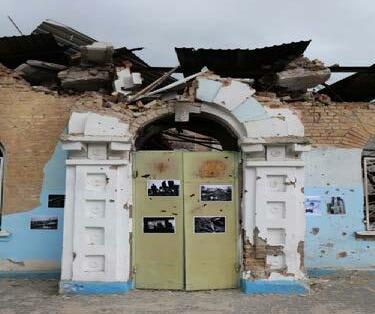
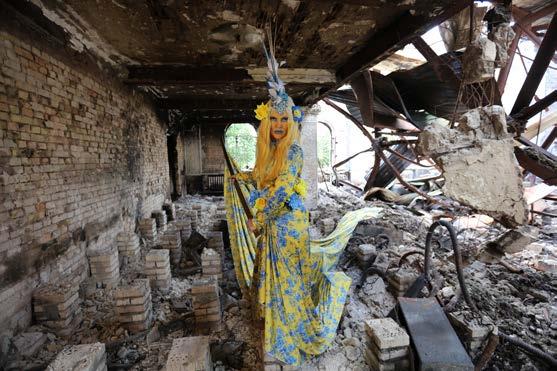
Hellen attributes much of her personal and artistic philosophy to that of the Punk politics of The Gunnery: “This is what I
After four months and having overstayed their visa in Ukraine, Hellen and George felt conflicted knowing their ongoing obligation to the Yellow House in Jalalabad, Afghanistan could no longer be put aside. George and Hellen resolved to leave Ukraine. In late June, having captured as much of the war as they could through photography, film, and on canvas, the artists left on a train out of Kyiv.
Their journey out of the country was predictably fraught. They faced a series of train delays approaching the Polish border, as the electrical contacts connecting their train to overhead wires were damaged by a missile exploding above them while they slept.
Changing plans, technical concerns, and delays to evade anticipated Russian air strikes meant that the journey from Kyiv to Poland took over 24 hours. Their train completely broke down just kilometres from the Polish border, with George and Hellen being picked up by a contact in Poland who bravely crossed the border to collect them.
“We are leaving knowing that by doing the performances and show at the House of Art in Irpin we brought a sense of hope and victory amidst the death and destruction,” George wrote during his journey out of Ukraine.
“We used art and not guns to defy the Russians and it will be by maintaining the spirit of the Ukrainian people that the Russians will be defeated.”
They immediately began the editing process of their upcoming film Ukrainistan, which they shot during their time in Ukraine. George soon made his way back to Afghanistan via Pakistan to continue his work in the region.
“The whole time we have been in Ukraine we have been conflicted knowing we are needed, possibly more, in Afghanistan.”

FEATURE | 15HONI SOIT WEEK ELEVEN 2022
(L-R) KATE PARUNOVA: IRPIN BRIDGE OF DEATH. HELLEN ROSE: IRPIN BRIDGE OF DEATH. HELLEN ROSE: BORODYANKE
“Some of the cars had words ... written on the side, such as ‘stop’, ‘evacuation’ or ‘children’. The cars were bombed and shot regardless.”
“Those who remained alive were executed in or near their cars [...] The smell of death was overpowering.”
(L-R) HELLEN ROSE: ‘VICTORY’ EXHIBITION AT THE CENTRAL HOUSE OF CULTURE IRPIN. GEORGE GITTOES: ARMIES OF THE FALLEN PERFORMANCE BY HELLEN ROSE, CENTRAL HOUSE OF CULTURE IRPIN. JUNE 2022.
Afghanistan
George first visited Afghanistan in the nineties to assist with a mine awareness program after the exit of the Russians and again in 2002, attached to Doctors Without Borders. He returned in 2010 with Hellen to begin filming the duo’s first Afghan film called Love City, Jalalabad. In the same year, they established The Yellow House Jalalabad (YHJ).
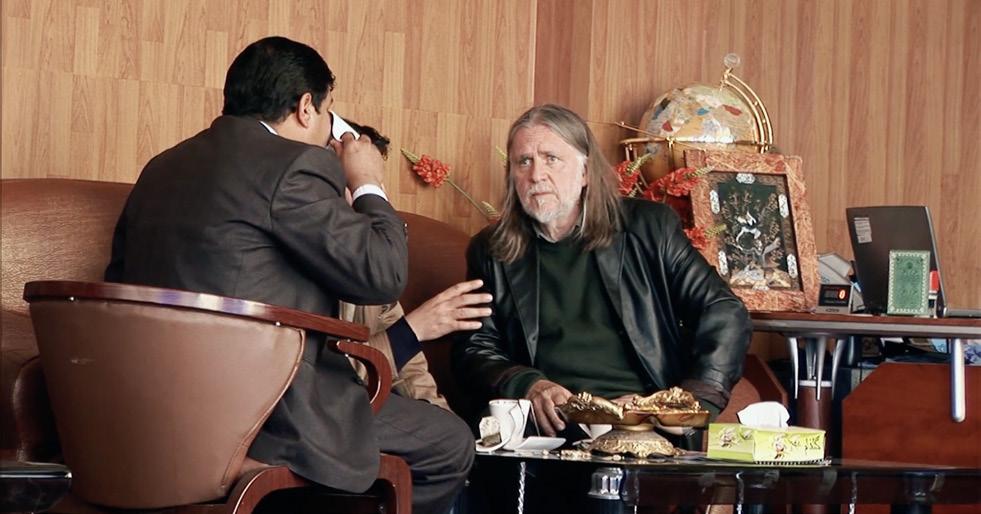
On returning to the area in September this year, following troubles with the Australian Government not providing key visa documentation, George writes in a dispatch: “I had no idea what would happen to me once I crossed the border and during the preparations to leave, I had restless nights of imagining the ways things could go very bad.”
Jalalabad is fraught with conflict, and has seen many suicide attacks over recent decades from members of the Taliban, alQaeda, and ISIS. Until the withdrawal of American troops in late 2021, Jalalabad airport had operated as a military base for NATO forces in the region.
bus when the team was alerted to the threat of a potential suicide bomber. According to George, the Taliban has since greatly increased its presence throughout the city and greatly reduced the risk of attacks such as these.
George was thrilled to eventually receive a permit from the Taliban Authorities. “The [filming permit] means that we don’t have any surveillance, anyone with us, no minders. They trust us to do whatever we like, wherever we go,” George tells us.
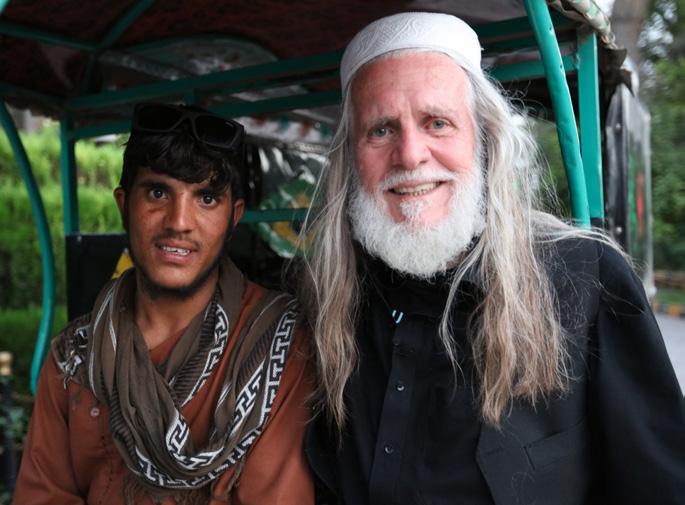
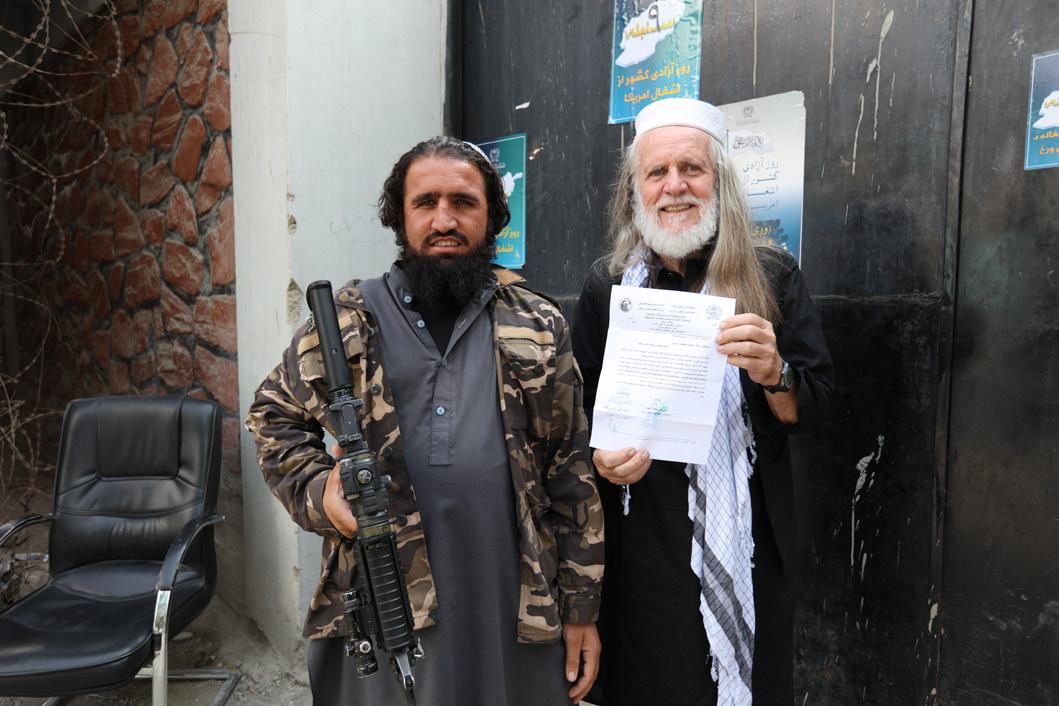
G&H’s secondary goal in the region was to ensure that the “Yellow House Arts Centre could be allowed to continue without interference,” requiring George to meet with several senior Taliban members for dinner in August of this year. Impressively, the high-pressure meetings were successful — a testament to the relationships G&H have forged with locals, their standing in the community as artists, and their astute knowledge of Pashtun culture.
Fundamentally, the documentary work they undertake in Afghanistan captures the real work they do to support the community: providing jobs, training film producers and actors and holding school classes.
In a dispatch from Jalalabad in September, George explains that he and Hellen want the Yellow House there to outlive them both, and remain an ongoing cultural centre of learning. He writes: “We see it as the most important contribution we can make as artists, more important than the paintings, films or music.”
Taliban, which means that the film does not face the Taliban’s wrath.
The goal of Talk Show is to present an influential woman with agency over her life, who reaches TV screens in local homes, and affects change through representation. All of its actors are friends and collaborators of G&H, and the film is now massively popular in the region. Its narratives deliberately mirror reality in Jalalabad’s Pashtun community — corruption, violence toward women, and importantly, love.
as theatre, music and guided meditation. Speaking to the impact of the meditation workshops, Hellen said that the women were “astounded by the power of their own mind… they’d never done anything like that before.”
While women attending the workshops initially had to be accompanied by male family members, local women are now allowed to attend accompanied only by each other after establishing trust with George and Hellen.
Vitally, Hellen does not perceive these women as victims, nor herself as their saviour. Rather, she suggests that she operates as a provider of opportunities and facilitator of learning. Hellen impressed upon us that despite “living under very difficult circumstances” including constant attacks on their schooling, “these ladies are anything but victims.”
Unlike other media produced in Afghanistan, George emphasises that “all the films that we made and are still making feature women; they’re the main characters.”
In 2014, during the filming of Love City, Jalalabad, George eschewed tradition by providing the training and tools for a 19-year-old girl, Neha Ali Kahn, to become the first Pashtun woman to direct a local film.

The goal behind YHJ is largely the same as the Yellow and Blue house in Ukraine, and the original in Sydney: to build and maintain a community of artists. However, beyond the conflict and violence in the region, the conservative culture of Afghanistan is an added obstacle. The central goal of George and Hellen’s return this year was to obtain a completely unrestricted filming permit — the first of its kind — from the Afghan Taliban to shoot their next film.
With the Taliban takeover of security in Jalalabad, it is impossible to film without permission signed and endorsed by various Ministries as well as the police, army and intelligence agencies. It has always been difficult for the pair to film on location, with crowds forming whenever cameras appear, especially when filming women.
This was harrowingly displayed by the threat of violence they faced in filming Love City, Jalalabad. While filming a marketplace scene, the actresses were hurried into their
Documentaries are not the only film projects that G&H have produced in Jalalabad; a key facet of their work in the region is creating movies and TV shows for local consumption with the help of their Afghan actor and artist friends and the Yellow House family. All these dramas feature women as lead characters, with scripts that encourage positive social change and greater equality for women.
The pair work hard to ensure these projects are culturally appropriate and have genuine local appeal; the goal is for the films to be organically picked up by residents in DVD stores and their message disseminated.
According to George, their content elevates values of progress and equality: “Everyone in the world would agree that the main social change that has to happen in Afghanistan is the improvement for women.”
A key film in this vein is entitled Talk Show, which follows a woman who is the host of a fictional Oprah-style talk show. Unlike Western talk shows, which often cover celebrity gossip, the narrative is framed around exposing corruption — a value that is shared by the Pashtun community and
Supplementing this, G&H train local women to be involved behind the camera and in the director’s chair in order to provide them with opportunities they would otherwise not be afforded.
The pair’s work with women artists extends beyond their inclusion in film, and into creative workshops at the Yellow House and the high-walled Secret Cafe. The latter arose from G&H responding to the needs of creative community leaders: “We had all the best poets and writers and actors and everything in Jalalabad,” George told us.
“I said, ‘So what do you most need?’ And they said, ‘we need a centre with high walls where we can meet.’”
The need for a meeting place for men and women to collaborate is immense. Women are not allowed to meet with men unless accompanied by a male family member, nor are they allowed to be alone in public. George explained that the Secret Cafe was established in order to enable circumstances such as a “lady poet [being able to] go and meet a male publisher and get her poems published.”
Beyond these tangible outcomes of connecting local men and women, Hellen utilises skills from her Gunnery days to run regular workshops for local women. These include physical artmaking projects as well
At one point, George and fellow artists working on the film, including Hellen and Neha, were briefly detained in a room of the City Star Hall building. The complex is host to a range of wedding halls, where the team was filming a wedding scene for the conclusion of Love City — part of a series of love-story films that challenged the practice of arranged marriages.
While filming, the artists were detained by the owner of the building who became outraged by the script’s objective. George set down his camera, while Neha continued to secretly film. Upon being asked to hand over his footage, he said “no, I won’t do that… You can get someone to come and shoot me, you can put me in jail if you like but I’m not going to do that.”
Ultimately, George was forced to hand over a number of tapes, including a large
HONI SOIT WEEK ELEVEN 202216 | FEATURE
(L-R) WAQAR ALAM: GEORGE IN KABUL, AUGUST 2022. THE YELLOW HOUSE JALALABAD GROUP, 2015. GEORGE REUNITES WITH ‘STEEL’ 2022.
“I had no idea what would happen to me once I crossed the border and during the preparations to leave, I had restless nights of imagining the ways things could go very bad.”
SCREENSHOT FROM LOVE CITY JALALABAD, COURTESY GITTOES FILMS AND PIRAYA FILMS NORWAY.
“... the actresses were hurried into their bus when the team was alerted to the threat of a potential suicide bomber.”
“No, I won’t [hand over my footage.] You can get someone to come and shoot me, you can put me in jail if you like but I’m not going to do that.”
chunk of Love City. While distressed that most of the film was confiscated, he was resolute that he made the right decision.
“My responsibility is to get the artists safely home,” he says in the film. The owner was a former Commander in the alliance that had fought against the Taliban. This situation showed George how complex it can be to navigate Pashtun Cultural Laws, particularly those emerging from conservative or ‘tribal customs’.
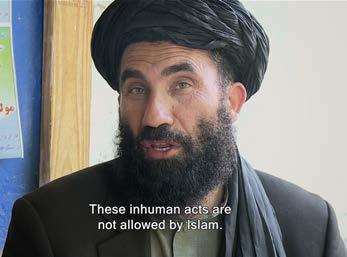

The relationship between G&H and the Taliban continued to develop when YHJ was paid a visit in 2014 by local Taliban leader at the time, Mullah Haqqani. He arrived at the house with an armed escort to meet with George.
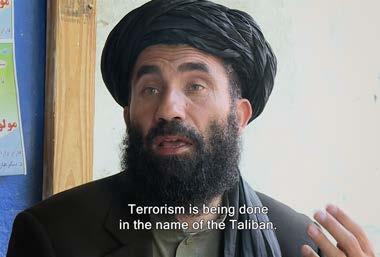
George told us that he and the Yellow House team had “got out the best tea set and the best food and everything. [Haqqani] spent a long while telling us that they’d done a big investigation into us. I thought ‘this doesn’t sound good.’”
“And then at the end he said, ‘we’ve decided that you’re a friend of the Afghan people, and we’re going to give you the umbrella of our protection. And we’ll do everything we can to help you.’”
Haqqani has since been killed by an ISIS suicide blast. G&H’s work in the region continues regardless, as they forge relationships with new leaders to continue safely operating in Jalalabad.
“I do not see the Taliban through rosecoloured glasses and I am certain they will object to aspects of my film,” George wrote to us in a recent dispatch. “But what I will be attacked for in Australia, [the] US, and Europe is showing them to be human.”
Given their now-productive relationship with the Taliban, though precarious, there is perhaps no limit to what they can achieve in the future, unburdened by the immediate threat of Taliban intervention.
with a shrill song that comprises the notes of ‘Happy Birthday’ — this is at first is unwelcomed by George, “we’ll pay you to go away”, he says.
The young boys call themselves Wari Shadi (Snow Monkeys) because “monkeys are naughty, we are naughtier,” in their words. They are soon befriended by George, seeking to bring them off the streets and into the circle of the YHJ. George tells them: “This is the Yellow House, a place where weird stuff … can happen and no one’s going to bother you. You can do painting, music, theatre, anything you like — you’re free here.”
George goes one step further and offers them employment and skills training: “We’ve been making movies, Pashtunlanguage movies, and we want to sell them in Jalalabad…do you think if we gave you some movies to sell as well as [your] ice cream, you could sell DVDs and we could give you a commission?”
The Snow Monkey’s eyes light up with equal parts joy and agreement. “This is just a start for you guys… Maybe you could all be film producers in the future — what’s the future for you guys?” George asks.
backyard of the YHJ for the Snow Monkeys to catch them up with the education level appropriate for their age. Following this, he successfully gets all eight of them enrolled in regular schooling.
Eight years on from the film, several of the boys, such as Zabi who was Assistant Camera on Snow Monkey, still work closely on film projects with George, and remain in contact with the YHJ.
In a dispatch from October this year, George told us: “We have watched [Zabi] grow from the 12-year-old of Snow Monkey to a handsome and formidable man.”
In the same letter, George also revealed that he reconnected with Steel, who has left the life of gang-related crime behind, and many more members of the YHJ: “I have been overjoyed to see all my friends again in Jalalabad with big hugs and kisses but none have been as thrilled by the reunion as Steel,” he wrote.
Future work
The stories above comprise just a fraction of George and Hellen’s work across the decades. Gittoes has worked across Nicaragua, the Philippines, Yemen, Somalia, Cambodia, Palestine, South Africa, Western Sahara, Bosnia, East Timor, Congo, Northern Ireland, Iraq, and Englewood in Southside Chicago. George reflects on much of this work in his impressive 2016 autobiography, Blood Mystic
The artists have been working on editing their Ukrainian and Afghan filmsin-progress, with much editing taking place in the Pakistan Yellow House. More recently, George returned to Australia in late September to speak alongside Hellen at the Queensland Art Gallery for the unveiling of Victory Triptych (2022), which he painted on the ground in Ukraine.
The pair have bought a house in Jalalabad, and plan on continuing their work there by setting it up as a new, permanent Yellow House.
Hellen told us that, besides this purchase, “the other surprise is that the Taliban aren’t monsters, they’re human.”
“I’m actually going to be starting up the women’s workshops when I get back. I’m going to be sitting in the head Taliban office, helping them write their [school] syllabus,” she tells us. The previous Afghan syllabus was created by Americans, and reflects the culture of the US rather than Afghanistan. Hellen spent over a decade as a senior secondary school teacher in Australia, and intends to use these skills to empower Afghan youth.
The Taliban’s aforementioned visit to YHJ was captured during the filming of Snow Monkey in 2014, eight years before their unrestricted filming permit was obtained.
The improvement of their relationship had an immediate impact on what the Yellow House team could achieve.
Snow Monkey follows the turmoil of child-gangs in Jalalabad and the exhaustive, frequently dirty labour children must do to survive. The documentary opens on Steel, the leader of a notorious child-gang, and quickly shifts to the comparatively naive boys who sell ice-cream out of little red carts in the scorching Afghan heat. Their carts whir out the front of the Yellow House
In no time at all, the boys sell out of both the DVDs (such as Talk Show and Love City) and their ice cream. Soon they tell George that they want to make a drama movie together about their lives on the streets of Jalalabad, about kids like themselves who go without protection or education and find themselves in spheres of corruption and violence.
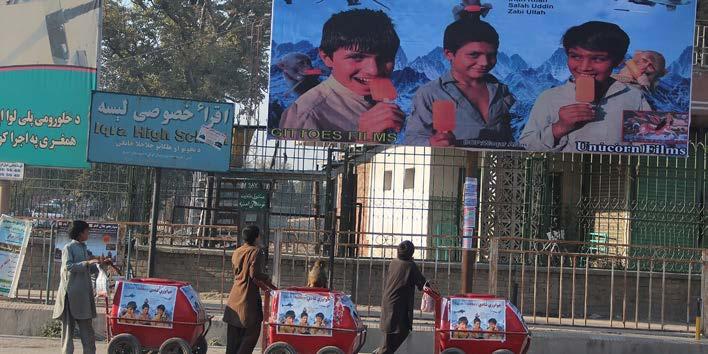
“Together we will make a film and show what goes on in this city,” says the eldest. When George asks if he wants to be in the movie, another younger member of the group says “I don’t want to plant bombs under bridges, or in mosques. We want school.”
In tandem with training the kids to operate a camera and shooting their movie, George sets up tutoring lessons in the
Each member of the YHJ who keeps it operating — cooking meals, running workshops, producing Pashtun-language films, keeping children off the street and teaching them new skills — has left an indelible impact on the surrounding community of Jalalabad. G&H have built an ecosystem of creatives within the YHJ that function and exist beyond themselves; they facilitated its creation, but it is the people of Jalalabad who keep it alive.
In the closing scene of Snow Monkey, the city gathers to watch their film projected over a frantic nighttime street, and newlytrained cameraman Zabi remarks: “For a long time Afghans haven’t seen ourselves on TV. Now we can make and watch our own films, and we are very happy”.
With the war in Ukraine now into its seventh month, and still no end in sight, George tells us that he and Hellen will have to balance their commitments by “jumping between Ukraine and Afghanistan.”
George is adamant that he has an obligation to return to Ukraine: “If [Putin] uses tactical nuclear weapons, I’ll be there the next day.”
When pressed on the danger of this situation, George tells us: “If that happens, I’ve got to be there.”
“That’s what I do. I haven’t got a death wish, but that’s just like someone who studies the Barrier Reef and learns that there’s a new outbreak of Crown of Thorns.”
“They go there to investigate it. That’s my thing, my specialty,” he said.
Despite a life and career based around war, George remains an optimist and does not believe that the conflicts he’s witnessed have no end: “If we can stop wasting money and people on war… we could make this into heaven on Earth.”
George best puts this vision into words in a Ukrainian dispatch.
He writes:
I would love to travel back to all the places I have known in their times of conflict and rent studio spaces where I can paint and Hellen can make her music, in peace. Enjoy the transformation of a world away from war.

HONI SOIT WEEK ELEVEN 2022 FEATURE | 17
“[local Taliban leader Mullah Haqqani] spent a long while telling us that they’d done a big investigation into us. I thought ‘this doesn’t sound good.’”
“I don’t want to plant bombs under bridges, or in mosques. We want school.”
MULLAH HUQQANI. SCREENSHOTS FROM SNOW MONKEY, COURTESY
GITTOES
FILMS AND UNICORN FILMS
MELBOURNE
(ABOVE) GEORGE GITTOES: PRODUCTION STILL FROM ‘SNOW MONKEY’, CHILDREN’S FILM ‘WARI SHADI’ ADVERTISED IN DOWNTOWN JALALABAD 2015.
“If [Putin] uses tactical nuclear weapons, I’ll be there the next day.”
‘BRIDGE OF DEATH’ ‘RUSSIAN BEAR’ ‘THROUGH THE GLASS’
Honi goe s
A trip throug h
The editors, writers, and contributors of Honi Soit have witnessed 93 years of war: the Second World War, Spanish Civil War, Korean War, Vietnam War, The Troubles, Gulf War, Iraq War, and all those in between.
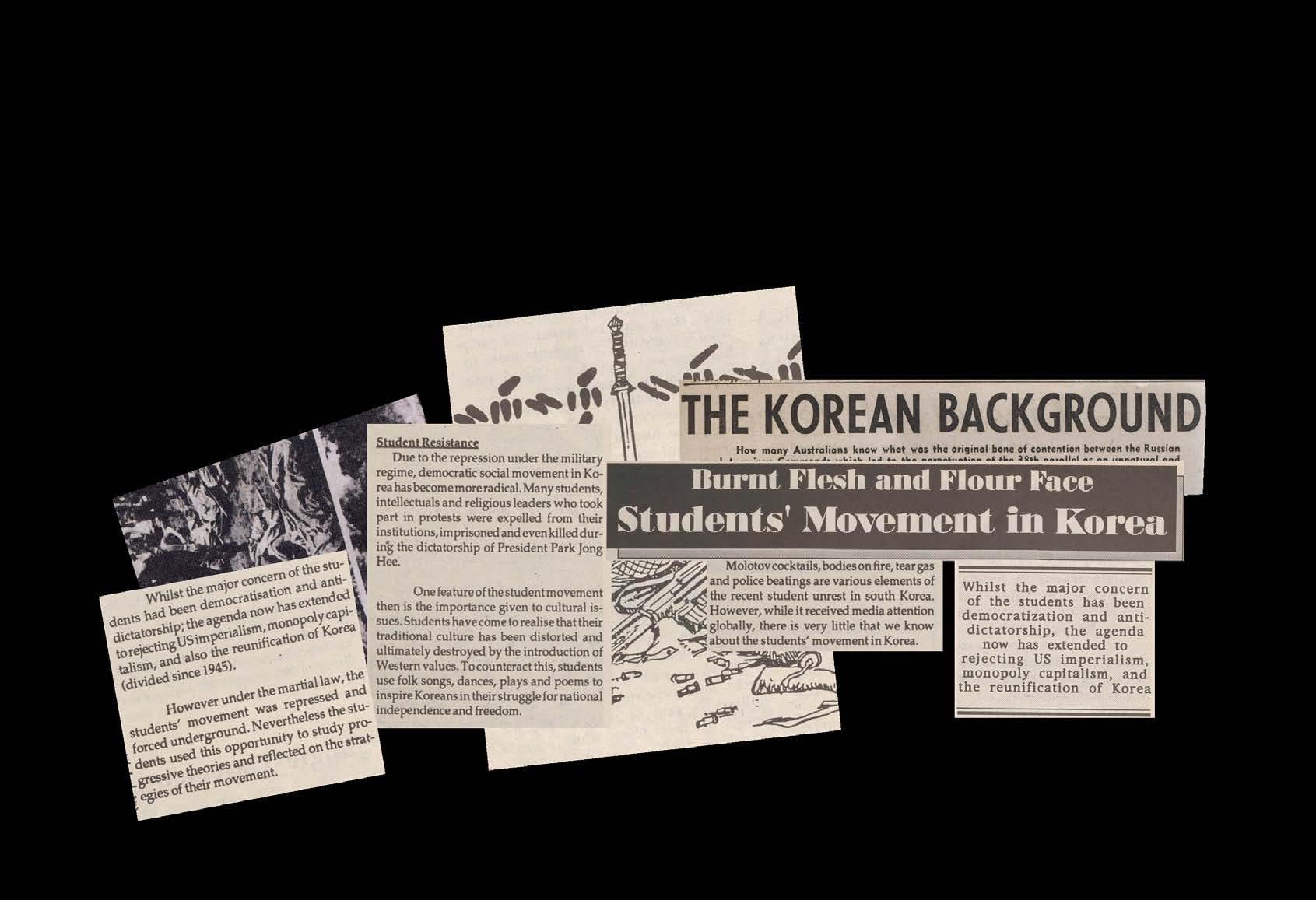
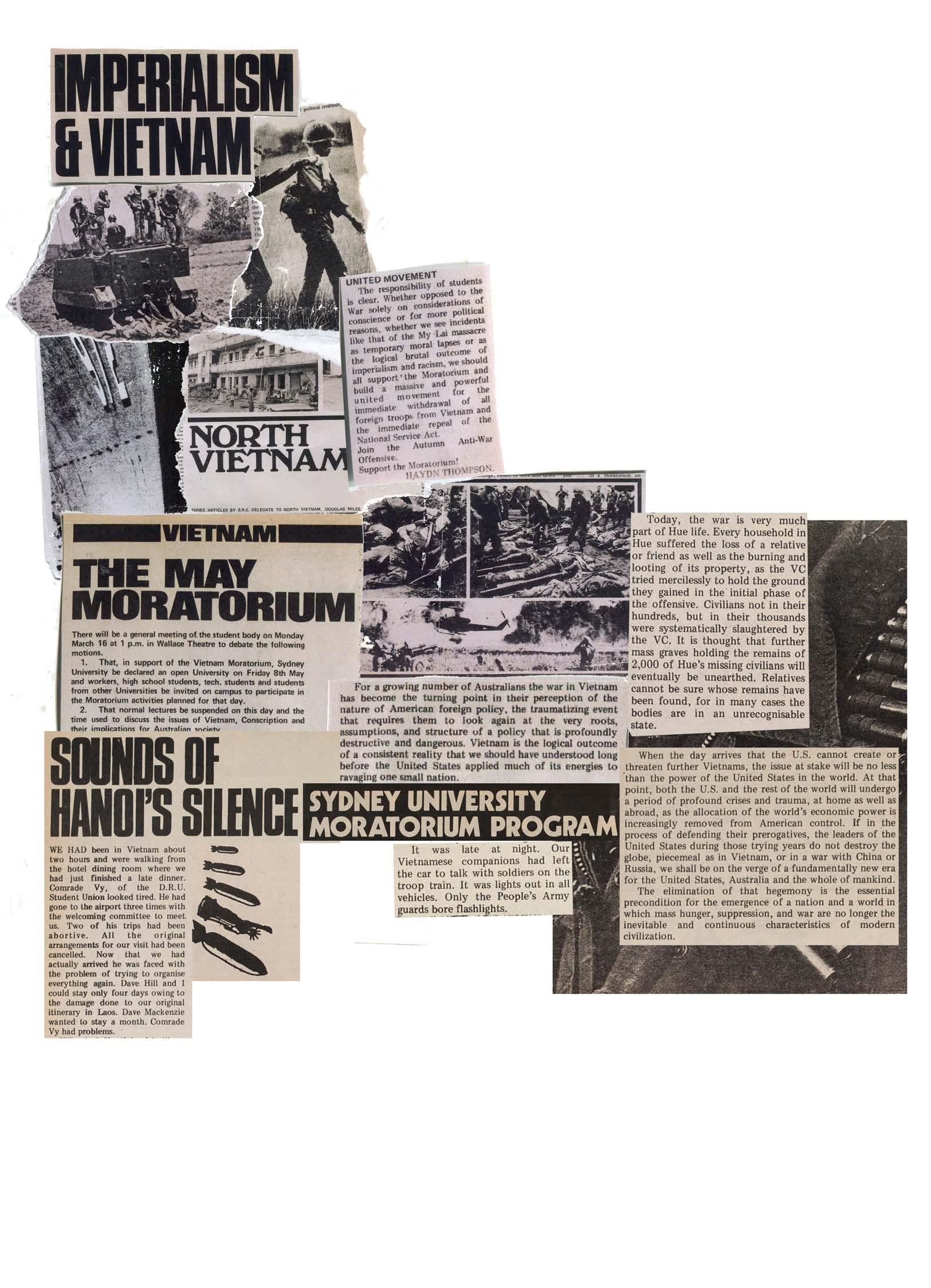
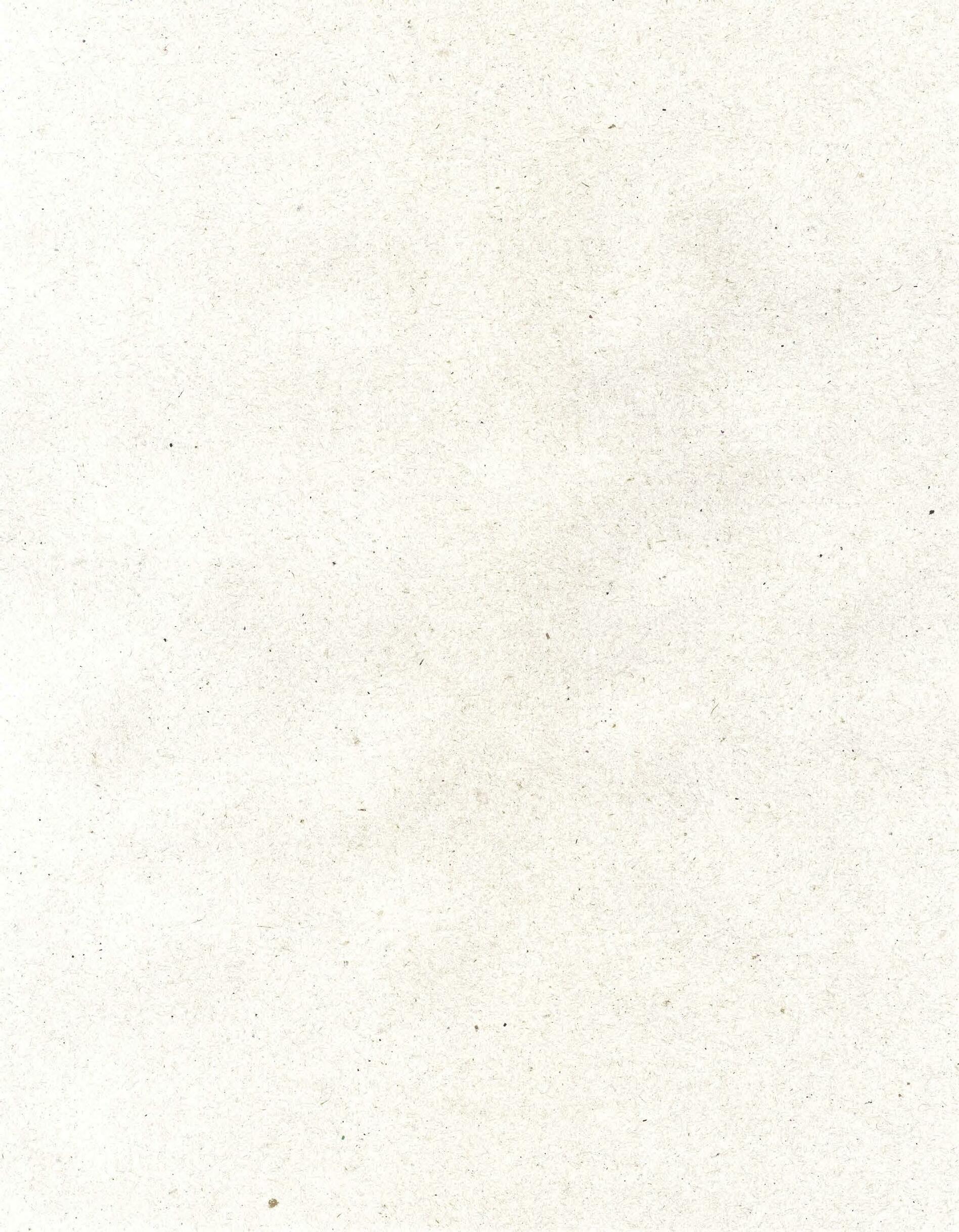

Each conflict coloured students’ lives across the globe — there has not been a graduating class for whom war has not left a taste in their mouth.
War, conflict, and struggle have been a defining feature
of life for young people, always. There has not been a time at this University, nor likely any other, which has not seen anti-war protests, speak-outs or sentiments. In many areas across the world, students have perennially faced the consequences and been the conscripts of conflict.
Though, it has not only been wars in which students have had to bear arms that made an unresolvable impact on their lives and
#20, 1992
h e archives


to war
education, but wars of culture, economics and the environment. Think of Queer, POC, and Women's Rights movements, the Global Financial Crisis, world hunger, and the cost of living crisis, or the current war against climate change — social wars have the power to tear the fabric of our lives as much as the battle field.
Gathered here in this special war edition of Honi, are excerpts from the Honi Soit archives pulled from
articles on the Vietnam War, Korean War, Gulf War, and articles on the impact of war on women. From political analysis of the conflicts to personal perspectives on their impact, all amassed here were written by students, for students.
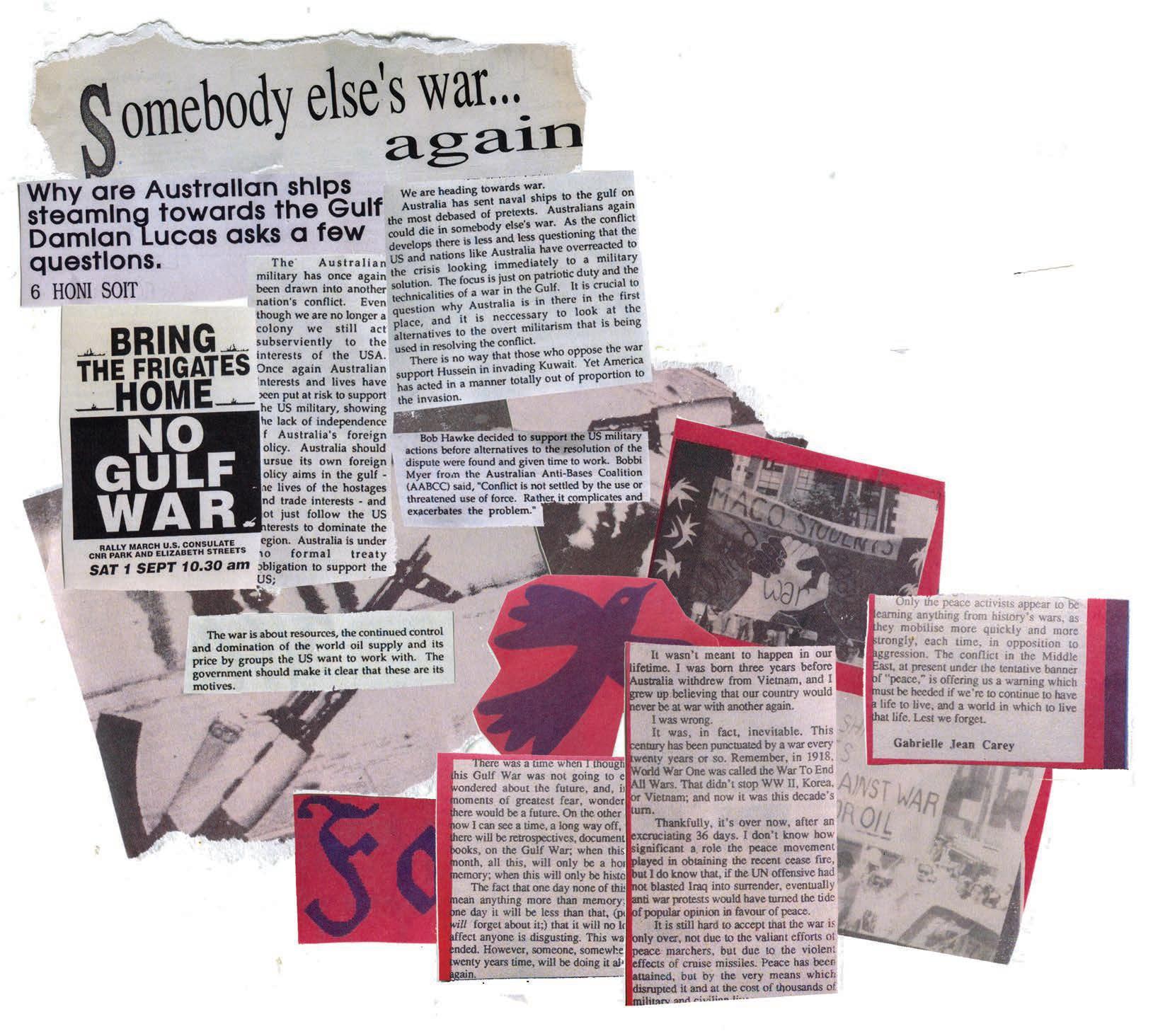
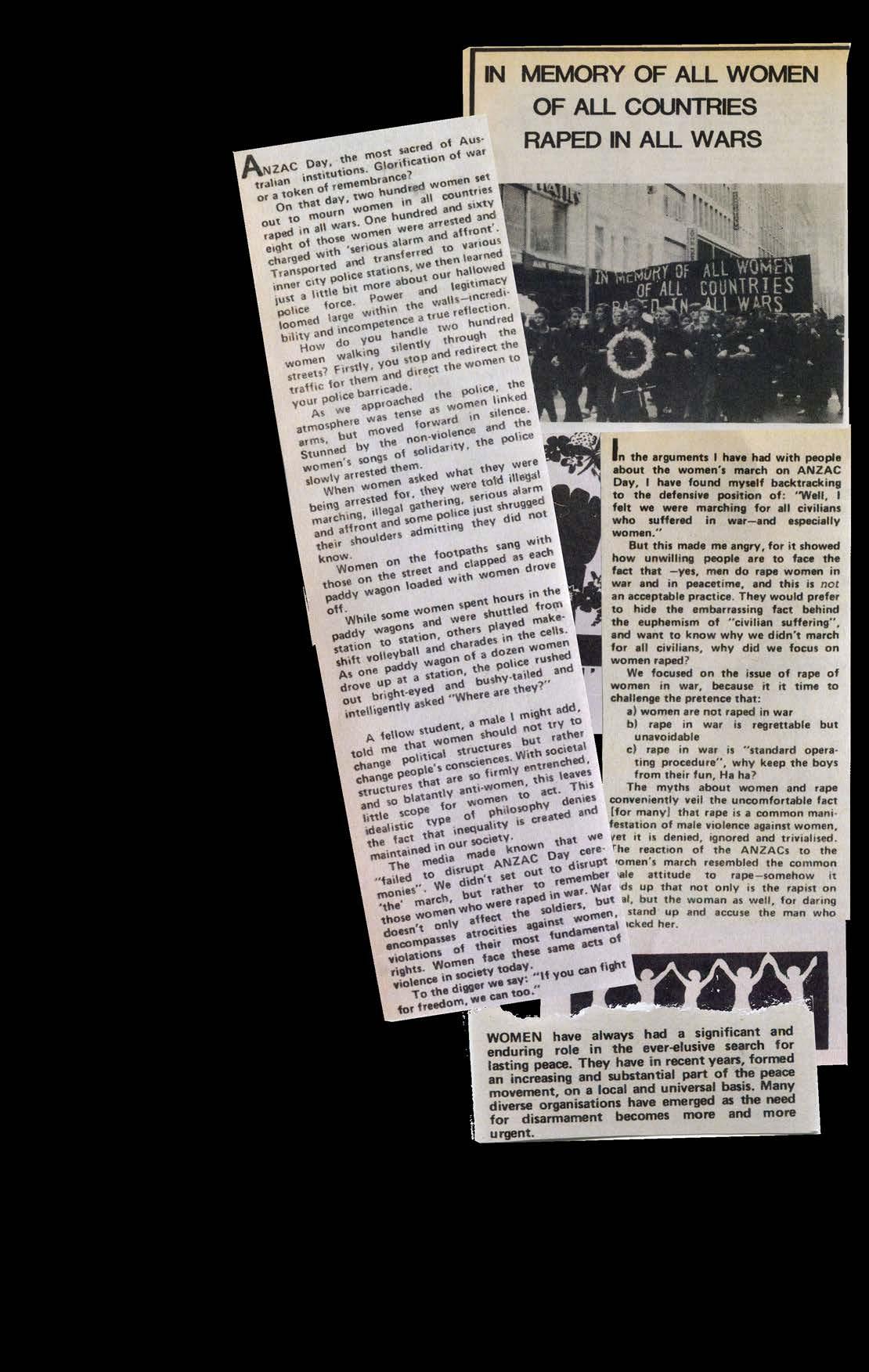
We hope that these excerpts remind you that in all of these historical conflicts, there were students just like you caught up in them.

s
t
#3, 1990Compiled b y a m e l i a koen #7, 1983
Will the bad news end, or is life just bad news?
Lauren Lancaster is still tuning in.
I
f I cast my mind back over my lifetime, it is difficult to decide whether bad things at present are happening at a faster rate or if I am simply more aware of them than in adolescence. Let us canvass this timeline briefly.
At the beginning of this year, Honi Soit editor Christian Holman interviewed me in the grungy SRC Offices. It was a summary of my thoughts, feelings and expectations of the year ahead — as the new President and as a young person living, studying, and working in Sydney. I think I expressed hope for the staff strike campaign, told future me not to be too hard on myself — standard stuff. It was a fun idea on a hot summer’s day as the semester began.
It was also the day that Russia declared war on Ukraine.
Christian captured me being told the news on camera. It was a genuine shock, particularly as I had been confidently declaring only an hour before that “no, they wouldn’t go to war, DFAT is so doubtful, I refuse to accept otherwise.”
By the end of August, the New York Times was reporting that “the destruction ha[d] already cost Ukraine at least $113.5 billion, and it may need more than $200 billion to rebuild”, while oil prices — influenced by trade embargos and uncertainty — shot up across the world and have remained high for the better part of this year.
Where student productions like the Law Revue, in which I was a cast member, may have previously donated to a local charity or Sydney not-forprofit, instead we contributed to the
Red Cross Ukraine Crisis Appeal, which was not something any of us had anticipated even a year ago.
The news cycle has, for the last 10 months, been dominated by graphic updates on the conflict, sandwiched between screengrabs of violent police repression of various protest movements around the world, the elections of far-right politicians drumming up xenophobia, the contentious relaxation of COVID-19 laws, climate change manifesting in terrifying ways (and people still being surprised by it).
All this is to say that conflict, if not outright war, seems to characterise all the major events occurring around us. Bad things have dominated the news cycle since we were young — why does it seem so different now?
In 2001, the year many current USyd undergrads were, like me, born, the 9/11 terror attacks triggered the beginning of the ‘global war on terror’. NATO, for the first time ever, invoked Article 5 of the North Atlantic treaty, which committed each member state to consider an armed attack against one member state to be an armed attack against them all. The Americans bombed not only schools, hospitals and farmland across the Middle East for decades, but also allegedly hit large compounds used for heroin production (a significant profit source for the Taliban).
In the 20 or so years since, US military analysis revealed that not only were advanced fighter jets being used to bomb sites that were essentially mud huts, with little evidence of heroin
production, but that this campaign had no real impact on the Middle Eastern drug trade anyway: “narcotics production in Afghanistan remain[s] at elevated levels.” It is almost as though the US did not, in fact, have an interest in actually denting the opiates activity there, but rather just did imperialist violence around strangely oil-rich regions while peddling claims of the West’s commitment to ending illegal drug trade.
I remember being glued to the TV throughout my childhood as the ABC reported on mass casualties, razed villages and the occasional sob story about Australian soldiers. When it got too much, my parents would exclaim “Oh why can’t they show some nice stories on the 7pm news!” and switch it off. At school, we would read about South East Asian communities similarly displaced as military operations against ISIS were carried out across the Philippines and Indonesia, or perhaps by the rising sea levels of anthropogenic climate change while our national leaders joked to each other about ‘water lapping at their doors’.
After the equivalent of my lifetime had elapsed, Australia withdrew their military operation in Afghanistan. Now, we find ourselves in a cultural and legal reckoning against many of the soldiers who operated there, for grotesque war crimes, unlawful civilian killings and widespread bullying.
Much of the militaristic rhetoric used to justify our presence in Afghanistan, that we were “helping people”, is being wheeled out again
What ever happened to world peace?
When I was a kid, I was told by a grownup that I was lucky to grow up in a time of peace. Of course, I hit about age 10 and realised that was a lie. Then I hit about age 20 and said: why don’t we bring back the peace movement?
Our parents and grandparents came of age when the peace movement was having a real moment. That’s because their parents and grandparents came of age when war was having a real moment.
My desire to revamp the peace movement left as swiftly as it arrived. But it did leave me wondering where the bloody hell the peace movement went. A brief night’s critical thinking revealed that it had dissipated for reasons that render it inadequate to truly meet the needs of current issues.
The most obvious link to its contemporary irrelevance is that there isn’t a draft. The impact of war on people in the West’s individual lives is no longer present. Why do I need to protest against war if I don’t need to go to war? While this is a woefully unempathetic response, it’s unfortunately true that people are self-concerned, and more willing to fight against something which threatens their own wellbeing.
Post 9/11, the sentiment around the soldier as a hero of the past has shifted to framing them as a modern martyr. The
culture which fuels Americans’ obsessiveposting of ‘military dad returns’ YouTube videos (maybe just don’t send him in the first place?) means people are more cognisant of the personal offence that an anti-war movement might cause. You want the troops out of Iraq? Hey, that’s

my Dad you’re talking about!
Previously, to call for peace was to ask that what happened to your grandparents never happens again. The goal was to prevent trauma, to not get drafted, and to not inflict harm on civilians. But when
in relation to conflict in Ukraine. It is another punctuation mark in the lifetimes of young Australians: war as the consistent background radiation to an experience of the world that seems to only grow more chaotic as the years go on. While many of us have never heard first-hand the sound of shots fired, or witnessed the dust blossom from beneath the leathery soles of military boots upon sharp gravel, we live in times of war. You aren’t alone if you feel conflict suffuses most aspects of your life, or at least I can vouch for feeling much the same.
The gruesome visual reality of this is so ubiquitous we don’t even have to lift a finger, it’ll just scroll to the next reel for you. Anger, dismay and hopelessness are old friends, hand in hand with short attention spans that boomers disdain and on which psychologists pontificate. Yet there can also be hope. I haven’t found it often on socials, but in good convos in the sun, well-delivered apologies and friends who won’t always try to give advice. In the face of so much bad, leaders who seem to revel in their own ignorance and cruelty, and a media landscape wed to the warmongers themselves, it is the small, local and fleeting that remind us there are in fact, some battles worth fighting.
We are due for a wrap-up interview back in the same old SRC office that itself has bore witness to its fair share of conflict, this year and in ages gone by. Short attention span aside, something tells me I won’t be at a loss for things to say.
there is a “war on terror”, and there are people (allegedly) trying to fight it for the sake of innocent people, it’s a harder moral request to ask them to stop.
The anti-war movement was creative and recreational. Nobody has time for that bullshit anymore. It was all sitting around, playing guitars, smoking joints. And ultimately, this was half the problem. The actual goal of the peace movement was never clear: so we end war, that’s great – but what do we do with the whole world of injustices left in our hands?
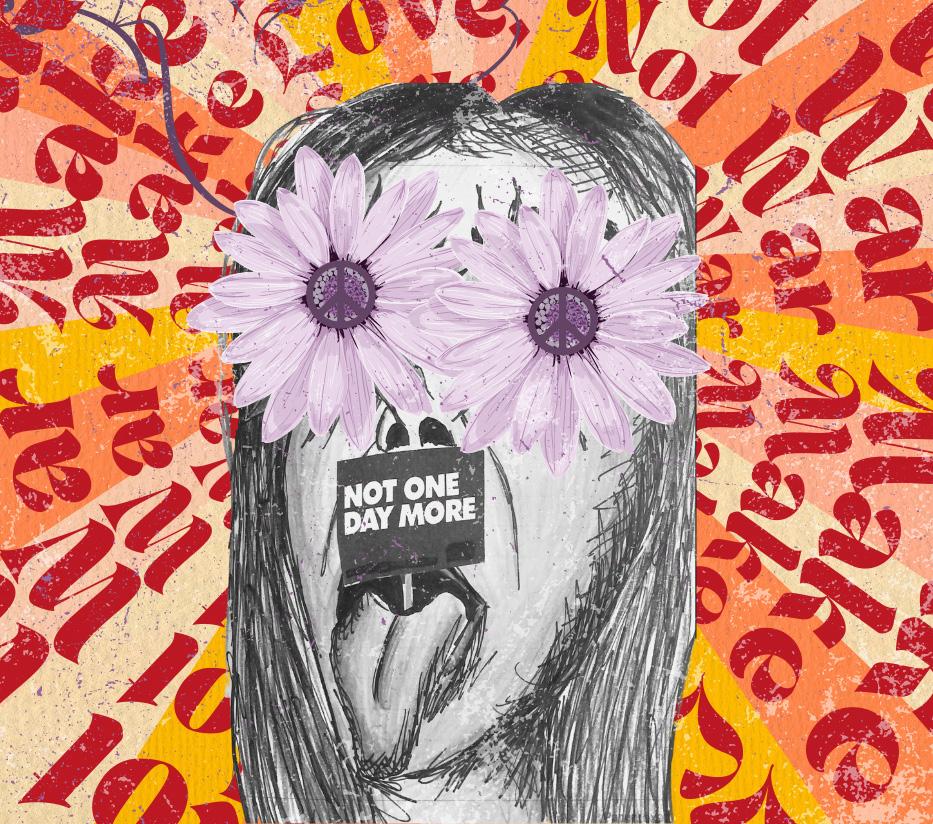
And of course, war isn’t televised with the freedom that it used to be. The antiwar movement which grew in the 60s was largely because for the first time, people were seeing the gruesome, inhumane impacts of war on their television screens. Dead bodies, innocent people hurting. Now, the only way to access such truths is in independent inquiries.
Modern war is more coercive, more subtle. There’s more corporate money in it and less public say in how it happens. These aren’t things a peace movement would solve – they’re things political action will solve. The injustice which faces us is rather unpeaceful: the global rise of neo-nazis, institutional racism, violence and poverty.
These aren’t issues a peace campaign will solve. For peace, there must be war.
HONI SOIT WEEK ELEVEN 202220 | OPINION
PL puts down two fingers and raises one.
Zan, Zendegi, Azadi

‘Women, Life, Freedom’
Danny Yazdani writes with desperation.
I wake up every morning and jump at the sound of gunshots. I hear the rattling of handcuffs, tender bodies being thrown into the backs of vans. I smell a pungent iron odour polluting the air. It is as if literal stink waves are emerging from the pools of red trickling down sidewalks. I hear the beating heart of a family confronted by upheaval and persecution, and the pulse of a people steadying change.
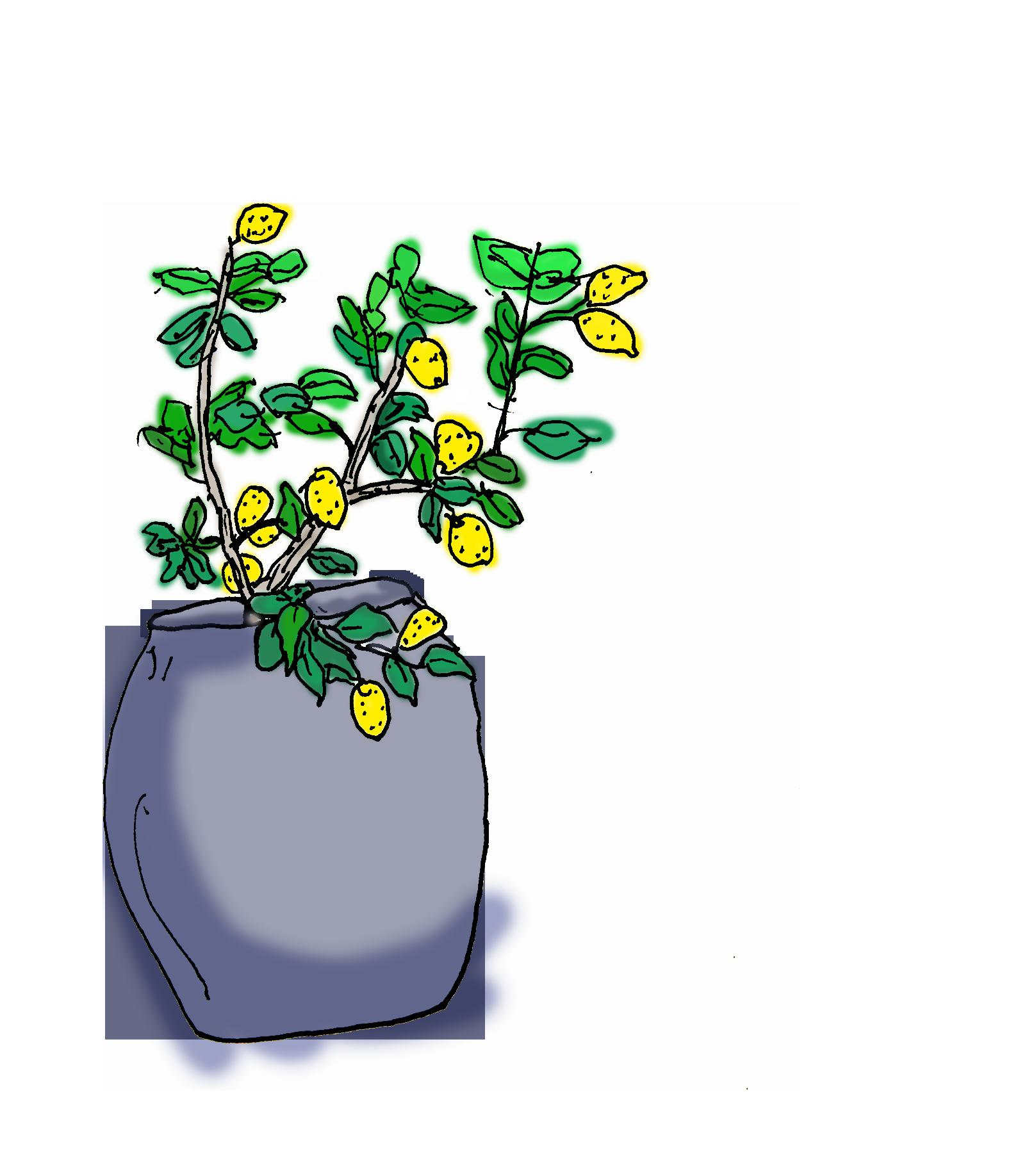
But I hear, see, smell, and feel from a distance. Through lifeless screens, disrupted phone calls, and conversations that plummet into existentialism. Over ten thousand kilometres away from where I live, on unceded Dharug Country, I come into contact with a land I have been taught to call ‘home’, despite it being far beyond my reach.
Those within the country have waged a war against the dictatorial government and its theocratic values: staging political protests, the burning of hijabs, the cutting of hair, and student demonstrations culminating in widespread international coverage and response. They lead with the chant, ‘Zan! Zendegi! Azadi!’.
that things will get better, and we run to our Instagram page and desperately share all the posts we see relating to the Islamic regime’s crimes. We try to sneak the topic into commonplace conversations, to informally signal to our friends how distressed we are, but it seems that batting even an eyelid is too much to ask of them.
Even I find it too difficult to express my disappointment at times — disappointment in the Australian community and those non-Iranians closest to me who have let an immense and ongoing violation of human rights slip their attention.
of Iranian freedom. False hope seeped through the masses and the national monument, in its all its glory, became a symbol of a movement led by the people. With such momentum behind the overthrowing of the shameful Islamic regime in the present day, I hope to wake up to the sound of freedom one morning.
The brutal murder of Mahsa (Jina) Amini in police custody lit a wildfire in Iran and across the world. Detained by
Accompanying this, Shervin Hajipour’s original tribute song to the Iranian people, Baraye (For), gained over 40 million views within 24 hours of being released. Composed of tweets posted by Iranians, Hajipour’s harrowing lyrics saw his arrest and the song’s removal from his social media platforms.
On a larger scale and beyond Iran, the first of this month saw a ‘Global
My family on my mother’s side recently bought their first home after close to thirty years of exile in Australia. Australia accepted them with an open embrace during the Keating era of multiculturalism, but the bittersweet forging of a new home outside of the Motherland has loomed over them and their children to this day. When leaving their old home — in Australia this time — my grandparents were most pained by the abundant fruit trees they had to leave behind. Sweet lemon, greengage, pomegranate and bitter orange were some of the last
I hope for freedom for the generations that have come before, for my own, and for my descendants,
WAR PERSPECTIVE | 21HONI SOIT WEEK ELEVEN 2022
“But I hear, see, smell, and feel from a distance. Through lifeless screens, disrupted phone calls, and conversations that plummet into existentialism”
“Even I find it too difficult to express my disappointment at timesdisappointment in the Australian community... who have let an immense and ongoing violation of human rights slip their attention.”
“The bittersweet forging of a new home outside of the Motherland has loomed over them.”
“I yearn for a sense of cultural connection unburdened by the Iran of today. The youth of the country, however, are left with little hope... democratic values are swept under Persian rugs.”
A Never-Ending End: Experiences of war from near and afar
Reflecting on my experience of fleeing my hometown in Syria (from near), and following the continuing Armenia-Azerbaijan conflict (from afar).
Hrant Boujikian considers the turmoil affecting his homeland.
Content warning: mentions of torture and rape.
“Only the dead have seen the end of war”
It was 29 September 2020 when the characters of that sentence formed some of the 240 Twitter ‘bullets’ available at my fingertips. I was engaged in cyber warfare on a global scale, while watching a war being waged on my Armenian homeland unfold from afar.
With a world distracted by the COVID-19 pandemic and the US Presidential Elections, Azerbaijan — backed by NATO member Turkey — launched a full-scale war on the Armenian nation. The Armenians of Artsakh (the region of NagornoKarabakh) were fighting against attempted ethnic cleansing as they were subjected to indiscriminate shelling and bombing of their homes, schools, hospitals, churches, cultural centres and more, while their soldiers fiercely faced death on the frontlines defending their homeland.
A lot has changed since then. But before zooming into my experience of the Armenia-Azerbaijan conflict and perspective as an Armenian living in the diaspora, I should mention that this was not my first encounter with war. War and I had met before.
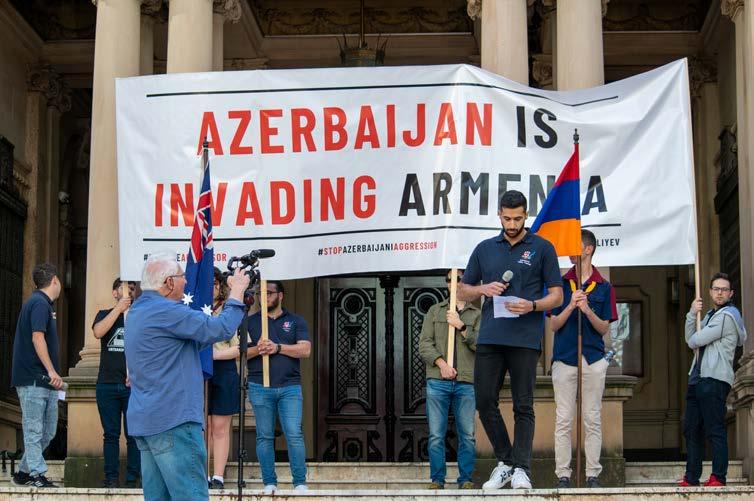
It took me little to no time to remember what it feels like being in an area where the probability of a rocket falling in your vicinity is greater than zero, with a photo of two Armenian children seeking shelter from Azerbaijani bombs taking me back to 2014.
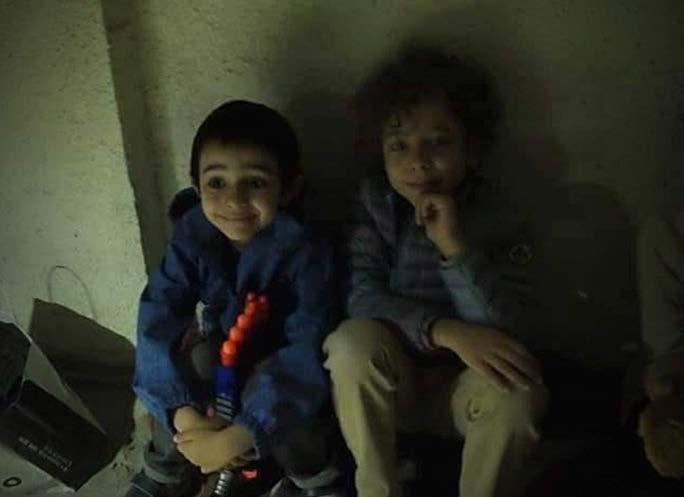
On 21 March 2014, the morning of
Mother’s Day as it is celebrated in Syria — my alarm was set to go off at 6:30am, waking me up to be ready for school on time. I was in Year 8 back then, attending the Armenian high school in my hometown, Kessab — located far North West of Syria, bordering Turkey on the Mediterranean Sea.
But that morning, the alarm went off earlier than it should — by around 20 minutes as it turned out. I was woken up by the explosions of randomly dropping rockets. Terrorists had launched an attack to invade. My 13-year-old self had no idea what to do other than to pray and hope for the best.
I was still in bed when my prayer was interrupted by my mum who softly ordered me and my sister to get up, pack up and be ready to leave. So that’s what we did, and my little wallet was the first thing I packed up, of course.
from school for Mother’s Day. We weren’t sure if it was still appropriate to give them to mum. After some hesitation and with a quick anxious hug, the flowers were resting in my mum’s hands.
It was around 8am when we left. The town was emptied within two days and remained under the control of terrorists for three months.
Fast forward to December 2016 when I arrived with my family in Australia, and thought that was the end of it. No more war as I was far from danger, right? Little did I know that just under four years later, war from afar would feel closer than ever before. It was the 2020 Artsakh (Nagorno-Karabakh) War — the 44-Day War.
“I was still in bed when my prayer was interrupted by my mum who softly ordered me and my sister to get up, pack up and be ready to leave. So that’s what we did...”
As the rockets kept falling, I recall dad advising us to remain seated and shelter in the main corridor of the house as that’s where the strongest ceiling was, he said.
Within the last couple of minutes before leaving, there was one last thing my sister and I had to do that morning. I spotted the red flowers we had collected
In experiencing the closeness of war, it was no longer the physical metres or kilometres that were the determining factor, but how quickly someone would read tweets, watch videos on social media and attend demonstrations and protests.
Like Armenian communities around the world, for many in my Australian Armenian community, this
Plato
wasn’t just a time of severe emotional turmoil — many of us felt the need to explain to people around us what was happening and why the war had to be stopped. The community came together through protests, demonstrations and humanitarian fundraisers as the unhealed wounds of what our ancestors faced during the Armenian Genocide (1915-1923) were open once again.
Historically speaking, Artsakh has been part of historic Armenian kingdoms. In the early 1920s, the Soviet Union annexed Artsakh and established the Nagorno Karabakh Autonomous Oblast (NKAO) within the Azerbaijan Soviet Socialist Republic (SSR). With the Baku and Sumgayit massacres of Armenians taking place in Azerbaijan, the NKAO Armenians felt the increasing threat and did not want to be part of an independent Azerbaijan. In 1991, following a selfdetermination vote, Nagorno-Karabakh declared its independence like other ex-USSR countries did, establishing a democratic republic, but remained
HONI SOIT WEEK ELEVEN 202222 | WAR PERSPECTIVE
Armenian children in bomb shelters while Azerbaijan was bombing Artsakh’s capital city, 27/09/2020 - Source: Zartonk Media
-
Image from the Sydney March For Armenians following Azerbaijan’s 13-14 September 2022 attacks and invasion of Armenia - Town Hall, 25/09/2022 - Photo by Hagop Harfouchian
“I spotted the red flowers we had collected from school for Mother’s Day. We weren’t sure if it was still appropriate to give them to mum. After some hesitation and with a quick anxious hug, the flowers were resting in my mum’s hands.”
internationally unrecognised. Since then, Azerbaijan’s goal to ethnically cleanse the Armenians of Artsakh has not seen an end.
The motives of the 44-Day War go far back when the pan-Turkic vision of the Ottoman Empire led to the annihilation of 1.5 million Armenians, and over a million Assyrians and Greeks. Turkey and Azerbaijan are the only countries that continue to deny the Armenian Genocide, considering themselves as “one nation, two states”, while still pursuing an expansionist policy fuelled by petrodollars and hatred toward anything Armenian.
“Genocide denied, genocide repeated”: image of Armenians being driven out of their ancestral lands during the Armenian Genocide (1915) and after the 44-Day War in Artsakh (2020). Image by @aramessesthegr8.
On 13 September 2022, Armenia mounted its sharpest post-war escalation, was witnessed as Azerbaijan as it attacked towns and villages within sovereign, internationally recognised territories of the Republic of Armenia. Azerbaijani soldiers not only invaded Armenian territory, they committed some of the most disgusting war crimes which have been continuing since the 2020 War — the use of cluster munitions and phosphorus bombs, torturing of POWs and opening a xenophobic war park dehumanising Armenians. After the recent attacks, a gruesome video surfaced of Azerbaijani soldiers raping, multilating and torturing a female Armenian soldier
leading to her undignified death, while another clip showed the execution of seven prisoners of war. This must end.

As an Australian citizen, it is extremely frustrating to witness the double standards of my Government and its failure to outright condemn the crimes by Azerbaijan as other countries such as the US have. If we as a nation value international peace, democracy and human rights, then why not name and condemn the aggressor?
Australia played a key role in aiding survivors of the Armenian Genocide while ANZACs witnessed and reported on the atrocities being committed. The humanitarian relief effort is greatly appreciated, especially by descendants of the survivors who now call Australia
“Azerbaijani soldiers not only invaded Armenian territory, they committed some of the most disgusting war crimes... the use of cluster munitions and phosphorus bombs, torturing of POWs”
home. Yet today, it is disappointing to see the Australian government ignore the plight of Armenians and label the current happenings as “armed clashes”, suggesting the lack of an aggressor.
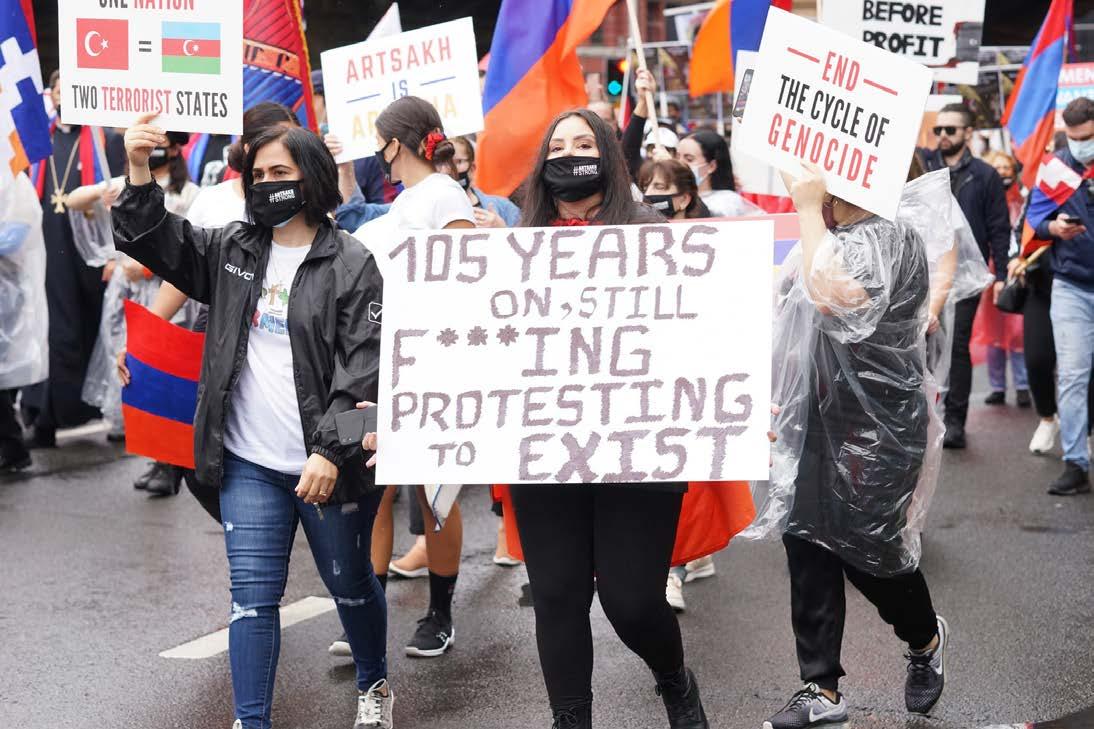
In comparing my experience of war in Syria to that of the 2020 Artsakh War, I can say that the latter took a much sharper mental and emotional toll on me. Although I may have not recognised it at the time, I experienced all sorts of negative emotions, from anger and frustration, to disbelief and guilt. It was an experience that bitterly taught me about the importance of mental health.
Today, with some progress through ‘peace talks’ between the Armenian and Azerbaijani Governments since the supposed ‘end’ of the 44-Day war, the consistent genocidal rhetoric of
Azerbaijani and Turkish officials — especially by Azerbaijan’s autocratic dictator Aliyev, it is hard to see this fragile peace last. This is especially true for the Armenians of Artsakh. If they are left alone and should Artsakh come under Azerbaijani control, one can only predict another massacre of the Armenians and repetition of dark pages from history.
Plato’s words still ring true today, especially in a world where ethnic hatred is still evident and autocratic regimes are trying to impose their power through military means. Despite my never-ending experiences with war, I do recognise that others have gone and are going through worse situations, and the question that echoes in my head asks:
What would those who “have seen the end of war” tell us?
“Genocide denied, genocide repeated”: image of Armenians being driven out of their ancestral lands during the Armenian Genocide (1915) and after the 44Day War in Artsakh (2020). Image by @aramessesthegr8.

WAR PERSPECTIVE | 23HONI SOIT WEEK ELEVEN 2022
March For Armenians calling on the Australian Government to end its silence - Sydney CBD, 24/10/2020. Photo by Berj Varjabedian.
ART BY BIPASHA CHAKRABORTY
“As an Australian citizen, it is extremely frustrating to witness the double standards of my Government and its failure to outright condemn the crimes by Azerbaijan...”
Why women can never truly rest in peace: On
Simone Maddison lets the "real" Marilyn Monroe go.
Sam Shaw, the photographer who billowed a pleated white skirt over a subway grate in New York City and created a 20th century icon, also captured Marilyn Monroe at the altar of a dressing room mirror in 1954. Almost 70 years later, Ana de Armas gazes at the same bleach-blonde hair and black strappy bodice staring back at her. She smiles, kisses the air, transfixed by her own incandescent beauty. Yet the longer the viewer looks, the more they will realise that what they once saw as Marilyn’s reflection is actually Norma Jean’s fragmentation. These two personas, torn but inseparable within her identity, form the foundation of director Andrew Dominik’s obsession with pain, mental illness, victimisation, and violence in Blonde (2022).
accuracy, invoking her name necessarily involves Marilyn’s legacy – and falsifies it. Norma Jean is permanently stuck on the screen, rewritten into a destiny that she was never permitted to write herself. The exploitation of her image is therefore not just worrying because it capitalises off the deeply personal afflictions of a vulnerable individual. Rather, it holds a mirror to past and present cultural institutions that have manufactured her face.
Based on the fictionalised events of Joyce Carol Oates’ 2000 novel by the same name, Blonde attempts to explore Marilyn’s life between her “discovery” as a pin-up girl and her drug-induced death in 1962. Despite being nominated for a Golden Lion at the 79th Venice Film Festival, the film has attracted condemnation for being an abuse of Marilyn’s suffering and sadness. Its US NC-17 rating (equivalent to Australia’s R18+) appears as the latest indictment of the film’s explicit scenes depicting sexual assault, abortion, and nudity.
The film’s direct reference to Marilyn’s real life makes Dominik’s recent statement to the British Film Institute, that the film is about “a person who is going to be killing themselves… it’s not looking at her lasting legacy”, completely implausible. No matter how hard Blonde allegedly tries to resist autobiographical
The problem is not that these themes are explored in the film per se. Once the viewer realises that Blonde is not the “biopic” that Netflix claims it is, Dominik’s joking retort to its moral criticism — that the movie “is not running for public office” — appears to miss the point. Taking Oates’ aesthetic rearrangement of Marilyn’s life as a starting point, Dominik searches for the “real Marilyn” in a story designed to reveal some deeper truths about fame. The results are distressing, dragging Marilyn “through the meat grinder” in similar ways to a 1950s Hollywood movie executive.
Perhaps this is best illustrated in Blonde’s simultaneous flattening of, and fixation on, Marilyn’s legacy. The film is built upon her sexualisation, appearing first in an historically-inaccurate threesome with Charles Chaplin Jr. and Edward Robinson Jr., and later a graphic blow-job with President John F. Kennedy. Marilyn is an object before she is a woman, promiscuous and topless for long scenes even when experiencing extreme mental and dissociative turmoil. Marilyn is again needlessly violated when the audience is taken inside her cervix, portraying an abortion she never had to reinforce the connection between hysteria and femininity. Despite Dominik’s defences, Planned Parenthood has since condemned his portrayal of Marilyn’s fully-formed foetus asking her “you won’t hurt me again, will you?” from inside the womb as “anti-choice propaganda”. Marilyn’s oppression is therefore mistaken for willing submission, infantilised during frequent temper tantrums in the film and throughout her marriages with “Daddy” Joe Di Maggio and Arthur Miller.
Blonde certainly leans into wider social obsessions with Marilyn as what Gloria Steinem called “a survivor” in her 2006 Ms. Magazine editorial on Marilyn’s legacy. To some extent, Dominik’s holy trinity of gendered stereotypes subverts her construction in the public eye as a fantasy men think they want, and women know they do not want to be. But it is also a testament to Dominik’s vision of Marilyn as a “guy’s girl”, embodying a much broader male gaze. He does not direct like he believes Marilyn “was in charge of her own destiny”, because
he does not “see the film as essentially female.” In a context that privileges sensitive portrayals of questionable male figures like Elvis Presley and Freddie Mercury, Blonde is important as a marker of the stagnation and regression of the treatment of women in popular culture, and in particular the biopic genre.
This film cannot commemorate Marilyn Monroe because its memory is clouded by images of sex, hysteria, and victimisation. De Armas cries more than she smiles for 164 minutes, neglecting the moments of resistance and joy Marilyn found in calling out powerful Hollywood studio executive Darryl F. Zanuck as a “wolf”, and creating her own production company. Blonde is therefore a result of, rather than a protest against, the conditions which gave rise to the #MeToo Movement that Dominik claims to respect. It reinforces an entitlement to male ownership over female bodies, made worse for Marilyn as a “public woman” who posthumously cannot defend herself. Although public outcry to the film highlights some societal awareness of these shortcomings, Marilyn’s legacy ultimately matters because it reflects far more about us – and the inequalities we are unwilling to admit – than it does about her.
'The Australian Wars' on SBS: A reckoning with forgotten history
CW: Honi advises Aboriginal and Torres Strait Islander readers that this article may contain images, perspectives and names of deceased persons. Readers are warned that this article mentions colonial violence towards Aboriginal and Torres Strait Islander peoples.
The Australian Wars is a new threepart documentary series on SBS on Demand. Directed and produced by Arrernte and Kalkadoon filmmaker Rachel Perkins, the series traces the story of settler-colonial violence from the landing of the First Fleet in 1788 until the 1920s. Perkins sets out to understand why the war was never declared, why the British didn’t follow their own laws, and the tactics and strategies Aboriginal people employed defending their land.
The ‘frontier wars’ were the conflicts between Europeans and Aboriginal people during and immediately after colonisation, generally agreed to have spanned a period from 1788 to around 1934. The wars were fought over access to land which the British sought to exclusively occupy in the absence of a legal agreement, treaty, or settlement with the Aboriginal peoples of mainland Australia.
Perkins’ new series explains in detail — aided by the deployment of reenactments, artefacts, historical archives and colonial records, biographical evidence and oral histories, and
masterful use of place and space — the methods of Aboriginal resistance to settlement. Perkins interviews historians and anthropologists, who share stories of guerilla warfare between Pemulwuy’s army and British colonial troops, massacres of Aboriginal families and settlers on the frontier, and brutal lateral violence by the state-sanctioned ‘native police’.
Aboriginal people are still resisting today, in the courts.
“Today, the survivors [of the frontier wars] have a different fight on their hands. It’s still over their land and still with the Queensland government, but now it’s in the courts. In a bitter irony, the government uses the violent destruction of their clans as evidence that their connection to their country has been broken,” Perkins explains.
The Australian Wars is a crucial milestone in the process of truth-telling. Perkins and her team deliver a public reckoning with the means by which the British Empire, and subsequent independent colonial administrations, perpetrated cultural — and, in some cases, actual — genocide against Aboriginal people, undertaking a massive land grab in the process.
Like many other young Aboriginal people, I was born into the twilight years of the ‘Great Australian Silence’, a period of time in which the dominant narrative of Australian settler-colonialism was
sunny tales of overcoming great odds, sustained by hard toil and indomitable will. Educators, historians, politicians, and public servants viewed the history of this continent through rose-tinted glasses; Aboriginal acts of resistance, refusal and warfare were somehow miraculously omitted.
Only in the past several decades has reconciliatory efforts allowed for the emergence of a more truthful account of the past. On account of new and diverse perspectives, a changing academic landscape and a greater commitment to truth-telling, the Australian public are slowly navigating the sickening realities of the frontier wars.
A key action spurred by the series is greater recognition and commemoration of the victims and casualties of the frontier wars by the Australian War Memorial.
Essayist and author Paul Daley claims: “The ANZAC cloak has shielded the Australian War Memorial from criticism. Its recognition of frontier violence is long overdue.”
The War Memorial’s recent promise to present a “much broader, deeper” depiction of the frontier wars is a drastic and welcome shift from the views held by its traditionally conservative governing body. The news that Brendan Nelson — former federal opposition leader and memorial director — is resigning his role within the institution as council chair
marks the end of his long and influential association with the Australian War Memorial.
As chair, he argued that “[Australian frontier conflict] did not equate to war”, it was “the agreed job of the National Museum of Australia [not the War Memorial] to depict colonial Black-white conflict”, and that “Australian-raised military units were not involved in such fighting”.
The “job” of truthfully depicting the realities of colonial violence on the frontier now falls to Blak filmmakers and historians. History — particularly, and upsettingly, recent history — tells us that non-Aboriginal people, groups, and institutions cannot be trusted to tell our stories for us. In The Australian Wars, Perkins reaffirms Aboriginal peoples as the original storytellers and competently challenges the views and perspectives of white Australia.
All episodes of The Australian Wars are available for streaming on SBS on Demand now. For wider viewing, The Australian Wars: Evidence from Queensland and Land Wars, panel discussions with leading Aboriginal historians, anthropologists, activists and filmmakers, are also available for streaming.
HONI SOIT WEEK ELEVEN 202224 | REVIEWS
Blonde(2022)
“Yet the longer the viewer looks, the more they will realise that what they once saw as Marilyn's reflection is actually Norma Jean's fragmentation.”
Ethan Floyd reviews Rachel Perkins' new docuseries on the real history of settler-colonial violence and Indigenous resistance.
“The film reinforces an entitlement to male ownership over female bodies, made worse for Marilyn as a 'public woman'.”
SOMEDAY SOON AN ELECTRIC DEBUT AT MANNING
Ten minutes into their outdoor set, The Regime’s Julian Joseph slutdrops into a squat and splits his pants – to be met with an ecstatic cheer that reaches from the stage to the back of the Manning House lawn. Unfazed and electric, he wastes no time in transforming any idle bystanders into grooving acolytes, creating a blurry dance of controlled euphoria and harmony which could only arise from soul-funk.
It’s a fitting microcosm of a spirited event. Someday Soon made its debut at Manning Bar last Saturday, delivering what it promised– nine hours of energy brought by over 20 local artists amid a pink and green visual masterpiece.
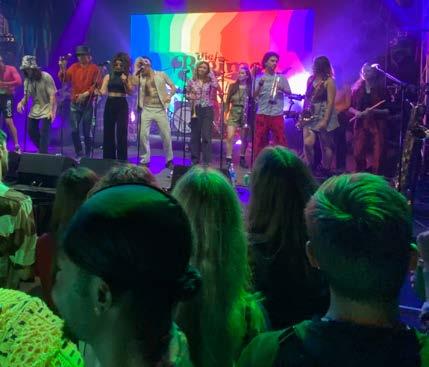
The University of Sydney Union’s (USU) commitment to Someday Soon’s aesthetic (think neons, fastpaced, excitement, MDMA) must be commended; the vision was brilliantly realised.
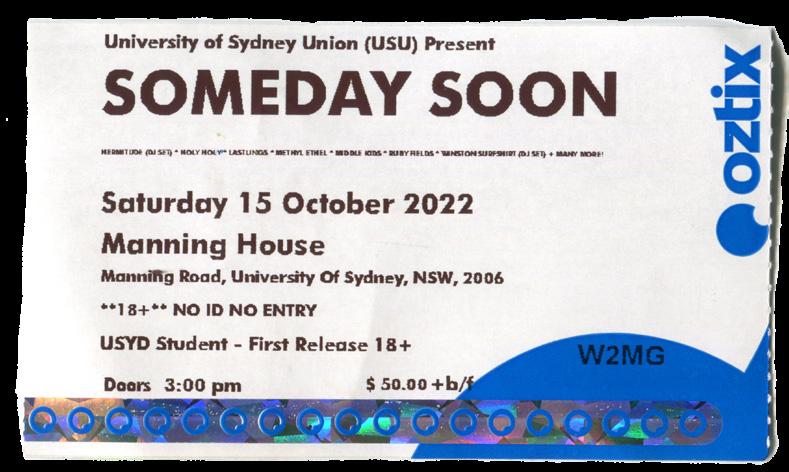
Manning Bar functioned surprisingly well as a festival venue –separation between the two outdoor stages allowed you to move from DJSoc’s steady rhythm to a charming pop performance by Ūla. Entering another realm of music upstairs, Manning’s indoor main stage bestowed attendees with the classic concert experience. Navigating the festival, you were sure to find your friends easily, but could experience the intimacy of a slower set
like Merci Mercy upstairs.
Someday Soon began at 3pm and grew steadily in size and energy until the last set ended at midnight. Ruby Fields opened the upstairs Manning Stage with an earnest and thoroughly feel-good performance. Stripping back light effects, she embraced the daytime buzz of early arrivers with her indieAustralian magnetism. Crowds were initially tentative, but standouts ‘I Want’ and ‘Dinosaurs’ loosened up the audience. By the end of her set, Fields had transformed a small but loyal group into a crowd well-immersed in her nostalgic, unfiltered sound.
Heading downstairs, second act Ūla was an endearing performance. Rising to Tiktok virality for busking in Parramatta Centenary Square and Town Hall, seeing the popstar on a proper stage invited a warm smile. Despite her recent rise to prominence, she is a natural in front of an audience; her unique style (space-buns, easy going, e-girl adjacent) saw high crowd engagement between songs and during her cover of Nirvana’s ‘Smells Like Teen Spirit’.
Though moods at performances were high, the same could not be said at the bar. Drinks were expensive for a
PHOTOS BY CHARLIE GILMOUR
student event – coming to terms with a $12 Canadian Club is not easy. Despite $7 Jagermeister cocktail vouchers being handed out early in the day, any eagerness was undercut by the fact that the drink tasted like metal and was watered down into oblivion. It raises a counterpoint to the everpresent rhetoric of reckless and irresponsible young people in Australian media; if drinks inside this nine-hour festival (which attendees could not exit and re-enter) were more affordable, maybe attendees would feel less inclined to binge drink at pres to the point where a heavy paramedic presence is
Something particularly impressive about Someday Soon was its steady, unbroken evolution from kickedback sunny sets to the euphoric thrill of a night out. DJ Joshua Amour was tasked with keeping energies high and delivered a confident and consistent set. Initiating a club-like ambience, Amour’s is a stridently energetic sound that has earned comparisons to Jamie xx and Burial. Also facilitating this day-to-night transition later on was Roy Blue on Manning’s outdoor stage. Standout tracks were ‘Brain Wax’ and ‘Obelisk’, but the light FX performance was exceptional; when watched from the grass with
constantly in-demand. An issue that exists beyond Someday Soon, festivals tend to lack proactive strategies to keep young people safe while having fun –something which can be attributed to Government opposition to pill testing and harm reduction strategies.
Disappointingly, a heavy police presence pervaded the festival, sniffer dogs in tow. One attendee was isolated by four officers, questioned in a dark corner outside for at least 15 minutes before being escorted into a staff-only area. The attendee was let off with a warning.
an underwhelming chip-on-a-stick, you’re immersed in an audiovisual experience comparable to Vivid.
Though bigger names like Holy Holy, Methyl Ethyl and Middle Kids performed enjoyable sets, their set times and overlap were inconvenient and awkward. Methyl Ethyl, Hermitude and Holy Holy were all scheduled to play from 11pm onwards, leaving some attendees exasperated with the clash. Another unfortunate commonality between the three sets was crowd fatigue – had these acts been staggered more thoughtfully, energy may have remained higher.
Regardless, Holy Holy’s performance was enthralling. Timothy Carrol and Oscar Dawson’s storytelling captivated the audience through their curious, evocative execution. A performance filled with emotion, Dawson’s chord progressions delivered potent tales of heartbreak, youth and loss. Songs ‘Teach Me About Dying’ and ‘Maybe You Know’ were among the most moving– rarely can such an intimate performance take place in the festival context. Despite being 20 minutes late for their set, they proved to the crowd that they deserved their billing, with a stunning performance of their hit ‘True Lovers’.
Unfortunately, this buzz did not carry over outside to Methyl Ethyl’s set. The band delivered a beautiful performance with impressive visuals, but by the end of the night, the crowd’s response was half-hearted.


The jewel in Someday Soon’s crown was clear: The Regime. The 22-piece funk collective firmly cemented themselves as a crowd favourite from their first song. A fusion of soul, funk, rap and electro, The Regime unequivocally earned the most ‘bests’ from this reviewer: dancing, style, on-stage energy, humour and crowd engagement. Each song was eminently
danceable. Keyboardist Kurt Lam was particularly impressive, as was Giacinta Ruggieri’s (CINTA) soulful lower register. ‘Never Gonna Stop (Loving You)’ brought a slower groove to the set and allowed saxophone, bass and flute to take the centre stage, giving power to the sovereignty of love. Vocalist Liam Stacey joked the song reminded him of “that one scene in Saving Private Ryan”, before proceeding to catch a (fake) shit from Julian Joseph’s (split) pants. This sort of on-stage humour characterised the funk collective’s performance, and with their superb set, The Regime
proved themselves to be one of the tightest and most compelling groups in the funk scene.
Someday Soon proved that USyd has the potential for a vibrant campus life. In our post-COVID world of isolating technology and disconnected University management, events like this serve as a reminder of live music’s unifying power, irrespective of what faculty you belong to. To see Someday Soon as an annual staple would enshrine this engagement in campus life – part of a return not only to normalcy, but community.
REVIEWS | 25HONI SOIT WEEK ELEVEN 2022
Jasmine Donnelly reviews.
From Homebush to Hanoi: A local history of Agent Orange
Ellie Stephenson would not eat fish caught this side of the Harbour Bridge.
These days, wandering along the Rhodes foreshore is a pleasant affair. There are newly built luxury apartments, cafes filled with enthusiastic brunchers, and a long esplanade following the shoreline, well-frequented by prams and puppies. As you cross the architectural pedestrian bridge from Rhodes to Wentworth Point, it’s difficult to imagine that the waterway below you was once one of the most polluted former industrial sites on the planet.
The cruel history of Agent Orange
Throughout the 1960s, the United States Air Force brought human and ecological disaster to Vietnam with Operation Ranch Hand, in which millions of gallons of herbicides — most notably Agent Orange — were sprayed over forests and farmland. The mass defoliation of Vietnamese land attempted to improve observation of insurgent forces in forested areas, and to destroy Vietnamese cropland.
The destruction wrought by this military strategy has permeated the long term, as carcinogenic dioxins entered Vietnamese environmental systems. The herbicides used in Operation Ranch Hand have been implicated in decades of illness and disability among Vietnamese people.
The ecological impacts of Operation Ranch Hand are less clear, because of a paucity of research into the long-term impacts of herbicide use on Vietnam’s flora and fauna. However, ongoing contamination of the natural environment has been identified, with elevated levels of dioxins found in aquatic and land animals, and in soil samples.
The unleashing of American ecological warfare on Vietnam continues to leave deep scars on the country.
But this military history likely seems abstract to most Australians. Although Australia participated in America’s imperialist war in Vietnam, Operation Ranch Hand was an American invention. For those of us who have not personally been affected by dioxin poisoning, the deployment of Agent Orange is tragic, but remote.
throughout the site, and recounts that artificial wetlands had formed over disused landfill and industrial sites.
The Rhodes Peninsula lies on the eastern side of the Bay. For most of the twentieth century, between 1928 and 1986, Rhodes’ views of the Bay were enjoyed by manufacturers of various chemicals, including pesticides, herbicides, and plastics.
As it turns out, the defoliated mangrove wetlands of Vietnam have something in common with the mangrove swamps that line the banks of the Parramatta River.
The aquatic ecosystem of Homebush Bay has also faced contamination with dioxins. In fact, this slice of Sydney Harbour is no stranger to Agent Orange.
Sydney’s polluted swampland Homebush Bay is home to the Parramatta River’s largest remaining intertidal wetlands. Its mangrove forests shelter migratory birds. The endangered Green and Golden Bell Frog has also been observed there.
Yet, the area has a dense industrial history and is far from pristine. Homebush Bay was home to an abattoir, brickworks, and armament depot. An ecological study performed by the NSW Government Olympic Co-ordination Authority between 1993 and 1995 describes gross pollution
In the second half of its lifetime, the site was used by the American chemical giant Union Carbide, a corporation whose Indian division infamously oversaw the Bhopal gas disaster, which injured hundreds of thousands of people.
In Sydney, Union Carbide Australia used the Rhodes site to manufacture two chemical components of Agent Orange, which at the time of the Vietnam War was a highly profitable enterprise.
Dioxins made their way into Homebush Bay’s soil and groundwater through a number of processes: reclamation of swampland used contaminated soil, contaminated wastewater and stormwater were released into the Bay, and lax regulation of chemical storage also contributed to the problem.
The clean-up
My mother has been collecting recipes in a battered blue binder since she was a teenager. On the binder is a sticker that always caught my eye as a child: a skull and crossbones accompanied with the words ‘Clean Up Homebush Bay!’
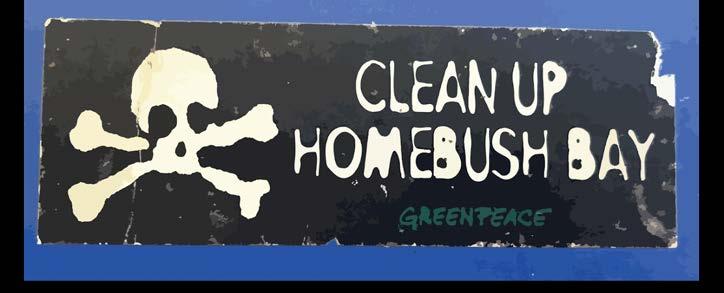
Mum got the sticker after a Greenpeace investigation into dioxin poisoning in Homebush Bay. She tells me, “It was a big thing pre-Olympics when I was in about Year 11 from memory.”
Unsurprisingly, as Homebush Bay was thrust onto the international stage following Sydney’s successful bid to host the 2000 Olympic Games, the extent of its environmental degradation received newfound attention.
This put into motion a decades-long clean-up effort aimed at decontaminating and remediating the area.
A spokesperson from the NSW Environmental Protection Authority (EPA) explained the decontamination process to Honi.
The process began in the early 2000s with the NSW Government and other landowners planning the clean-up, which was conducted over six years, starting in 2005, by Thiess Ltd.
“Soils and sediments were treated using a technology called thermal desorption which separated organic contaminants from soils and then destroyed them using heat. The treated soils were replaced at the site,” the spokesperson said.
“The clean-up was the largest undertaken in Australia with over half a million tonnes of contaminated soil and sediments treated at the site. Some residual contamination remains in Homebush Bay sediments and specially engineered soil ‘encapsulation cells’ on the peninsula.”
In 2010, the NSW Government declared that Homebush Bay was safe to swim in (technically, anyway) in terms of the levels of dioxins in its waters.

However, the legacy of Union Carbide’s polluting Agent Orange production will not be totally absent from Sydney Harbour for decades. Dioxins have worked their way into aquatic sediment, and spread beyond Homebush Bay.
The Sydney Morning Herald reported in 2010 that dioxins had been found more than 10 kilometres upstream and downstream of the Rhodes Peninsula, including around Rozelle and further up the Parramatta River.
The government testing confirmed that these dioxins can be traced back to the Union Carbide factory, as the samples contained the specific combination of chemicals manufactured at Rhodes.
This area of contamination is too large for remediation efforts to occur, with the government instead opting to wait until sediment covers the contaminated area. Until that occurs — which could be several decades away — fish and crustaceans will continue to absorb dioxins, making it unsafe to consume fish caught west of the Sydney Harbour Bridge.
Lessons from Union Carbide
This pervasive ecological connection between Sydney’s waterways and the Vietnam War are illustrative.
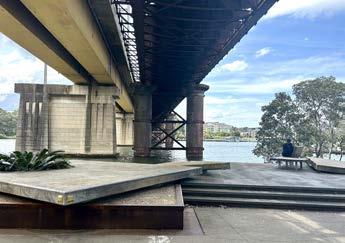
Most pertinently, the mass contamination of land tells a story of the ecological destruction that comes with conflict. Nature is a silenced casualty of war. While warzones face the brunt of destruction of land and biodiversity, degradation transcends the battlefront, poisoning land and hydrological systems around the world.
The stake of corporations in this destruction cannot be ignored. Companies like Union Carbide reaped enormous
profits from the volume of chemicals deployed in the Vietnam War. Yet Union Carbide simply departed Australia without ever being compelled to clean up the mess they left behind.
Sometimes, the ecological connection is also a human one. In the Australasian Journal of Ecocriticism and Cultural Ecology, Boi Huyen Ngo writes of the “haunting” of her family, Vietnamese migrants to Western Sydney, by the spectre of Agent Orange in their new homeland:
“Their migration experience traces a circular history of toxicity in which Agent Orange (as well as being manufactured in the USA) was also manufactured in Australia, released in Vietnam and contaminated Australia and Vietnam. The result is contamination in Australia, in Vietnam, and in the human bodies that inhabit both geopolitical spaces.”

We should not respond to ongoing presence — ecological, social, and spiritual — of dioxins in Sydney’s waterways passively. The flow of contamination through the Parramatta River is also an intertemporal flow, a long-present reminder of the perversity of past warfare.
As we wait for time to slowly bury the contaminated river bed, we should think about how warmongering in the present might linger in our systems into the future.
PHOTOGRAPHY BY ELLIE STEPHENSON
HONI SOIT WEEK ELEVEN 202226 | ENVIRONMENT
"Nature is a silenced casualty of war."
"This slice of Sydney Harbour is no stranger to Agent Orange."
A very cold war indeed Sam Randle
“I walked to a place from where I would be able to see the house, but there was something like a big cloud covering the whole city, and the cloud was growing and climbing up toward us… I could see nothing below. My grandmother started to cry, ‘Everybody is dead. This is the end of the world.’
— Sachiko Matsuo, Nagasaki survivor.
Today, the global nuclear weapons stockpile stands at 13,000 across nine countries, with five additional NATO member states hosting American missiles. Research by the Stockholm International Peace Research Institute also predicts these arsenals will increase this year for the first time in decades, due to the Russian invasion of Ukraine. As of 2020, the Bulletin of the Atomic Scientists’ Doomsday Clock stands at 100 seconds to midnight, the closest it has ever been.
In a televised national address in September, Russian President Vladimir Putin raised alarm bells by declaring: “If the territorial integrity of our country is threatened, we use all available means to protect our people — this is not a bluff.”
However, the threat of nuclear war extends beyond the immediate casualties of a nuclear conflict. In 1983, researchers at UC Berkeley started investigating the climatic impacts of nuclear war, giving birth to the controversial notion of ‘nuclear winter,’ a concept distinct from the more well-known nuclear Armageddon.
Nuclear winter may well follow Armageddon, but specifically points to a case of prolonged global climatic cooling caused by vast amounts of soot emitted into the atmosphere blocking solar radiation.
Building on the work from 1983, in 2007, researchers from Rutgers University New Brunswick modelled a range of regional nuclear conflict scenarios using modern climate simulation models. They found that just 100 Hiroshima-sized bombs would produce changes to climate unprecedented in human history. This represents just 0.8 per cent of the global nuclear arsenal; furthermore, today’s warheads are anywhere from 25–80 times more powerful than those used in WWII.

city high into the atmosphere. These firestorms create their own local weather patterns, making them burn hotter and longer. Many across the world stare as their cities are also set ablaze.
ART BY AIDAN ELWIG POLLOCK
the unprecedented diminishment of our food systems, even if a full-scale nuclear winter did not come to pass.
In the face of global warming, one might welcome a decrease in global temperatures. However, the outcome of such a scenario would cause a catastrophic collapse in agricultural output; in the first year of nuclear winter alone, billions would die from starvation.
Nuclear Armageddon (or nuclear holocaust), refers to an extinction or nearextinction level event whereby nuclear war leaves infrastructure annihilated, cities leveled, hundreds of millions dead, and radioactive fallout disrupting agricultural and water systems across the globe.
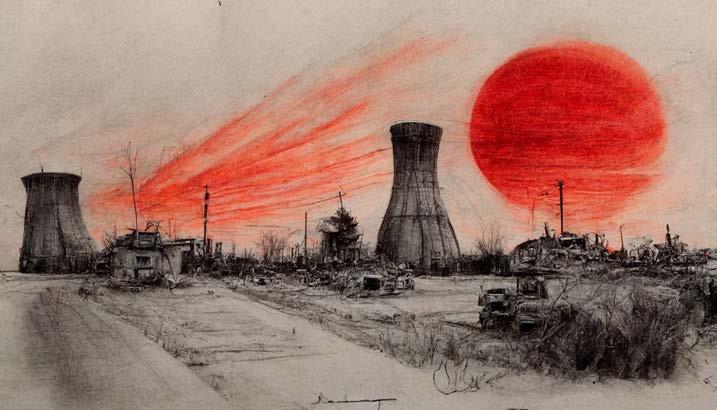
Picture this: standing in an open park in Parramatta, you see an 18 kilometrehigh mushroom cloud billowing over the Sydney CBD, the cloud reaching out to Strathfield. As the vacuum created by the blast collapses, winds of 320 km/h rush to the epicentre, and fires ignite to create a firestorm that sends the remains of our
One only needs to remember the 2019–20 Black Summer bushfires to imagine what the skies would look like. Over the course of two months, these bushfires launched one million tonnes of soot into the atmosphere. In this regional nuclear war scenario, such an experience would be widespread, with over five million tonnes emitted over the course of a day.
In the wake of the initial fallout, dark storm clouds would blanket our cities with black rain. Eventually, the skies would clear; unfortunately, the emitted aerosols would not. Superheated firestorms distribute significant volumes of carbon aerosols high into the atmosphere, where they would remain for up to ten years. We may not see them, but would endure their presence in other ways.
Within two years, surface air temperatures across the Australian east coast would drop between one and three degrees Celsius; meanwhile, South Australia would drop between two and four. Australian farmers would lose up to 20 days in their annual growing season. With similar collapses in output across the globe, such a scenario would cause
A full-scale nuclear winter scenario could be precipitated by an all-out war between Russia and the United States today, according to updated modelling from 2019. If the countries’ entire nuclear arsenals were deployed, over 150 million tonnes of soot would be sent into the atmosphere, causing surface air temperatures to drop by up to nine degrees Celsius.
Our civilisations and their social systems exist in delicate balance with the Earth’s natural systems. Like climate change, nuclear winter poses an existential threat to human civilisation as we know it. Both serve to remind us that our survival is intimately tied to climatological processes that can be violently disrupted — in just a moment, with nuclear war, or in slow motion, with continued fossil fuel use. In both instances, our political, economic, and social systems must adapt to prevent that disruption.
ART BY MIDJOURNEY
NUCLEAR| 27HONI SOIT WEEK ELEVEN 2022
”
Don your power armour and grab your gauss rifle, it’s time to wander the nuclear wasteland.
"the threat of nuclear war extends beyond the immediate casualties of a nuclear conflict"
"in the first year of nuclear winter alone, billions would die from starvation"
"you see an 18 kilometre high mushroom cloud billowing over the Sydney CBD"
President Lauren Lancaster.
As the year draws to an end I am getting a bit sentimental about writing these reports! It’s usually a task that I leave a little late and throw together (apologies to Honi, you are patient and benevolent), referring back to colourful Google calendar invites, email chains and lots and lots of facebook messages. I thought I would be more ahead of the curve this week but we are back on that same grind.
The highlight of the week was Thursday and Friday, which we spent on the pickets with the NTEU. The strike was staunch and constructive, with campus very very quiet and a number of new NTEU members joining familiar faces on the picket. The weather treated us very well as did a slap dash sausage sizzle again supplied by the MUA. I along with our
Education
Lia Perkins and Deaglan Godwin.
Hello! Somehow we have made it to our last report as Education Officers of the SRC. It has been a joy to organise the fight for better education with so many other students at USyd. Thank you to all of the EAG members who made this such a staunch, fighting year for the EAG.
A year ago the EAG held a student general meeting against course cuts, with over 200 students in attendance, chaired by Lia and with Deaglan speaking. We helped bring a large student contingent to the Invasion Day rally in the Domain at the start of the year, and hope to continue to prioritise Indigenous justice
very own General Secretary Alana, NTEU Branch Prez Nick Reimer and Publications Manager extraordinaire Mickie Quick took to the grill to feed the comrades prior to the second day speak out. Wandering to the Royal for a debrief after days in the sun felt melancholic - on the one hand I am always heartened at the expression of community and collective power that the strikes are, but I am also so angry and dismayed about the University’s incredible intransigence and refusal to compromise on the Union’s very reasonable set of enterprise agreement demands. There is likely to be further action taken by the Union both this semester and into next year and I expressed the SRC’s ongoing commitment to supporting all these efforts. As Lia takes the Presidency for next year I am confident in our ability to do so,
but in an ideal world the University comes to the table and we don’t necessaairly have to. Fingers crossed?
I also had UE Education on Monday, in which our application for SSAF base extensions was granted! With this approved, the Honi Soit editors stipend will be permanently doubled, we will get a new server and IT upgrade, a translation allowance, more hours for our Publications team, a social media intern position and a whole extra Caseworker position. I am so glad we can leave the organisation in a manifestly better position for next year.
I also met with our Admin manager, Lia and the outgoing GenSecs to discuss our SSAF application for 2023, which is just around the corner. We will be requesting a range of contestables like
a set of training modules for incoming councilors and executive, projects related to housing activism, FoodHub support / expansion, and more. After RepsElect this Wednesday evening I am looking forward to trialling the new exec by fire as they swoop in to help wrap up the application.
In other news, I went to Arts Ball on Tuesday - hilarious good time, did not touch the donut wall thanks very much. And I got accepted to the study abroad program at the University of Amsterdam next year! Lots to look forward to.
I hope your preparation for finals goes well, and that you take care of yourself! Go in the sun, eat veggies and get in touch if you’re having a hard time.
Final stretch of the year, let’s get it.
in our future activist work.
In Semester 1, our focus was sharply around the need for student support for the upcoming NTEU strikes at USyd. By this point, anyone reading the Education Officers report should be entirely aware of the demands of the strikes and the need for ongoing student support as they escalate to weaken management’s attack on our education.
Last week we participated in the 5th and 6th days of NTEU strikes this year, with pickets entirely preventing the usual operations of the University. The strike comes in the context of over
a year of negotiations, and six months of industrial action. Management have refused to budge an inch when it comes to the core demands of the union, despite having the money to pay for it- Honi recently exposed the ludicrous spending of uni executives on fine dining. Again, student support was important on all the picket lines, bolstering the numbers and energy. We thank every student who has turned up to the picket lines this year.
We and the EAG are not finished for the semester however! After the discovery of the cuts to units in FASS and Education, we have called a student
meeting on October 27 to oppose these cuts and organise the resistance to it. As we mentioned at the beginning of this report, student activism can defend our education, so we can encourage everyone to join us at the meeting and share your anger.
However, this is not a goodbye! Lia will have reports every week in Honi next year, and you can expect to see more encouragement to attend the strikes and other activism. And don’t worry, Deaglan’s anti-Liberal, pro-strike energy isn’t going anywhere.
Meeting of the Representatives-elect of the 95th Students’ Representative Council
A meeting of Representatives-elect of the 95th SRC will be held on Wednesday 19th October at 5pm, Eastern Avenue Auditorium and via Zoom (the link is provided at srcusyd.net.au/elections)
The following positions are open to nomination from members of the undergraduate student body:
Vice-President
General Secretary
Two Education Officer
Two Wom*n’s Officer
Four Disabilities and Carers Officers
Four Environment Officers
Four Ethno-Cultural Officers
Four Global Solidarity Officers
Four First Nations Officers
Four Inter-Campus Officers
Two Inter-Campus Committee members*
Four Interfaith Officers
Four International Students’ Officers
Four Mature-Age Students’ Officers
Four Queer Officers
Four Refugee Rights Officers
Authorised by R.Scanlan 2022 SRC Electoral Officer, Students’ Representative Council,

Sydney
Four Residential College Officers
Four Sexual Harassment Officers
Four Social Justice Officers
Two Standing Legal Committee members*
Four Student Housing Officers
Four Welfare Officers
Chairperson of the Standing Legal Committee
Six Directors of Student Publications (DSP)
The following positions are open to nomination from representatives of the 95th Council:
Five Executive members
*must be a member of council.
To be considered you must be either an elected representative, an office bearer an ex officio member.
REPS-ELECT Meeting
Positions in italic cannot be shared (SRC Regulations Part One Section 3d). All other positions may be split ONCE only (Part One Section 3c).
Nominations shall be taken from the floor at the meeting. However, nomination forms may be submitted in advance online at: srcusyd.net.au/elections
Descriptions of positions are found within the Regulations of the SRC available on the SRC website: srcusyd.net.au/about-us/constitution-regulations
Note: Part One Section 4b. states:
Where an Officer position is split and shared between two members of the student body it shall only be considered held by a woman, for the purposes of Part 1 Section 4 (a) of the Regulations, if both of the joining members of the student body do not identify as cis-males.
HONI SOIT WEEK ELEVEN 202228 | SRC
Students’ Representative Council, University of Sydney
University of
p: 02 9660 5222 | w: srcusyd.net.au
New rules for Discontinuing a subject

Ask Abe
SRC caseworker help Q&A

Preparing for Exams
Dear Abe,
I’ve got a big take home exam coming up and I’m really nervous that I won’t be able to answer all the parts of the question. Is there someone who can help me?
Thanks Exam Nervous
Sometimes, life brings unexpected circumstances that completely impact our ability to study or complete assessments. If you are unable to complete a unit of study you may be able to withdraw during semester for a Discontinue Fail (DF) grade. If special circumstances exist you can try applying for a Discontinue Not Fail (DC) grade.

A DF will affect your progression status, the same as any other fail grade, but does not affect your WAM. It is a good idea to check this with your faculty before applying for a DF. The DC (discontinue not fail) grade is for subjects you cannot complete due to “special circumstances”. This process is referred to as ‘late discontinuation under special circumstances’. It does not affect your WAM or your progression status (show good cause) and will get you a refund of your HECS/fees.

The application process for a DC is complex and nuanced, so we encourage all applicants to check their draft application with an SRC Caseworker.
If you had a serious illness, injury, or misadventure that was out of your control, that began or became worse after the census date (31 March for semester 1 and 31 August for semester 2) and severely impacted your ability to study, you can apply for a late discontinuation under special circumstances (DC). You will need to show that you were engaging with the subject, e.g., attending classes and submitting assessments, before you became sick or had the misadventure. If you missed any assessments, you will need to show that you applied for special consideration. In your application explain how your illness or misadventure impacted on your study, e.g., you couldn’t attend class or complete an assessment, and provide formal, third-party supporting
documentation (e.g., a Professional Practitioner’s Certificate) from a GP, counsellor or other relevant professional. Ask them to focus on how you were impacted, rather than an actual diagnosis.
The dates that you were impacted need to be from the date the illness, injury or misadventure began (or worsened) during semester. You need to demonstrate the circumstances weren’t known, or fully impacting on your studies until after census date. It needs to cover the period up until the date you applied. The severity of the impact needs to show that you were “very severely affected” or “totally unable to study”. There are only a few, very limited, situations where you can use a Statutory Declaration or Student Declaration in lieu of a professional’s documentation. If you are seeking a DC from only some of your subjects, your application and supporting documents will also need to explain why you couldn’t complete these subjects but could complete the others. It is harder to get a DC if you apply after results are published, so apply as soon as possible. If your DC is approved, you will automatically receive a refund of your HECs/fees.
A DC grade does not affect your progression status or your WAM. A DF will affect your status and may but will not affect your WAM. Domestic students who started their course after 1 January 2022 are subject to the rules of the Job Ready Graduate Package, where failure to achieve satisfactory progression may lead to being removed from your Commonwealth supported place, that is, kicked off HECS.
Reducing your study load either through a DF or a DC may also have consequences for international students or students on Centrelink payments. Becoming a part-time student will also mean you cannot use a concession Opal card.
The application process for a DC is complex and nuanced, so we encourage all applicants to check their draft application with an SRC Caseworker.
Dear Exam Nervous,
The best place to start is with your lecturer or tutor. Ask them if they
can guide you on what topics will be included in the essay. Carefully read the marking rubric to get an idea of what they expect from you. Look at the online resources and workshops that are available through the Learning Hub to develop skills that will help you to carefully read the exam question and plan your answer effectively. The library is running a series of events through the Exam Ready program. All of these services are available to you for free.
Thanks Abe
SRC CASEWORKER HELP | 29HONI SOIT WEEK ELEVEN 2022
For more information & links see: sydney.edu.au/students/exams
Do you have a legal problem? We can help you for FREE!* * this service is available to USYD undergraduate students and cases that meet eligible criteria Civil Rights Court Appearances Immigration & Visa Referrals Police Matters ...and more Student Advocacy Level 1, Wentworth Building (G01), University of Sydney NSW 2006 PO Box 794 Broadway NSW 2007 p: 02 9660 5222 int: 12871 w: srcusyd.net.au SRC LEGAL SERVICE APPOINTMENTS ARE AVAILABLE BY PHONE OR ONLINE For more information & links see: srcusyd.net.au/src-help/academic-issues/ discontinue-not-fail-dc
Cryptic
Quiz
Across Down
Puzzles and Quiz by Some Hack and MissEelKink.
Across Down
1. Organiser of Los Angeles, California used to announce that the beast is from South America (6)
4. Misery in noisy cruise causes a series of religious conflicts (8)
9. Angelo iterates discreetly while standing around (6)
10. It preserves our food, and our firstborns. It tends to our wounded, it governs the sun - it leads our nation (8)
12. A wet toilet: the final setback for Napoleon (8)
13. Not more than an ambient tango (2,4)
15. Germany in 24 hours will battle in France (4)
16. Reddit atheist believes in this conflict to bring change (10)
19. African country leads global network to decapitate France’s leaders that define evil (10)
20. Alpha Lima Papa Hotel Alpha Bravo Echo Tango? (4)
23. The French soldier operating Army unit (6)
25. See pirate leaving India ravaged and apart (8)
27. Attempt ingestion shown as alluring (8)
28. Crooked and edgy Sherlock smokes weed (6)
29. Drunken Castro loses direction and identity, ends in a terrible act! (8)
30. Ben without heading sent the last two letters to me, regarding protein (6)
1. Permitted noisy sounds (7)
2. Decorate party for war game (9)
3. Cuban Leader, ends war with Rebel Leader, Yank and Red (6)
5. Smelly aroma endlessly travels around (4)
6. EU aborts plans for destroyer (8)
7. Vagrant or red revolutionary? (5)
8. Old battler’s baths are brown (7)
11. Poor GI swaps sides and turns evil (4,3)
14. Token voter abandons middle ground and embraces ultra conservative, hateful dictator (7)
17. Poor state, does things wrong (2,1,3,3)
18. Nostalgic learner goes to become skeptic (8)
19. Civilian army raises Milan: it is abandoning Naples borders (7)
21. Tired of moisture, thunder is long delayed (7)
22. Resist an open conflict in the 90s (6)
24. Call of Duty player shouts at queer mother (5)
26. Tie measures speed (4)
Answers
Answers available at honisoit.com/puzzle-answers



HONI SOIT WEEK ELEVEN 202230 | PUZZLES
Crossword Quick Crossword 1. In Alice in Wonderland, the titular character Alice finds card soldiers paining what flower red to appease the Queen of Hearts? 2. Giving its title to a Marilyn Monroe film what proverbial itch describes the period in which happiness in a romantic relationship declines? 3. What word can precede both “play” and “chisel” to create band names? 4. What is the most populous country that starts with one of the last 5 letters in the English alphabet? 5. According to the three world model established by Alfred Sauvy, the Soviet Union and China were both classified as what kind of countries? 6. What connects the previous answers?
1. Commonly confused with a llama (6) 4. War in eight instalments (8) 9. Hang (6) 10. Location of the Australian War Memorial (8) 12. Battle of the Napoleonic Wars (8) 13. Not more than (2,4) 15. WW2 Battle (4) 16. Russian, French, Industrial (10) 19. Malice (10) 20. Russia’s potential sparring partner in WW3 (4) 23. Roman army unit (6) 25. What Yugoslavia did after 22-down conflict (8) 27. Attractive (8) 28. Biased (6) 29. Many occur during wartime (8) 30. Proteins that help speed up metabolism, or the chemical reactions in our bodies (6) 1. Authorised (7) 2. Colourful, warlike sport (9) 3. Tom Holland war film that shares its’ name with a fruit (6) 5. Wander (4) 6. Wartime Alfred Hitchcock film, about someone who commits sabotage (8) 7. Aussie bum (5) 8. Legendary warriors in Halo and Greek history (7) 11. Spoiled (4,3) 14. Ticket (7) 17. How one might describe a country being ravaged by war (2,1,3,3) 18. Centrist in the debate about whether there is or not a God (8) 19. Civic military force (7) 21. Long time coming (7) 22. Conflict that ended Europe s longest period of peace (6) 24. Plays Battlefield (5) 26. Windsor, bowline, figure-eight (4)
Note: Crosswords answers are identical across grids, choose your preferred style.
private arsenal!
The End TimesThe End Times
Anti-Truth. People’s Republic of USyd. $6.90
STRIKEBREAKER SPEAKS: “THE NTEU SOLD MY ORGANS ON THE BLACK MARKET”
O ne brave strikebreaker at the University of Sydney has spoken out about the nefarious activities of the National Tertiary Education Union, accusing organisers of illegally procuring and trading his kidneys.
Colin Mialaia sat down with The End Times to discuss the traumatic event.

“I was scrambling over the iron spikes of the Victoria Park fence to attend my Zoom class on jurisprudence at the Lawbry. Suddenly, I got skewered. As I bled out, a roaming picket removed me from the fence and carried me to the Anderson Stuart building. I woke up on an ominous sandstone table in the
depths of the building to the overwhelming stench of formaldehyde. I saw one of my kidneys floating in a jar next to my head.”
Mialaia then noticed a frequent USyd Rants commenter looming out in the darkened room. He recalls that they told him, “we wanted to excise your brain too, but we couldn’t find it.”
Terrified, Mialaia ran screaming back to his dorm in St John’s college, but not before hearing the ominous words: “we will donate the proceeds to the strike fund.”
“It just goes to show: civil discourse and negotiation really is dead.”
ELEVENTH HOUR CANDIDATE CONTESTS SULS PRESIDENT RACE
Name: Allan Freehill

Degree: Business/ LLB IV
Faction: Independent
Ticket name: Action with Allan Quiz Score: 69%

Doomed Honorary degrees
Pebbles
Sublets
Poor vision
Tucked shirts SPF 30 Incense
Cocktails
Destined Honours degrees Soil Abstinence Khaki Handkerchiefs Hats Washing powder Ouid
IN THIS ISSUE:
No fly zone declared over quad after tourist’s drone crashes wedding - Ellie Copta
Fourth year law student Allan Freehill has dived headfirst into student politics in an unprecedented late entry to the race for Sydney University Law Society (SULS) President.
Freehill, who described his politics as “socially progressive, economically conservative”, is running with an ambitious set of policies that seek to overhaul the University’s richest society.
TO INSTALL HELIPAD ON F23 BUILDING
LOCAL BISEXUAL WOMAN ELECTED ON PLATFORM OF FREE IRON TABLETS AT USU EVENTS: “FUN, FERROUS, AND ACTUALLY LEFT-WING”
I n a rare contested election at the University of Sydney, Arts II student Annie Mia (Switch) was the final candidate elected off the back of preferences.
“I’ve been.. We’ve all been asleep at the wheel when it comes
to the epidemic of chronic fatigue amongst our undergraduate populous,” said Mia in her preelection interview with The End Times
“It’s time we injected some new life, and iron, into campus.”
WOMEN IN STEM: GABI STRICKER-PHELPS DEVELOPS WORLD-FIRST INVISIBILITY CLOAK
The Finance major explained his separatist plan to establish the Law School as a separate institution to the University. “Why should my student money go to subsidising idiotic pursuits like the dramatic arts, when Negotiations Comps exist?”
Freehill also promised to establish a special taskforce to shoot vexatious New Law shitters on sight.
Pick your audience: Man three cocktails deep at State Library rooftop bar takes brave prohomophobia stance - Psy Dye
Demilitarised zone declared in PNR after gay arts students launch annexation - Millie Shar
USU Board imprisoned unsuccessful candidates in Holme basement, probe finds - Lachy Keynes
Why you should strike! - Tenpin Boleyn
PRESENT AT NEAREST CONSCRIPTION OFFICE FOR FREE BONE SPUR
ASK ANNAMARIE: MY GIRLFRIEND IS A UNION MEMBER AND I’M DEVASTATED
Dear Annamarie,
I’ve recently had some bad relationship news. I (28F) am a devoted casual staff member in the Department of Gender and Cultural Studies. My girlfriend (23F), let’s call her Norma, also works for the University, albeit in the more epistemologically myopic discipline of Political Economy.
Recently, we were cuddling on the couch devouring our battered copy of ‘Orgasmology’ , when a strange notification popped up on our Commonwealth Bank app. NTEU dues? I looked at her, and gestured wordlessly. She said ‘staff working conditions are student learning conditions’, and I said, ‘we know that, which is why the University is offering to maintain and enhance their sector-leading conditions.’ She called me a scab and hasn’t talked to me since that night, although she did let me through the picket line on Thursday which I took to be a good sign.
Any advice?
Hi devoted casual,
In the mostly queerish, mostly progressive circles in which I work and play, couples abound.
An influential line of queer thinking more often than not takes the couple as shorthand for the normative, and therefore politically quiescent. However, I am here to say you ought not to be political quiescent.
The uniqueness of the queer couple form allows you to explore alternative trajectories and overcome fixed and ossified realities: by which I mean, do not join your union nor feel sucked into the interpellative moment (however attractive) the NTEU seeks to foster.
As for your girlfriend, she’ll come around — keep fighting the good fight.
Jagose x
COMEDY | 31HONI SOIT WEEK ELEVEN 2022
UNIVERSITY
Incoherent. Always. EXCLUSIVE: Inside Belinda Hutchinson’s
Wed October 19 Vol. 420 + 24 Cheaper and more available than toilet paper! The only newspaper. Proudly Murdoch. Pro-News.
M ark Scott has signed a Memorandum of Understanding with French weapons company Thales in a
move aimed at “diversifying the University’s airspace and moving into the aerial sphere.”
I ’ve been completely transparent,” an Easternsuburbs accent said from, uh, somewhere over there.
Or was it over there?
“









 Ellie Stephenson
Ellie Stephenson
















 (L-R) GREG WAITE: GEORGE GITTOES IN HIS ‘PUPPET ROOM’ AT THE YELLOW HOUSE KINGS CROSS GEORGE GITTOES: AGENT ORANGE
(L-R) GREG WAITE: GEORGE GITTOES IN HIS ‘PUPPET ROOM’ AT THE YELLOW HOUSE KINGS CROSS GEORGE GITTOES: AGENT ORANGE





















































